Hotel Marketing Strategy Development
VerifiedAdded on 2020/10/22
|43
|8003
|450
AI Summary
This assignment requires developing a comprehensive hotel marketing strategy for Diamond Hotel. It involves analyzing the seven functions of marketing, creating a customer database, maintaining relationships with patrons, and implementing customer care policies. The goal is to restore the hotel economy and ensure its continued growth amidst the COVID-19 pandemic's impact on the tourism industry.
Contribute Materials
Your contribution can guide someone’s learning journey. Share your
documents today.
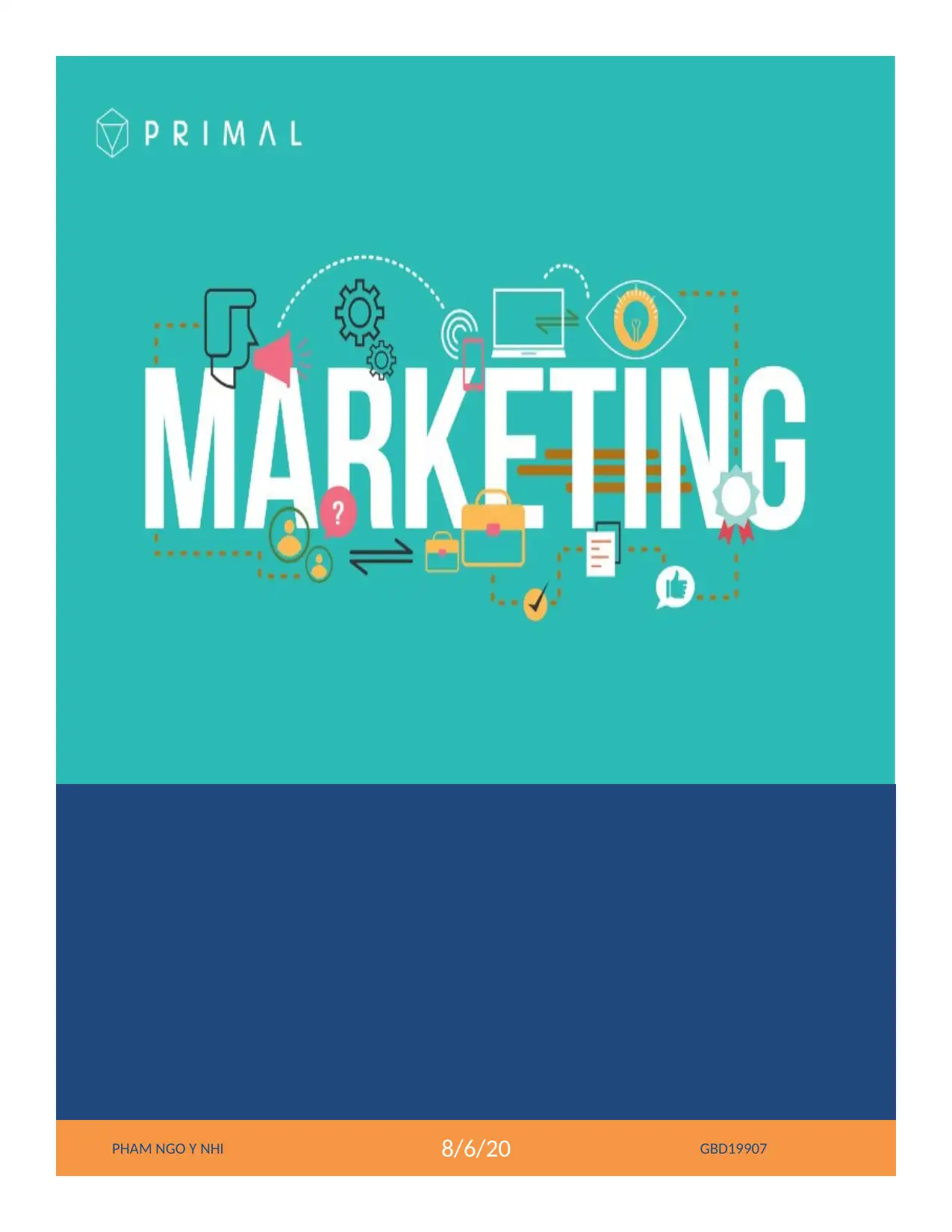
ASSIGNMENT 1
PHAM NGO Y NHI 8/6/20 GBD19907
PHAM NGO Y NHI 8/6/20 GBD19907
Secure Best Marks with AI Grader
Need help grading? Try our AI Grader for instant feedback on your assignments.
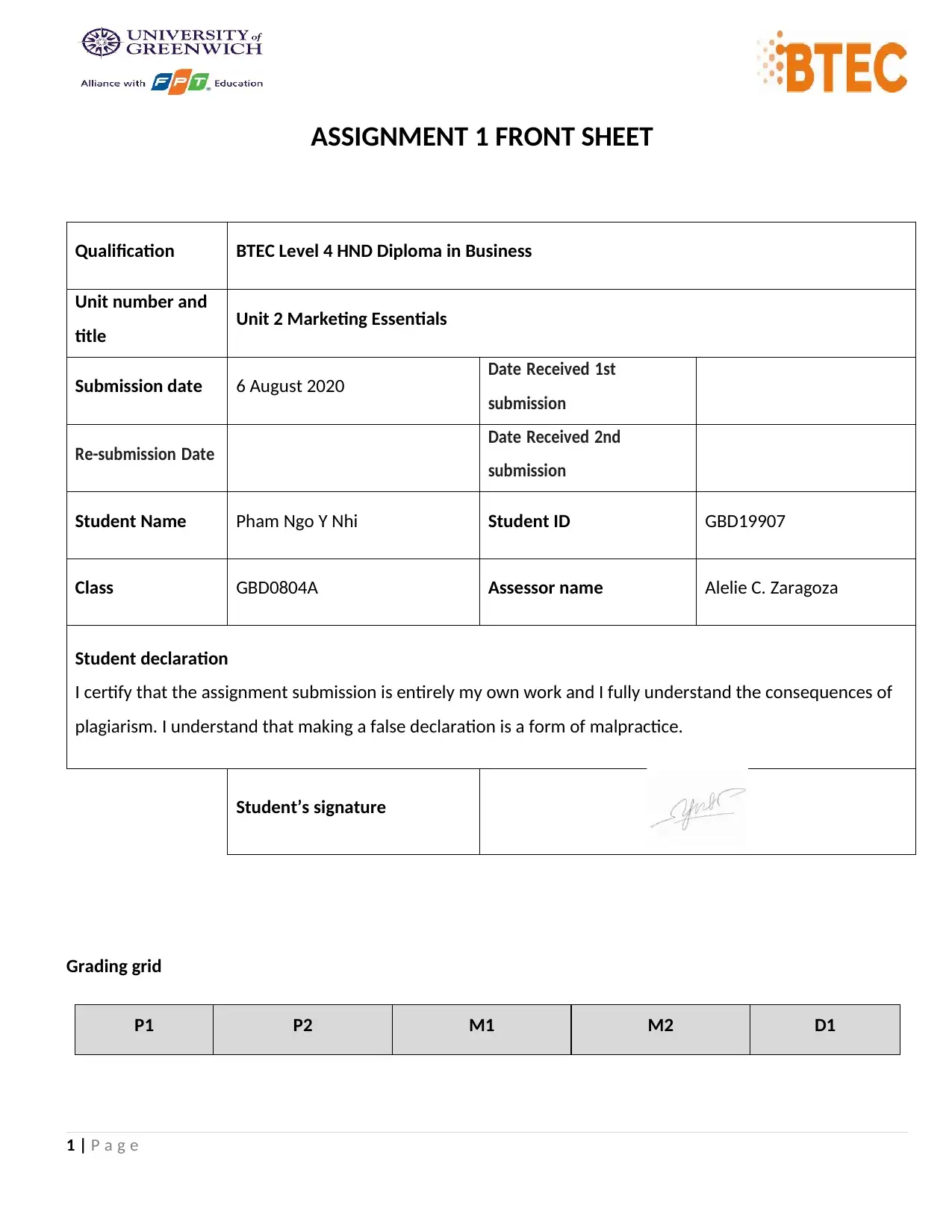
ASSIGNMENT 1 FRONT SHEET
Qualification BTEC Level 4 HND Diploma in Business
Unit number and
title Unit 2 Marketing Essentials
Submission date 6 August 2020 Date Received 1st
submission
Re-submission Date Date Received 2nd
submission
Student Name Pham Ngo Y Nhi Student ID GBD19907
Class GBD0804A Assessor name Alelie C. Zaragoza
Student declaration
I certify that the assignment submission is entirely my own work and I fully understand the consequences of
plagiarism. I understand that making a false declaration is a form of malpractice.
Student’s signature
Grading grid
P1 P2 M1 M2 D1
1 | P a g e
Qualification BTEC Level 4 HND Diploma in Business
Unit number and
title Unit 2 Marketing Essentials
Submission date 6 August 2020 Date Received 1st
submission
Re-submission Date Date Received 2nd
submission
Student Name Pham Ngo Y Nhi Student ID GBD19907
Class GBD0804A Assessor name Alelie C. Zaragoza
Student declaration
I certify that the assignment submission is entirely my own work and I fully understand the consequences of
plagiarism. I understand that making a false declaration is a form of malpractice.
Student’s signature
Grading grid
P1 P2 M1 M2 D1
1 | P a g e

2 | P a g e
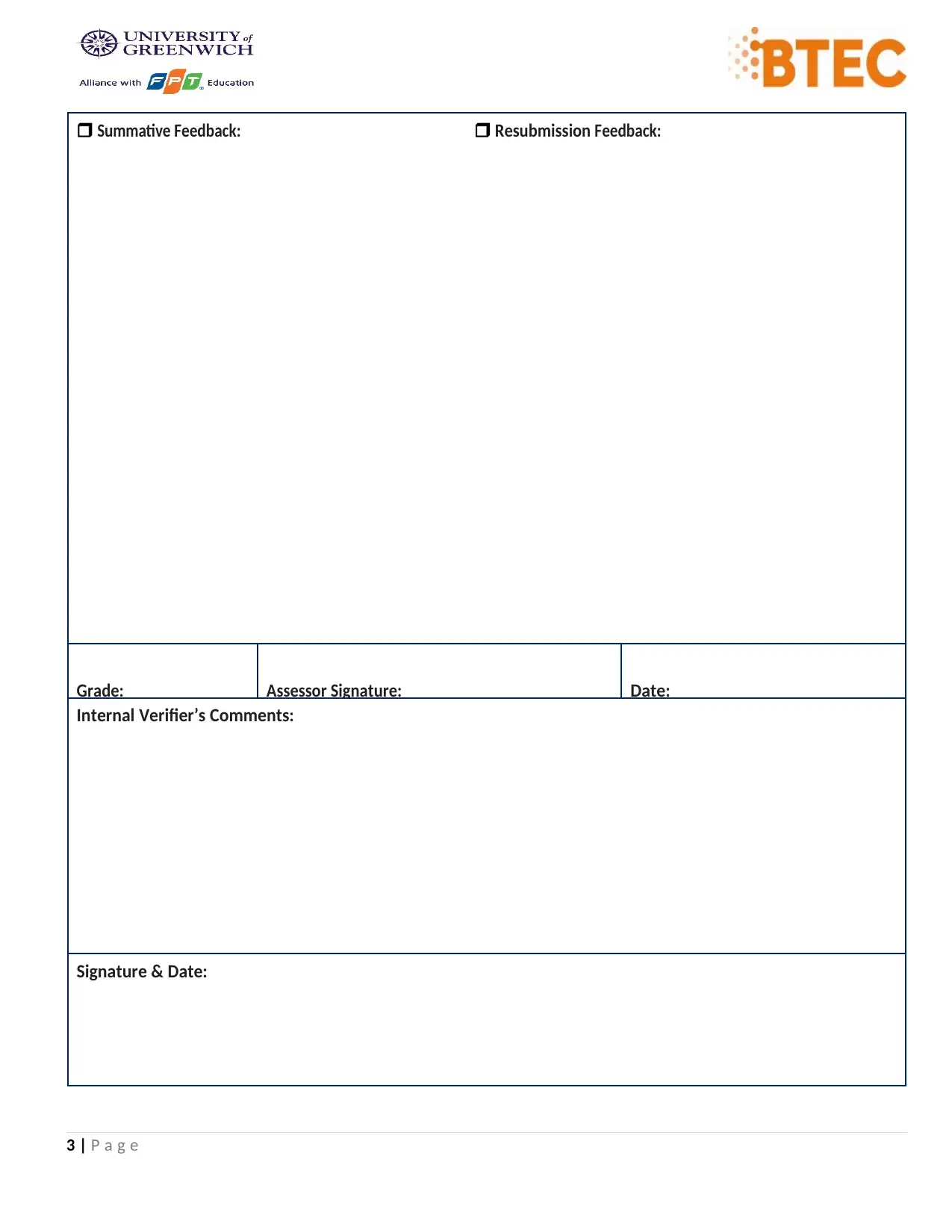
Summative Feedback: Resubmission Feedback:
Grade: Assessor Signature: Date:
Internal Verifier’s Comments:
Signature & Date:
3 | P a g e
Grade: Assessor Signature: Date:
Internal Verifier’s Comments:
Signature & Date:
3 | P a g e
Secure Best Marks with AI Grader
Need help grading? Try our AI Grader for instant feedback on your assignments.
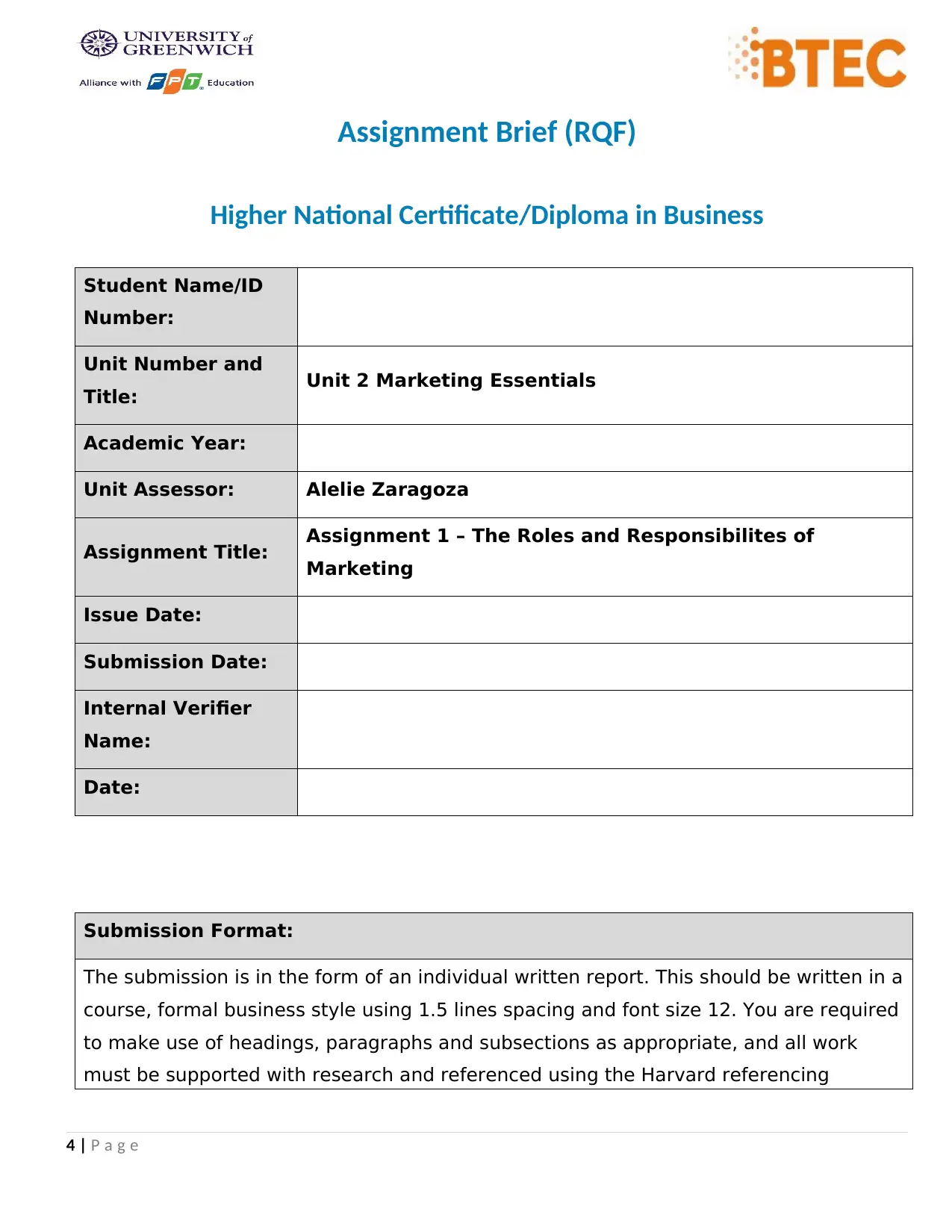
Assignment Brief (RQF)
Higher National Certificate/Diploma in Business
Student Name/ID
Number:
Unit Number and
Title: Unit 2 Marketing Essentials
Academic Year:
Unit Assessor: Alelie Zaragoza
Assignment Title: Assignment 1 – The Roles and Responsibilites of
Marketing
Issue Date:
Submission Date:
Internal Verifier
Name:
Date:
Submission Format:
The submission is in the form of an individual written report. This should be written in a
course, formal business style using 1.5 lines spacing and font size 12. You are required
to make use of headings, paragraphs and subsections as appropriate, and all work
must be supported with research and referenced using the Harvard referencing
4 | P a g e
Higher National Certificate/Diploma in Business
Student Name/ID
Number:
Unit Number and
Title: Unit 2 Marketing Essentials
Academic Year:
Unit Assessor: Alelie Zaragoza
Assignment Title: Assignment 1 – The Roles and Responsibilites of
Marketing
Issue Date:
Submission Date:
Internal Verifier
Name:
Date:
Submission Format:
The submission is in the form of an individual written report. This should be written in a
course, formal business style using 1.5 lines spacing and font size 12. You are required
to make use of headings, paragraphs and subsections as appropriate, and all work
must be supported with research and referenced using the Harvard referencing
4 | P a g e
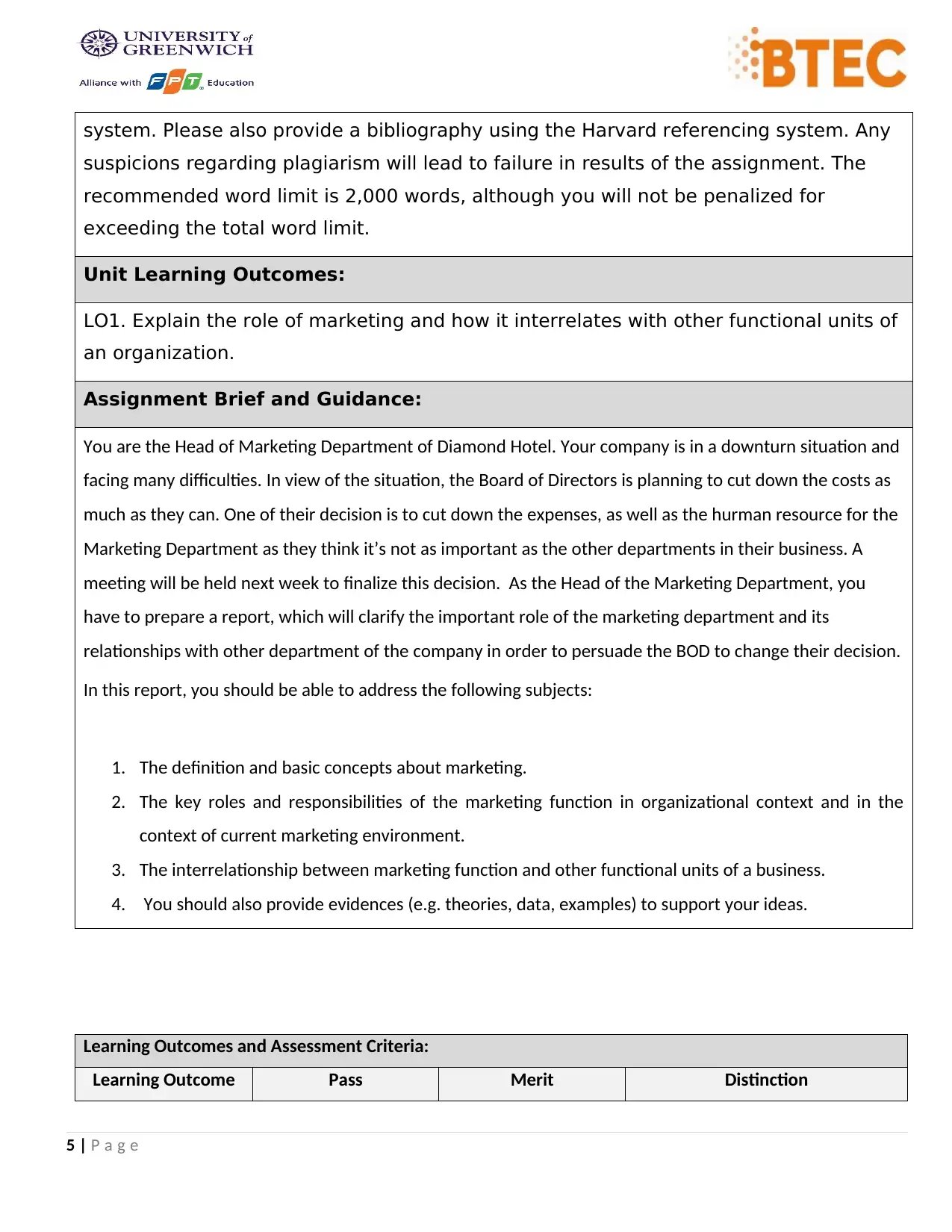
system. Please also provide a bibliography using the Harvard referencing system. Any
suspicions regarding plagiarism will lead to failure in results of the assignment. The
recommended word limit is 2,000 words, although you will not be penalized for
exceeding the total word limit.
Unit Learning Outcomes:
LO1. Explain the role of marketing and how it interrelates with other functional units of
an organization.
Assignment Brief and Guidance:
You are the Head of Marketing Department of Diamond Hotel. Your company is in a downturn situation and
facing many difficulties. In view of the situation, the Board of Directors is planning to cut down the costs as
much as they can. One of their decision is to cut down the expenses, as well as the hurman resource for the
Marketing Department as they think it’s not as important as the other departments in their business. A
meeting will be held next week to finalize this decision. As the Head of the Marketing Department, you
have to prepare a report, which will clarify the important role of the marketing department and its
relationships with other department of the company in order to persuade the BOD to change their decision.
In this report, you should be able to address the following subjects:
1. The definition and basic concepts about marketing.
2. The key roles and responsibilities of the marketing function in organizational context and in the
context of current marketing environment.
3. The interrelationship between marketing function and other functional units of a business.
4. You should also provide evidences (e.g. theories, data, examples) to support your ideas.
Learning Outcomes and Assessment Criteria:
Learning Outcome Pass Merit Distinction
5 | P a g e
suspicions regarding plagiarism will lead to failure in results of the assignment. The
recommended word limit is 2,000 words, although you will not be penalized for
exceeding the total word limit.
Unit Learning Outcomes:
LO1. Explain the role of marketing and how it interrelates with other functional units of
an organization.
Assignment Brief and Guidance:
You are the Head of Marketing Department of Diamond Hotel. Your company is in a downturn situation and
facing many difficulties. In view of the situation, the Board of Directors is planning to cut down the costs as
much as they can. One of their decision is to cut down the expenses, as well as the hurman resource for the
Marketing Department as they think it’s not as important as the other departments in their business. A
meeting will be held next week to finalize this decision. As the Head of the Marketing Department, you
have to prepare a report, which will clarify the important role of the marketing department and its
relationships with other department of the company in order to persuade the BOD to change their decision.
In this report, you should be able to address the following subjects:
1. The definition and basic concepts about marketing.
2. The key roles and responsibilities of the marketing function in organizational context and in the
context of current marketing environment.
3. The interrelationship between marketing function and other functional units of a business.
4. You should also provide evidences (e.g. theories, data, examples) to support your ideas.
Learning Outcomes and Assessment Criteria:
Learning Outcome Pass Merit Distinction
5 | P a g e
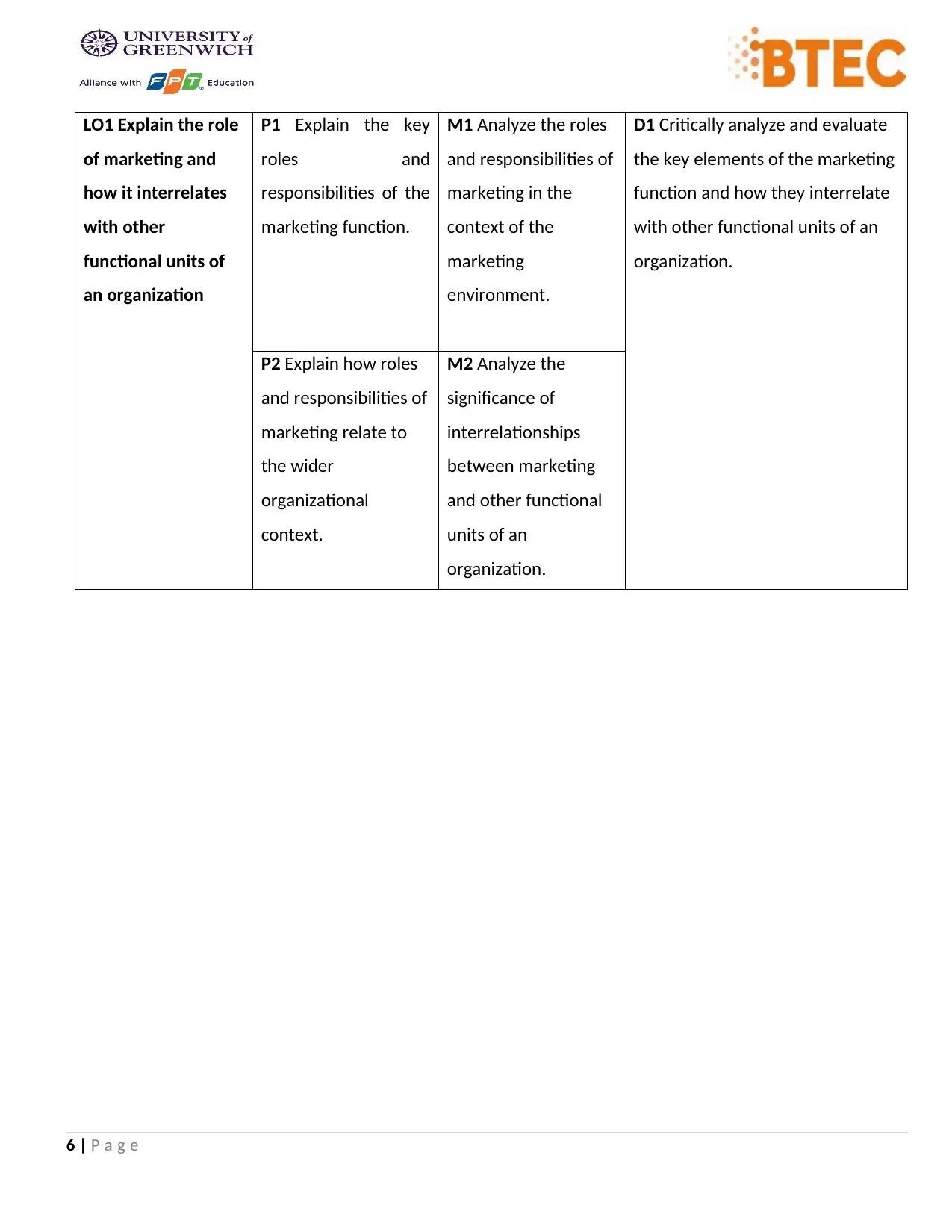
LO1 Explain the role
of marketing and
how it interrelates
with other
functional units of
an organization
P1 Explain the key
roles and
responsibilities of the
marketing function.
M1 Analyze the roles
and responsibilities of
marketing in the
context of the
marketing
environment.
D1 Critically analyze and evaluate
the key elements of the marketing
function and how they interrelate
with other functional units of an
organization.
P2 Explain how roles
and responsibilities of
marketing relate to
the wider
organizational
context.
M2 Analyze the
significance of
interrelationships
between marketing
and other functional
units of an
organization.
6 | P a g e
of marketing and
how it interrelates
with other
functional units of
an organization
P1 Explain the key
roles and
responsibilities of the
marketing function.
M1 Analyze the roles
and responsibilities of
marketing in the
context of the
marketing
environment.
D1 Critically analyze and evaluate
the key elements of the marketing
function and how they interrelate
with other functional units of an
organization.
P2 Explain how roles
and responsibilities of
marketing relate to
the wider
organizational
context.
M2 Analyze the
significance of
interrelationships
between marketing
and other functional
units of an
organization.
6 | P a g e
Paraphrase This Document
Need a fresh take? Get an instant paraphrase of this document with our AI Paraphraser
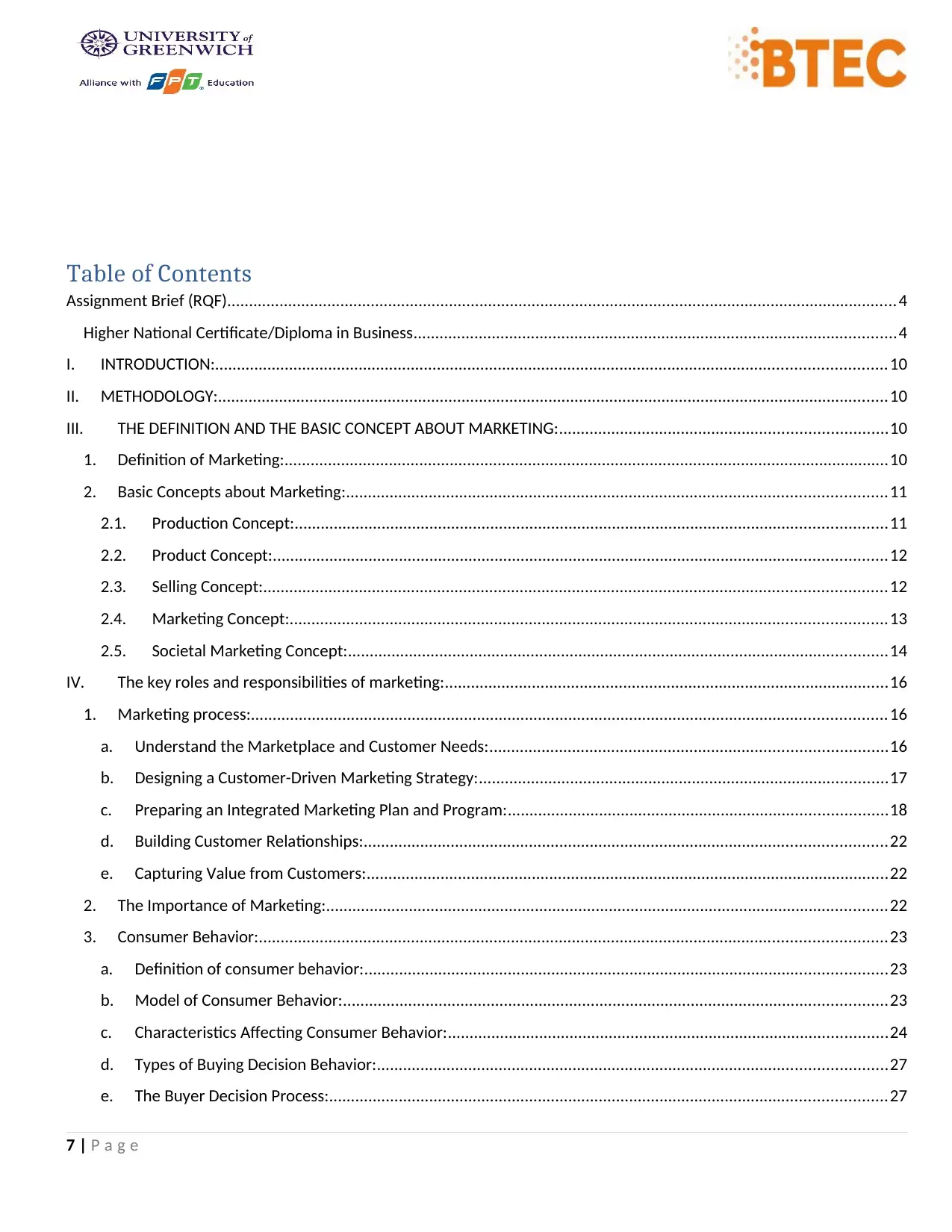
Table of Contents
Assignment Brief (RQF)..........................................................................................................................................................4
Higher National Certificate/Diploma in Business...............................................................................................................4
I. INTRODUCTION:..........................................................................................................................................................10
II. METHODOLOGY:..........................................................................................................................................................10
III. THE DEFINITION AND THE BASIC CONCEPT ABOUT MARKETING:...........................................................................10
1. Definition of Marketing:...........................................................................................................................................10
2. Basic Concepts about Marketing:............................................................................................................................11
2.1. Production Concept:........................................................................................................................................11
2.2. Product Concept:.............................................................................................................................................12
2.3. Selling Concept:...............................................................................................................................................12
2.4. Marketing Concept:.........................................................................................................................................13
2.5. Societal Marketing Concept:............................................................................................................................14
IV. The key roles and responsibilities of marketing:......................................................................................................16
1. Marketing process:..................................................................................................................................................16
a. Understand the Marketplace and Customer Needs:...........................................................................................16
b. Designing a Customer-Driven Marketing Strategy:..............................................................................................17
c. Preparing an Integrated Marketing Plan and Program:.......................................................................................18
d. Building Customer Relationships:........................................................................................................................22
e. Capturing Value from Customers:........................................................................................................................22
2. The Importance of Marketing:.................................................................................................................................22
3. Consumer Behavior:................................................................................................................................................23
a. Definition of consumer behavior:........................................................................................................................23
b. Model of Consumer Behavior:.............................................................................................................................23
c. Characteristics Affecting Consumer Behavior:.....................................................................................................24
d. Types of Buying Decision Behavior:.....................................................................................................................27
e. The Buyer Decision Process:................................................................................................................................27
7 | P a g e
Assignment Brief (RQF)..........................................................................................................................................................4
Higher National Certificate/Diploma in Business...............................................................................................................4
I. INTRODUCTION:..........................................................................................................................................................10
II. METHODOLOGY:..........................................................................................................................................................10
III. THE DEFINITION AND THE BASIC CONCEPT ABOUT MARKETING:...........................................................................10
1. Definition of Marketing:...........................................................................................................................................10
2. Basic Concepts about Marketing:............................................................................................................................11
2.1. Production Concept:........................................................................................................................................11
2.2. Product Concept:.............................................................................................................................................12
2.3. Selling Concept:...............................................................................................................................................12
2.4. Marketing Concept:.........................................................................................................................................13
2.5. Societal Marketing Concept:............................................................................................................................14
IV. The key roles and responsibilities of marketing:......................................................................................................16
1. Marketing process:..................................................................................................................................................16
a. Understand the Marketplace and Customer Needs:...........................................................................................16
b. Designing a Customer-Driven Marketing Strategy:..............................................................................................17
c. Preparing an Integrated Marketing Plan and Program:.......................................................................................18
d. Building Customer Relationships:........................................................................................................................22
e. Capturing Value from Customers:........................................................................................................................22
2. The Importance of Marketing:.................................................................................................................................22
3. Consumer Behavior:................................................................................................................................................23
a. Definition of consumer behavior:........................................................................................................................23
b. Model of Consumer Behavior:.............................................................................................................................23
c. Characteristics Affecting Consumer Behavior:.....................................................................................................24
d. Types of Buying Decision Behavior:.....................................................................................................................27
e. The Buyer Decision Process:................................................................................................................................27
7 | P a g e
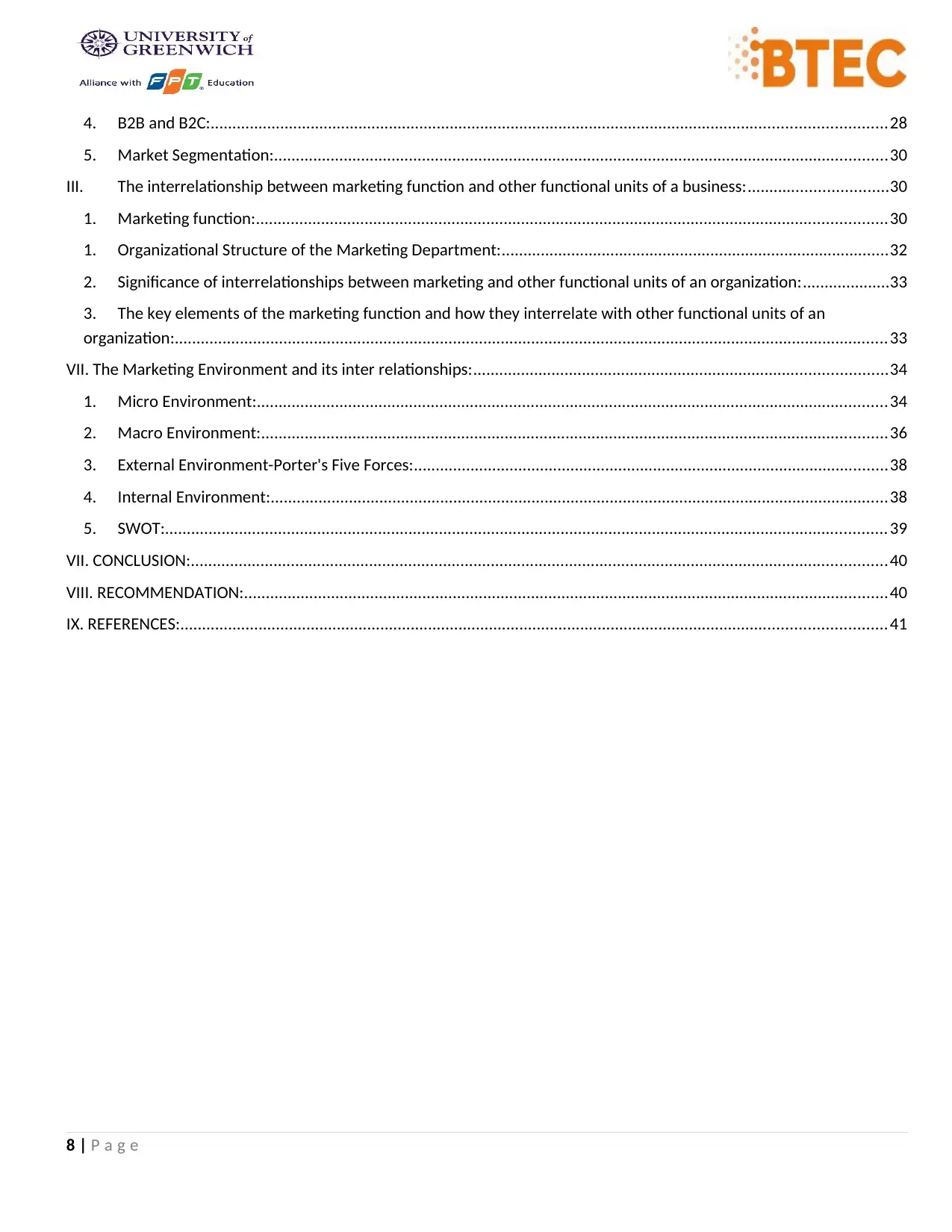
4. B2B and B2C:...........................................................................................................................................................28
5. Market Segmentation:.............................................................................................................................................30
III. The interrelationship between marketing function and other functional units of a business:................................30
1. Marketing function:.................................................................................................................................................30
1. Organizational Structure of the Marketing Department:.........................................................................................32
2. Significance of interrelationships between marketing and other functional units of an organization:....................33
3. The key elements of the marketing function and how they interrelate with other functional units of an
organization:....................................................................................................................................................................33
VII. The Marketing Environment and its inter relationships:...............................................................................................34
1. Micro Environment:.................................................................................................................................................34
2. Macro Environment:................................................................................................................................................36
3. External Environment-Porter's Five Forces:.............................................................................................................38
4. Internal Environment:..............................................................................................................................................38
5. SWOT:...................................................................................................................................................................... 39
VII. CONCLUSION:................................................................................................................................................................40
VIII. RECOMMENDATION:....................................................................................................................................................40
IX. REFERENCES:..................................................................................................................................................................41
8 | P a g e
5. Market Segmentation:.............................................................................................................................................30
III. The interrelationship between marketing function and other functional units of a business:................................30
1. Marketing function:.................................................................................................................................................30
1. Organizational Structure of the Marketing Department:.........................................................................................32
2. Significance of interrelationships between marketing and other functional units of an organization:....................33
3. The key elements of the marketing function and how they interrelate with other functional units of an
organization:....................................................................................................................................................................33
VII. The Marketing Environment and its inter relationships:...............................................................................................34
1. Micro Environment:.................................................................................................................................................34
2. Macro Environment:................................................................................................................................................36
3. External Environment-Porter's Five Forces:.............................................................................................................38
4. Internal Environment:..............................................................................................................................................38
5. SWOT:...................................................................................................................................................................... 39
VII. CONCLUSION:................................................................................................................................................................40
VIII. RECOMMENDATION:....................................................................................................................................................40
IX. REFERENCES:..................................................................................................................................................................41
8 | P a g e
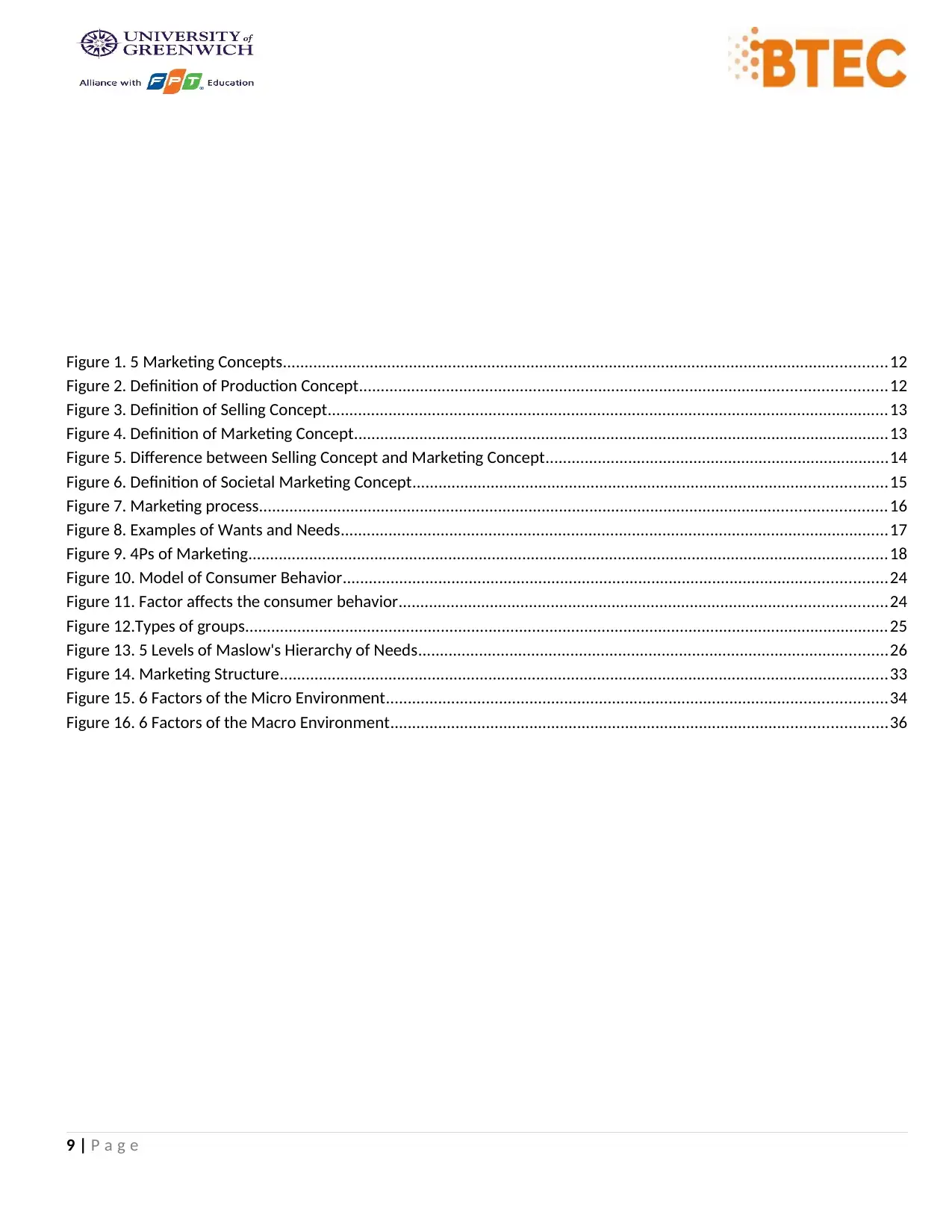
Figure 1. 5 Marketing Concepts...........................................................................................................................................12
Figure 2. Definition of Production Concept.........................................................................................................................12
Figure 3. Definition of Selling Concept.................................................................................................................................13
Figure 4. Definition of Marketing Concept...........................................................................................................................13
Figure 5. Difference between Selling Concept and Marketing Concept...............................................................................14
Figure 6. Definition of Societal Marketing Concept.............................................................................................................15
Figure 7. Marketing process................................................................................................................................................16
Figure 8. Examples of Wants and Needs..............................................................................................................................17
Figure 9. 4Ps of Marketing...................................................................................................................................................18
Figure 10. Model of Consumer Behavior.............................................................................................................................24
Figure 11. Factor affects the consumer behavior................................................................................................................24
Figure 12.Types of groups....................................................................................................................................................25
Figure 13. 5 Levels of Maslow's Hierarchy of Needs............................................................................................................26
Figure 14. Marketing Structure............................................................................................................................................33
Figure 15. 6 Factors of the Micro Environment...................................................................................................................34
Figure 16. 6 Factors of the Macro Environment..................................................................................................................36
9 | P a g e
Figure 2. Definition of Production Concept.........................................................................................................................12
Figure 3. Definition of Selling Concept.................................................................................................................................13
Figure 4. Definition of Marketing Concept...........................................................................................................................13
Figure 5. Difference between Selling Concept and Marketing Concept...............................................................................14
Figure 6. Definition of Societal Marketing Concept.............................................................................................................15
Figure 7. Marketing process................................................................................................................................................16
Figure 8. Examples of Wants and Needs..............................................................................................................................17
Figure 9. 4Ps of Marketing...................................................................................................................................................18
Figure 10. Model of Consumer Behavior.............................................................................................................................24
Figure 11. Factor affects the consumer behavior................................................................................................................24
Figure 12.Types of groups....................................................................................................................................................25
Figure 13. 5 Levels of Maslow's Hierarchy of Needs............................................................................................................26
Figure 14. Marketing Structure............................................................................................................................................33
Figure 15. 6 Factors of the Micro Environment...................................................................................................................34
Figure 16. 6 Factors of the Macro Environment..................................................................................................................36
9 | P a g e
Secure Best Marks with AI Grader
Need help grading? Try our AI Grader for instant feedback on your assignments.
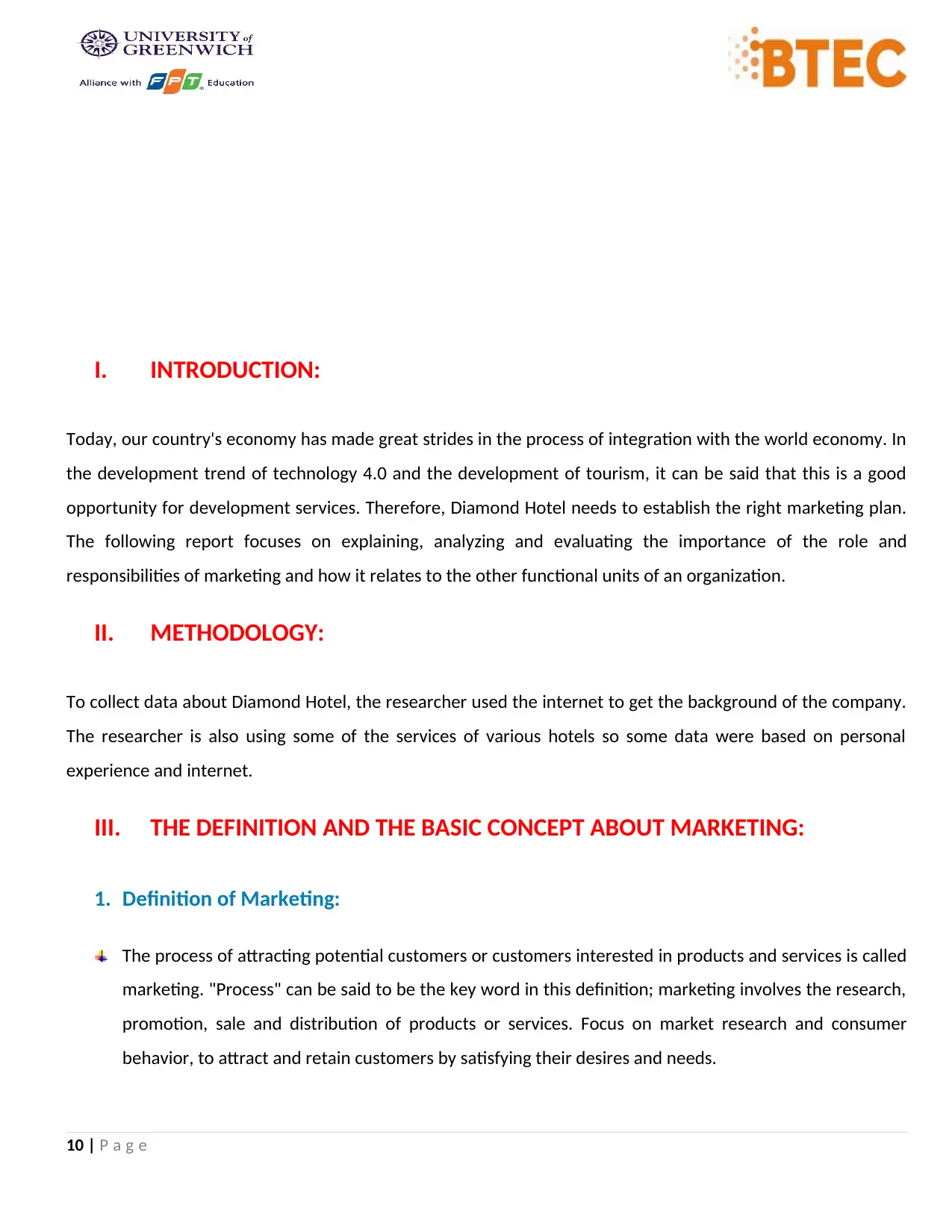
I. INTRODUCTION:
Today, our country's economy has made great strides in the process of integration with the world economy. In
the development trend of technology 4.0 and the development of tourism, it can be said that this is a good
opportunity for development services. Therefore, Diamond Hotel needs to establish the right marketing plan.
The following report focuses on explaining, analyzing and evaluating the importance of the role and
responsibilities of marketing and how it relates to the other functional units of an organization.
II. METHODOLOGY:
To collect data about Diamond Hotel, the researcher used the internet to get the background of the company.
The researcher is also using some of the services of various hotels so some data were based on personal
experience and internet.
III. THE DEFINITION AND THE BASIC CONCEPT ABOUT MARKETING:
1. Definition of Marketing:
The process of attracting potential customers or customers interested in products and services is called
marketing. "Process" can be said to be the key word in this definition; marketing involves the research,
promotion, sale and distribution of products or services. Focus on market research and consumer
behavior, to attract and retain customers by satisfying their desires and needs.
10 | P a g e
Today, our country's economy has made great strides in the process of integration with the world economy. In
the development trend of technology 4.0 and the development of tourism, it can be said that this is a good
opportunity for development services. Therefore, Diamond Hotel needs to establish the right marketing plan.
The following report focuses on explaining, analyzing and evaluating the importance of the role and
responsibilities of marketing and how it relates to the other functional units of an organization.
II. METHODOLOGY:
To collect data about Diamond Hotel, the researcher used the internet to get the background of the company.
The researcher is also using some of the services of various hotels so some data were based on personal
experience and internet.
III. THE DEFINITION AND THE BASIC CONCEPT ABOUT MARKETING:
1. Definition of Marketing:
The process of attracting potential customers or customers interested in products and services is called
marketing. "Process" can be said to be the key word in this definition; marketing involves the research,
promotion, sale and distribution of products or services. Focus on market research and consumer
behavior, to attract and retain customers by satisfying their desires and needs.
10 | P a g e
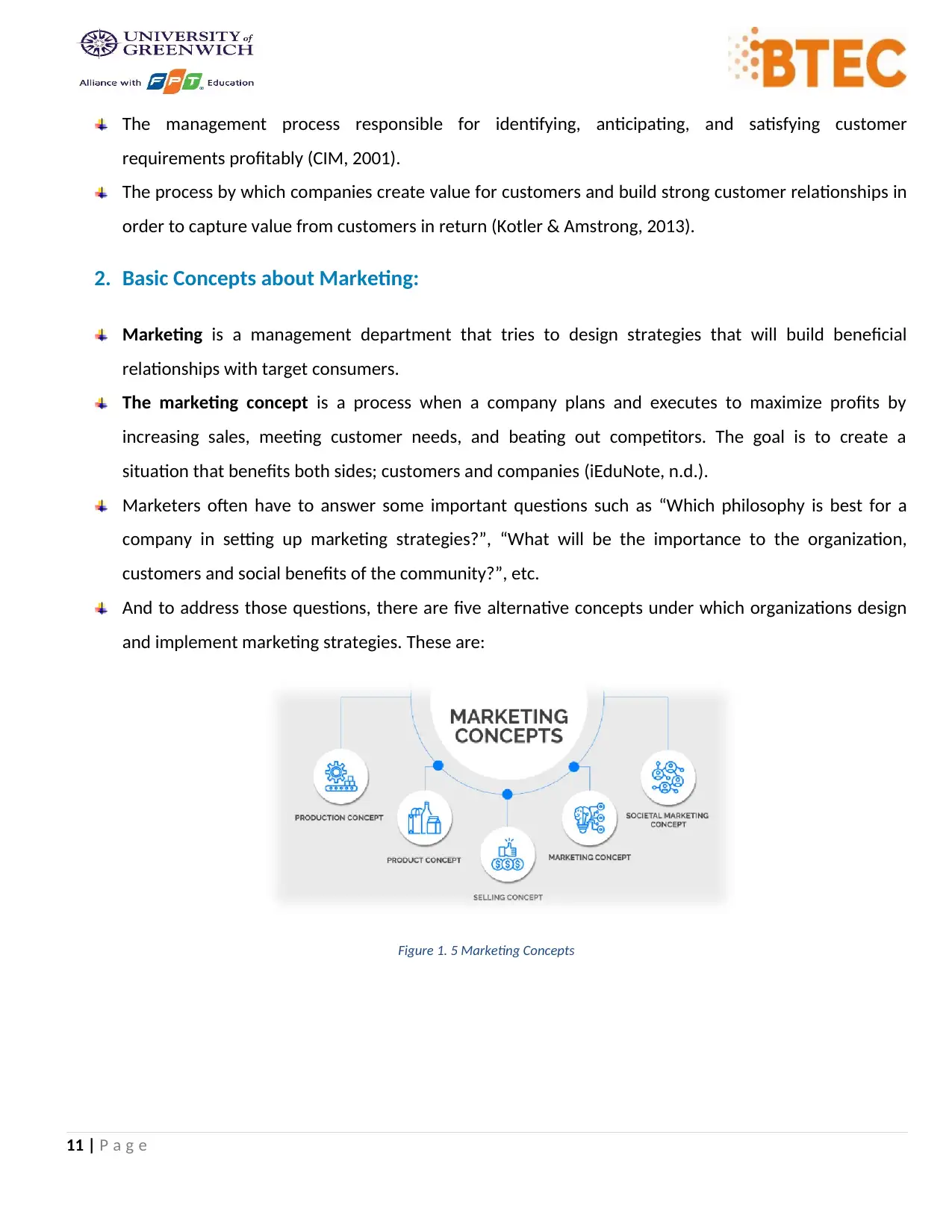
The management process responsible for identifying, anticipating, and satisfying customer
requirements profitably (CIM, 2001).
The process by which companies create value for customers and build strong customer relationships in
order to capture value from customers in return (Kotler & Amstrong, 2013).
2. Basic Concepts about Marketing:
Marketing is a management department that tries to design strategies that will build beneficial
relationships with target consumers.
The marketing concept is a process when a company plans and executes to maximize profits by
increasing sales, meeting customer needs, and beating out competitors. The goal is to create a
situation that benefits both sides; customers and companies (iEduNote, n.d.).
Marketers often have to answer some important questions such as “Which philosophy is best for a
company in setting up marketing strategies?”, “What will be the importance to the organization,
customers and social benefits of the community?”, etc.
And to address those questions, there are five alternative concepts under which organizations design
and implement marketing strategies. These are:
Figure 1. 5 Marketing Concepts
11 | P a g e
requirements profitably (CIM, 2001).
The process by which companies create value for customers and build strong customer relationships in
order to capture value from customers in return (Kotler & Amstrong, 2013).
2. Basic Concepts about Marketing:
Marketing is a management department that tries to design strategies that will build beneficial
relationships with target consumers.
The marketing concept is a process when a company plans and executes to maximize profits by
increasing sales, meeting customer needs, and beating out competitors. The goal is to create a
situation that benefits both sides; customers and companies (iEduNote, n.d.).
Marketers often have to answer some important questions such as “Which philosophy is best for a
company in setting up marketing strategies?”, “What will be the importance to the organization,
customers and social benefits of the community?”, etc.
And to address those questions, there are five alternative concepts under which organizations design
and implement marketing strategies. These are:
Figure 1. 5 Marketing Concepts
11 | P a g e
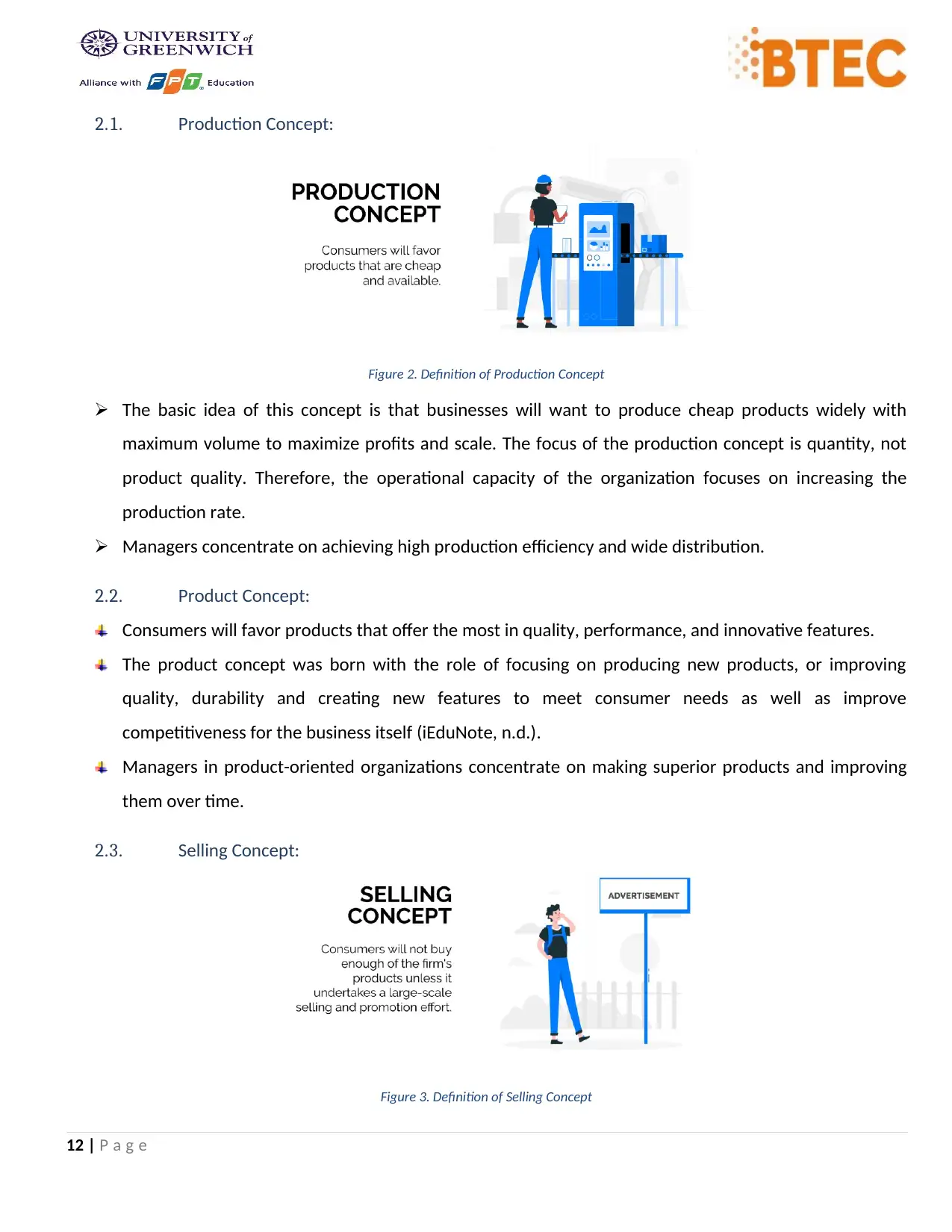
2.1. Production Concept:
Figure 2. Definition of Production Concept
The basic idea of this concept is that businesses will want to produce cheap products widely with
maximum volume to maximize profits and scale. The focus of the production concept is quantity, not
product quality. Therefore, the operational capacity of the organization focuses on increasing the
production rate.
Managers concentrate on achieving high production efficiency and wide distribution.
2.2. Product Concept:
Consumers will favor products that offer the most in quality, performance, and innovative features.
The product concept was born with the role of focusing on producing new products, or improving
quality, durability and creating new features to meet consumer needs as well as improve
competitiveness for the business itself (iEduNote, n.d.).
Managers in product-oriented organizations concentrate on making superior products and improving
them over time.
2.3. Selling Concept:
Figure 3. Definition of Selling Concept
12 | P a g e
Figure 2. Definition of Production Concept
The basic idea of this concept is that businesses will want to produce cheap products widely with
maximum volume to maximize profits and scale. The focus of the production concept is quantity, not
product quality. Therefore, the operational capacity of the organization focuses on increasing the
production rate.
Managers concentrate on achieving high production efficiency and wide distribution.
2.2. Product Concept:
Consumers will favor products that offer the most in quality, performance, and innovative features.
The product concept was born with the role of focusing on producing new products, or improving
quality, durability and creating new features to meet consumer needs as well as improve
competitiveness for the business itself (iEduNote, n.d.).
Managers in product-oriented organizations concentrate on making superior products and improving
them over time.
2.3. Selling Concept:
Figure 3. Definition of Selling Concept
12 | P a g e
Paraphrase This Document
Need a fresh take? Get an instant paraphrase of this document with our AI Paraphraser
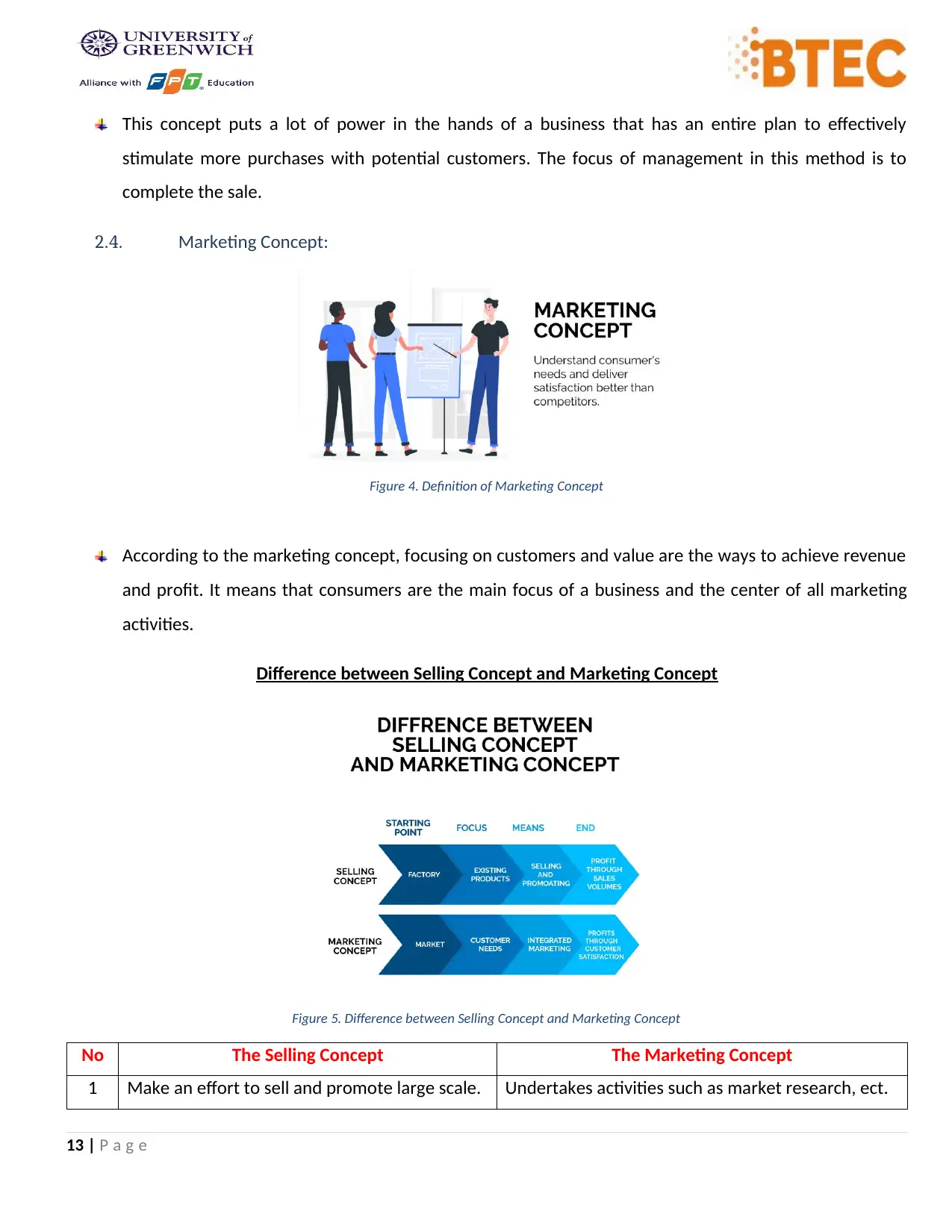
This concept puts a lot of power in the hands of a business that has an entire plan to effectively
stimulate more purchases with potential customers. The focus of management in this method is to
complete the sale.
2.4. Marketing Concept:
Figure 4. Definition of Marketing Concept
According to the marketing concept, focusing on customers and value are the ways to achieve revenue
and profit. It means that consumers are the main focus of a business and the center of all marketing
activities.
Difference between Selling Concept and Marketing Concept
Figure 5. Difference between Selling Concept and Marketing Concept
No The Selling Concept The Marketing Concept
1 Make an effort to sell and promote large scale. Undertakes activities such as market research, ect.
13 | P a g e
stimulate more purchases with potential customers. The focus of management in this method is to
complete the sale.
2.4. Marketing Concept:
Figure 4. Definition of Marketing Concept
According to the marketing concept, focusing on customers and value are the ways to achieve revenue
and profit. It means that consumers are the main focus of a business and the center of all marketing
activities.
Difference between Selling Concept and Marketing Concept
Figure 5. Difference between Selling Concept and Marketing Concept
No The Selling Concept The Marketing Concept
1 Make an effort to sell and promote large scale. Undertakes activities such as market research, ect.
13 | P a g e
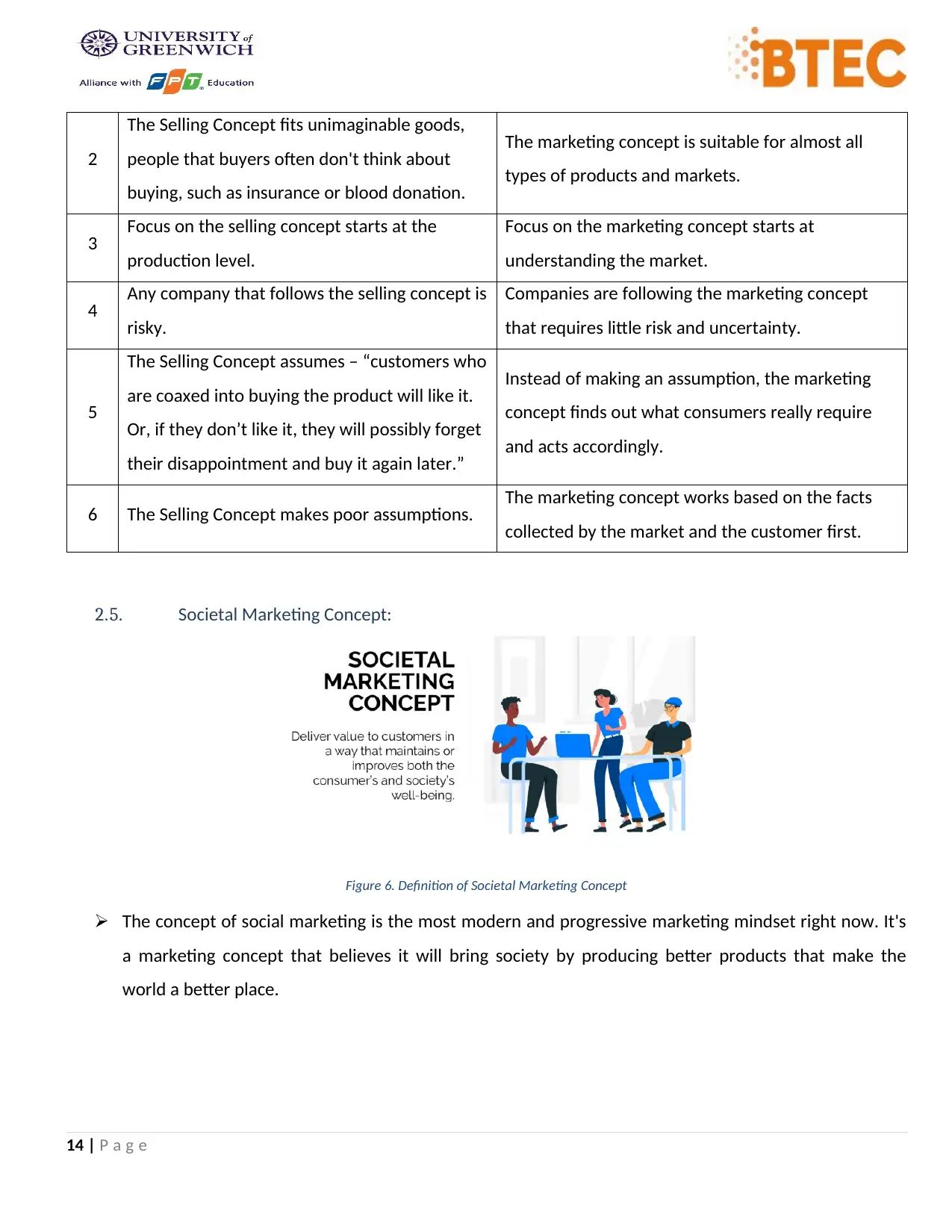
2
The Selling Concept fits unimaginable goods,
people that buyers often don't think about
buying, such as insurance or blood donation.
The marketing concept is suitable for almost all
types of products and markets.
3 Focus on the selling concept starts at the
production level.
Focus on the marketing concept starts at
understanding the market.
4 Any company that follows the selling concept is
risky.
Companies are following the marketing concept
that requires little risk and uncertainty.
5
The Selling Concept assumes – “customers who
are coaxed into buying the product will like it.
Or, if they don’t like it, they will possibly forget
their disappointment and buy it again later.”
Instead of making an assumption, the marketing
concept finds out what consumers really require
and acts accordingly.
6 The Selling Concept makes poor assumptions. The marketing concept works based on the facts
collected by the market and the customer first.
2.5. Societal Marketing Concept:
Figure 6. Definition of Societal Marketing Concept
The concept of social marketing is the most modern and progressive marketing mindset right now. It's
a marketing concept that believes it will bring society by producing better products that make the
world a better place.
14 | P a g e
The Selling Concept fits unimaginable goods,
people that buyers often don't think about
buying, such as insurance or blood donation.
The marketing concept is suitable for almost all
types of products and markets.
3 Focus on the selling concept starts at the
production level.
Focus on the marketing concept starts at
understanding the market.
4 Any company that follows the selling concept is
risky.
Companies are following the marketing concept
that requires little risk and uncertainty.
5
The Selling Concept assumes – “customers who
are coaxed into buying the product will like it.
Or, if they don’t like it, they will possibly forget
their disappointment and buy it again later.”
Instead of making an assumption, the marketing
concept finds out what consumers really require
and acts accordingly.
6 The Selling Concept makes poor assumptions. The marketing concept works based on the facts
collected by the market and the customer first.
2.5. Societal Marketing Concept:
Figure 6. Definition of Societal Marketing Concept
The concept of social marketing is the most modern and progressive marketing mindset right now. It's
a marketing concept that believes it will bring society by producing better products that make the
world a better place.
14 | P a g e
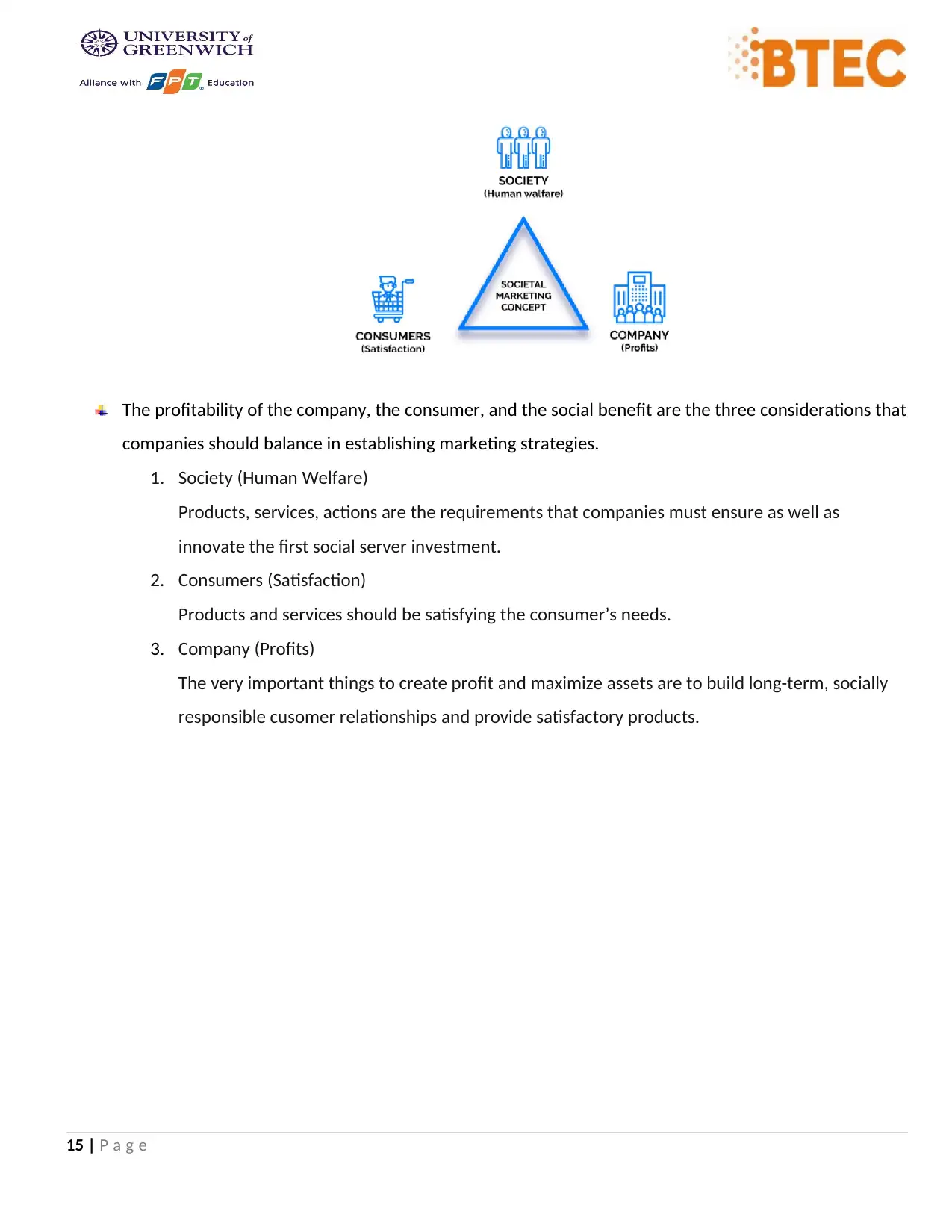
The profitability of the company, the consumer, and the social benefit are the three considerations that
companies should balance in establishing marketing strategies.
1. Society (Human Welfare)
Products, services, actions are the requirements that companies must ensure as well as
innovate the first social server investment.
2. Consumers (Satisfaction)
Products and services should be satisfying the consumer’s needs.
3. Company (Profits)
The very important things to create profit and maximize assets are to build long-term, socially
responsible cusomer relationships and provide satisfactory products.
15 | P a g e
companies should balance in establishing marketing strategies.
1. Society (Human Welfare)
Products, services, actions are the requirements that companies must ensure as well as
innovate the first social server investment.
2. Consumers (Satisfaction)
Products and services should be satisfying the consumer’s needs.
3. Company (Profits)
The very important things to create profit and maximize assets are to build long-term, socially
responsible cusomer relationships and provide satisfactory products.
15 | P a g e
Secure Best Marks with AI Grader
Need help grading? Try our AI Grader for instant feedback on your assignments.
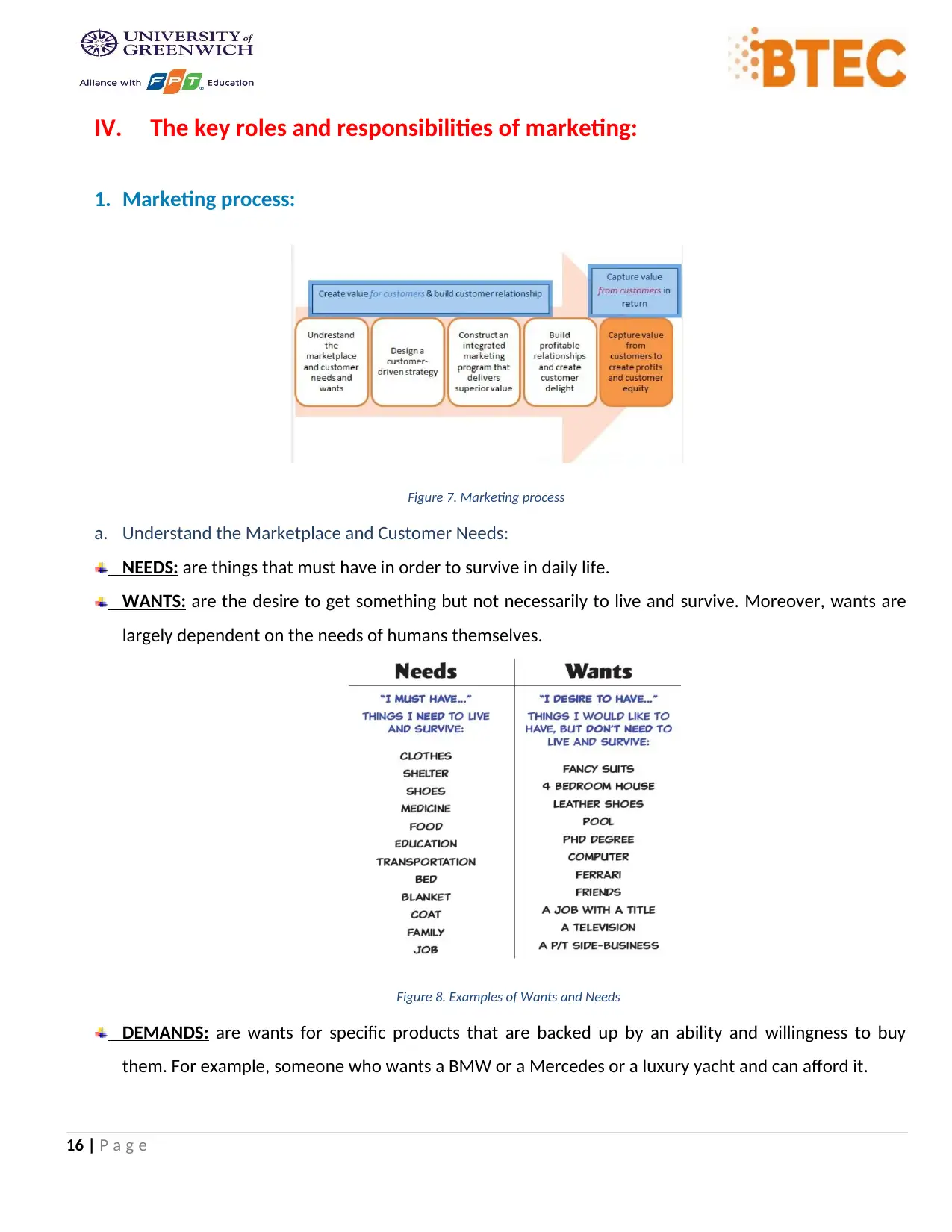
IV. The key roles and responsibilities of marketing:
1. Marketing process:
Figure 7. Marketing process
a. Understand the Marketplace and Customer Needs:
NEEDS: are things that must have in order to survive in daily life.
WANTS: are the desire to get something but not necessarily to live and survive. Moreover, wants are
largely dependent on the needs of humans themselves.
Figure 8. Examples of Wants and Needs
DEMANDS: are wants for specific products that are backed up by an ability and willingness to buy
them. For example, someone who wants a BMW or a Mercedes or a luxury yacht and can afford it.
16 | P a g e
1. Marketing process:
Figure 7. Marketing process
a. Understand the Marketplace and Customer Needs:
NEEDS: are things that must have in order to survive in daily life.
WANTS: are the desire to get something but not necessarily to live and survive. Moreover, wants are
largely dependent on the needs of humans themselves.
Figure 8. Examples of Wants and Needs
DEMANDS: are wants for specific products that are backed up by an ability and willingness to buy
them. For example, someone who wants a BMW or a Mercedes or a luxury yacht and can afford it.
16 | P a g e
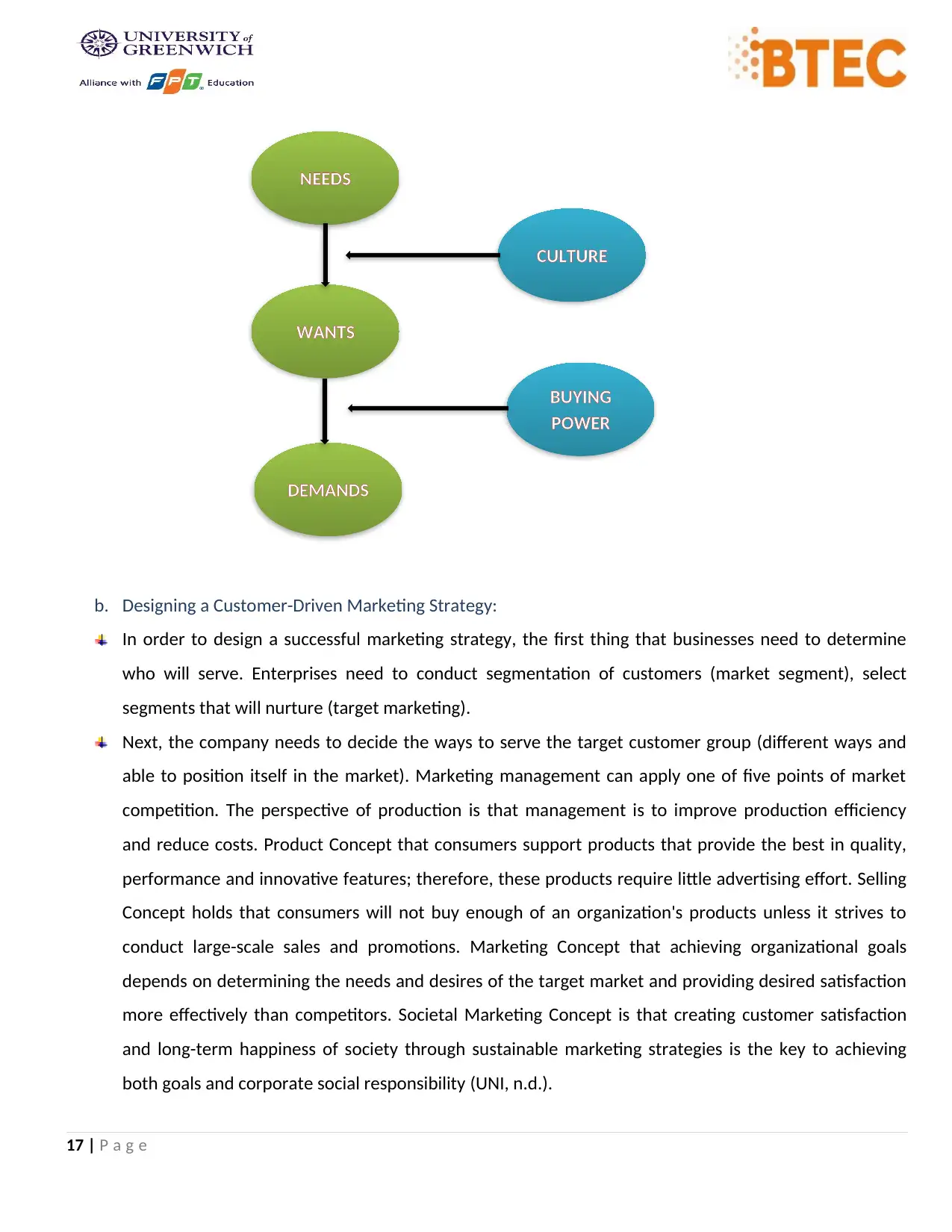
b. Designing a Customer-Driven Marketing Strategy:
In order to design a successful marketing strategy, the first thing that businesses need to determine
who will serve. Enterprises need to conduct segmentation of customers (market segment), select
segments that will nurture (target marketing).
Next, the company needs to decide the ways to serve the target customer group (different ways and
able to position itself in the market). Marketing management can apply one of five points of market
competition. The perspective of production is that management is to improve production efficiency
and reduce costs. Product Concept that consumers support products that provide the best in quality,
performance and innovative features; therefore, these products require little advertising effort. Selling
Concept holds that consumers will not buy enough of an organization's products unless it strives to
conduct large-scale sales and promotions. Marketing Concept that achieving organizational goals
depends on determining the needs and desires of the target market and providing desired satisfaction
more effectively than competitors. Societal Marketing Concept is that creating customer satisfaction
and long-term happiness of society through sustainable marketing strategies is the key to achieving
both goals and corporate social responsibility (UNI, n.d.).
17 | P a g e
DEMANDS
CULTURE
NEEDS
WANTS
BUYING
POWER
In order to design a successful marketing strategy, the first thing that businesses need to determine
who will serve. Enterprises need to conduct segmentation of customers (market segment), select
segments that will nurture (target marketing).
Next, the company needs to decide the ways to serve the target customer group (different ways and
able to position itself in the market). Marketing management can apply one of five points of market
competition. The perspective of production is that management is to improve production efficiency
and reduce costs. Product Concept that consumers support products that provide the best in quality,
performance and innovative features; therefore, these products require little advertising effort. Selling
Concept holds that consumers will not buy enough of an organization's products unless it strives to
conduct large-scale sales and promotions. Marketing Concept that achieving organizational goals
depends on determining the needs and desires of the target market and providing desired satisfaction
more effectively than competitors. Societal Marketing Concept is that creating customer satisfaction
and long-term happiness of society through sustainable marketing strategies is the key to achieving
both goals and corporate social responsibility (UNI, n.d.).
17 | P a g e
DEMANDS
CULTURE
NEEDS
WANTS
BUYING
POWER
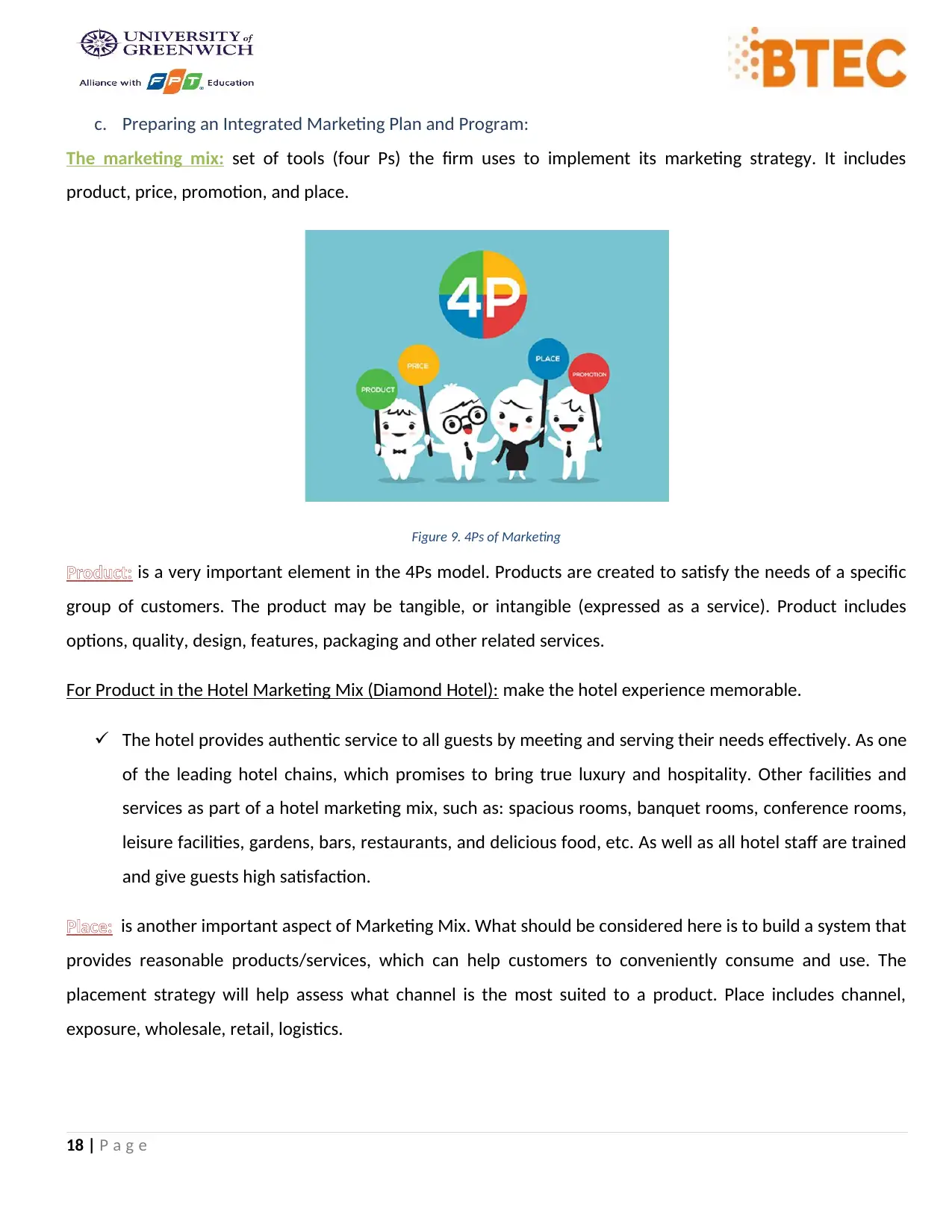
c. Preparing an Integrated Marketing Plan and Program:
The marketing mix: set of tools (four Ps) the firm uses to implement its marketing strategy. It includes
product, price, promotion, and place.
Figure 9. 4Ps of Marketing
Product: is a very important element in the 4Ps model. Products are created to satisfy the needs of a specific
group of customers. The product may be tangible, or intangible (expressed as a service). Product includes
options, quality, design, features, packaging and other related services.
For Product in the Hotel Marketing Mix (Diamond Hotel): make the hotel experience memorable.
The hotel provides authentic service to all guests by meeting and serving their needs effectively. As one
of the leading hotel chains, which promises to bring true luxury and hospitality. Other facilities and
services as part of a hotel marketing mix, such as: spacious rooms, banquet rooms, conference rooms,
leisure facilities, gardens, bars, restaurants, and delicious food, etc. As well as all hotel staff are trained
and give guests high satisfaction.
Place: is another important aspect of Marketing Mix. What should be considered here is to build a system that
provides reasonable products/services, which can help customers to conveniently consume and use. The
placement strategy will help assess what channel is the most suited to a product. Place includes channel,
exposure, wholesale, retail, logistics.
18 | P a g e
The marketing mix: set of tools (four Ps) the firm uses to implement its marketing strategy. It includes
product, price, promotion, and place.
Figure 9. 4Ps of Marketing
Product: is a very important element in the 4Ps model. Products are created to satisfy the needs of a specific
group of customers. The product may be tangible, or intangible (expressed as a service). Product includes
options, quality, design, features, packaging and other related services.
For Product in the Hotel Marketing Mix (Diamond Hotel): make the hotel experience memorable.
The hotel provides authentic service to all guests by meeting and serving their needs effectively. As one
of the leading hotel chains, which promises to bring true luxury and hospitality. Other facilities and
services as part of a hotel marketing mix, such as: spacious rooms, banquet rooms, conference rooms,
leisure facilities, gardens, bars, restaurants, and delicious food, etc. As well as all hotel staff are trained
and give guests high satisfaction.
Place: is another important aspect of Marketing Mix. What should be considered here is to build a system that
provides reasonable products/services, which can help customers to conveniently consume and use. The
placement strategy will help assess what channel is the most suited to a product. Place includes channel,
exposure, wholesale, retail, logistics.
18 | P a g e
Paraphrase This Document
Need a fresh take? Get an instant paraphrase of this document with our AI Paraphraser
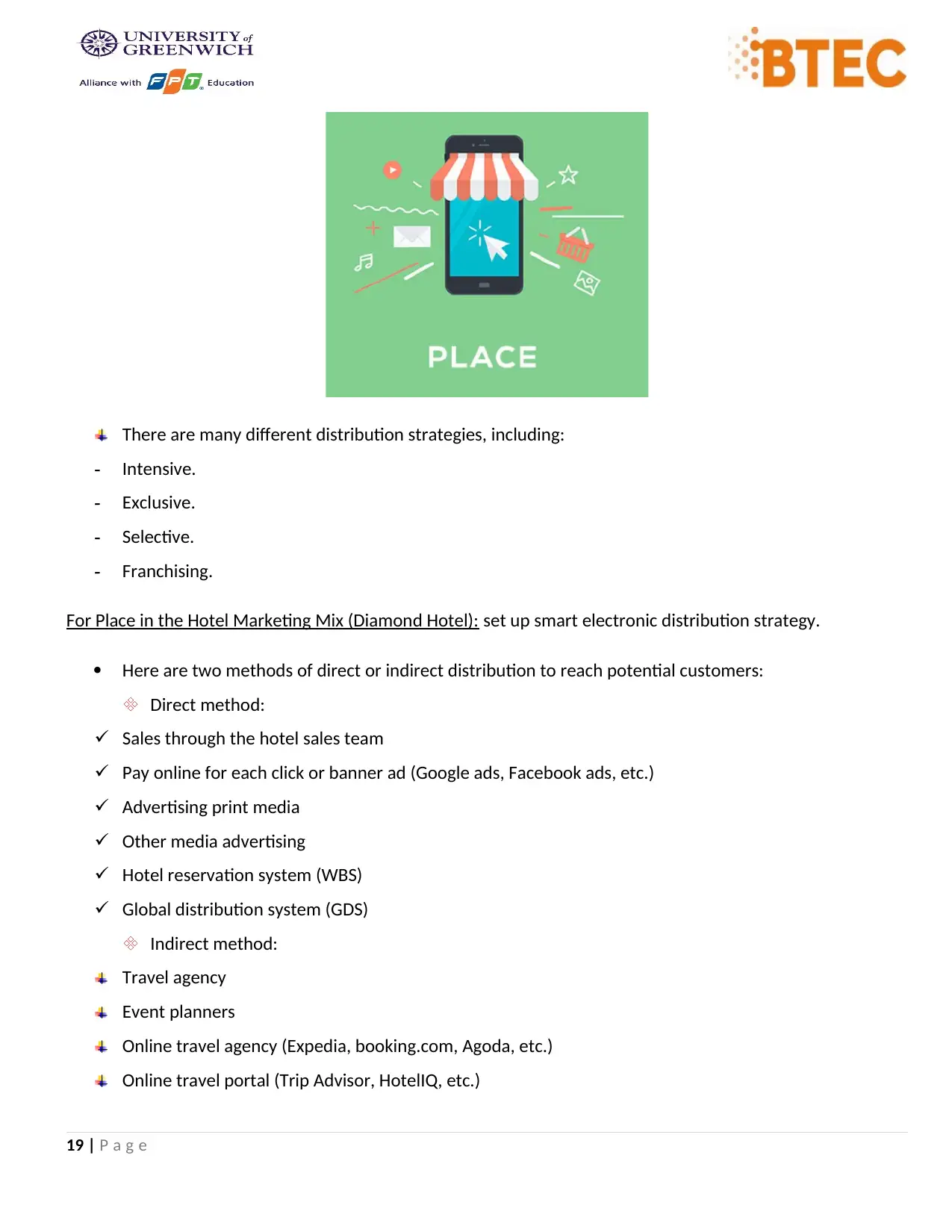
There are many different distribution strategies, including:
- Intensive.
- Exclusive.
- Selective.
- Franchising.
For Place in the Hotel Marketing Mix (Diamond Hotel): set up smart electronic distribution strategy.
Here are two methods of direct or indirect distribution to reach potential customers:
Direct method:
Sales through the hotel sales team
Pay online for each click or banner ad (Google ads, Facebook ads, etc.)
Advertising print media
Other media advertising
Hotel reservation system (WBS)
Global distribution system (GDS)
Indirect method:
Travel agency
Event planners
Online travel agency (Expedia, booking.com, Agoda, etc.)
Online travel portal (Trip Advisor, HotelIQ, etc.)
19 | P a g e
- Intensive.
- Exclusive.
- Selective.
- Franchising.
For Place in the Hotel Marketing Mix (Diamond Hotel): set up smart electronic distribution strategy.
Here are two methods of direct or indirect distribution to reach potential customers:
Direct method:
Sales through the hotel sales team
Pay online for each click or banner ad (Google ads, Facebook ads, etc.)
Advertising print media
Other media advertising
Hotel reservation system (WBS)
Global distribution system (GDS)
Indirect method:
Travel agency
Event planners
Online travel agency (Expedia, booking.com, Agoda, etc.)
Online travel portal (Trip Advisor, HotelIQ, etc.)
19 | P a g e
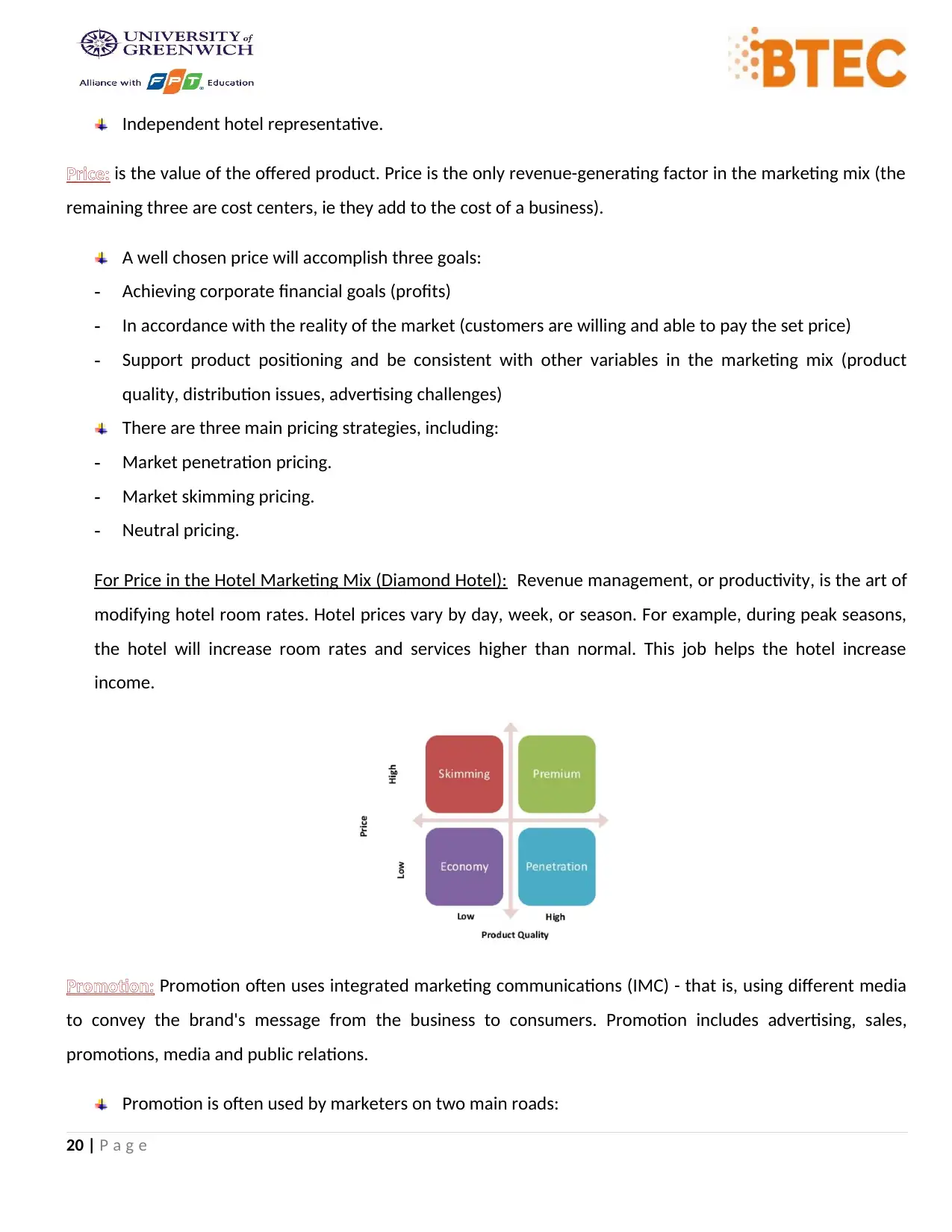
Independent hotel representative.
Price: is the value of the offered product. Price is the only revenue-generating factor in the marketing mix (the
remaining three are cost centers, ie they add to the cost of a business).
A well chosen price will accomplish three goals:
- Achieving corporate financial goals (profits)
- In accordance with the reality of the market (customers are willing and able to pay the set price)
- Support product positioning and be consistent with other variables in the marketing mix (product
quality, distribution issues, advertising challenges)
There are three main pricing strategies, including:
- Market penetration pricing.
- Market skimming pricing.
- Neutral pricing.
For Price in the Hotel Marketing Mix (Diamond Hotel): Revenue management, or productivity, is the art of
modifying hotel room rates. Hotel prices vary by day, week, or season. For example, during peak seasons,
the hotel will increase room rates and services higher than normal. This job helps the hotel increase
income.
Promotion: Promotion often uses integrated marketing communications (IMC) - that is, using different media
to convey the brand's message from the business to consumers. Promotion includes advertising, sales,
promotions, media and public relations.
Promotion is often used by marketers on two main roads:
20 | P a g e
Price: is the value of the offered product. Price is the only revenue-generating factor in the marketing mix (the
remaining three are cost centers, ie they add to the cost of a business).
A well chosen price will accomplish three goals:
- Achieving corporate financial goals (profits)
- In accordance with the reality of the market (customers are willing and able to pay the set price)
- Support product positioning and be consistent with other variables in the marketing mix (product
quality, distribution issues, advertising challenges)
There are three main pricing strategies, including:
- Market penetration pricing.
- Market skimming pricing.
- Neutral pricing.
For Price in the Hotel Marketing Mix (Diamond Hotel): Revenue management, or productivity, is the art of
modifying hotel room rates. Hotel prices vary by day, week, or season. For example, during peak seasons,
the hotel will increase room rates and services higher than normal. This job helps the hotel increase
income.
Promotion: Promotion often uses integrated marketing communications (IMC) - that is, using different media
to convey the brand's message from the business to consumers. Promotion includes advertising, sales,
promotions, media and public relations.
Promotion is often used by marketers on two main roads:
20 | P a g e
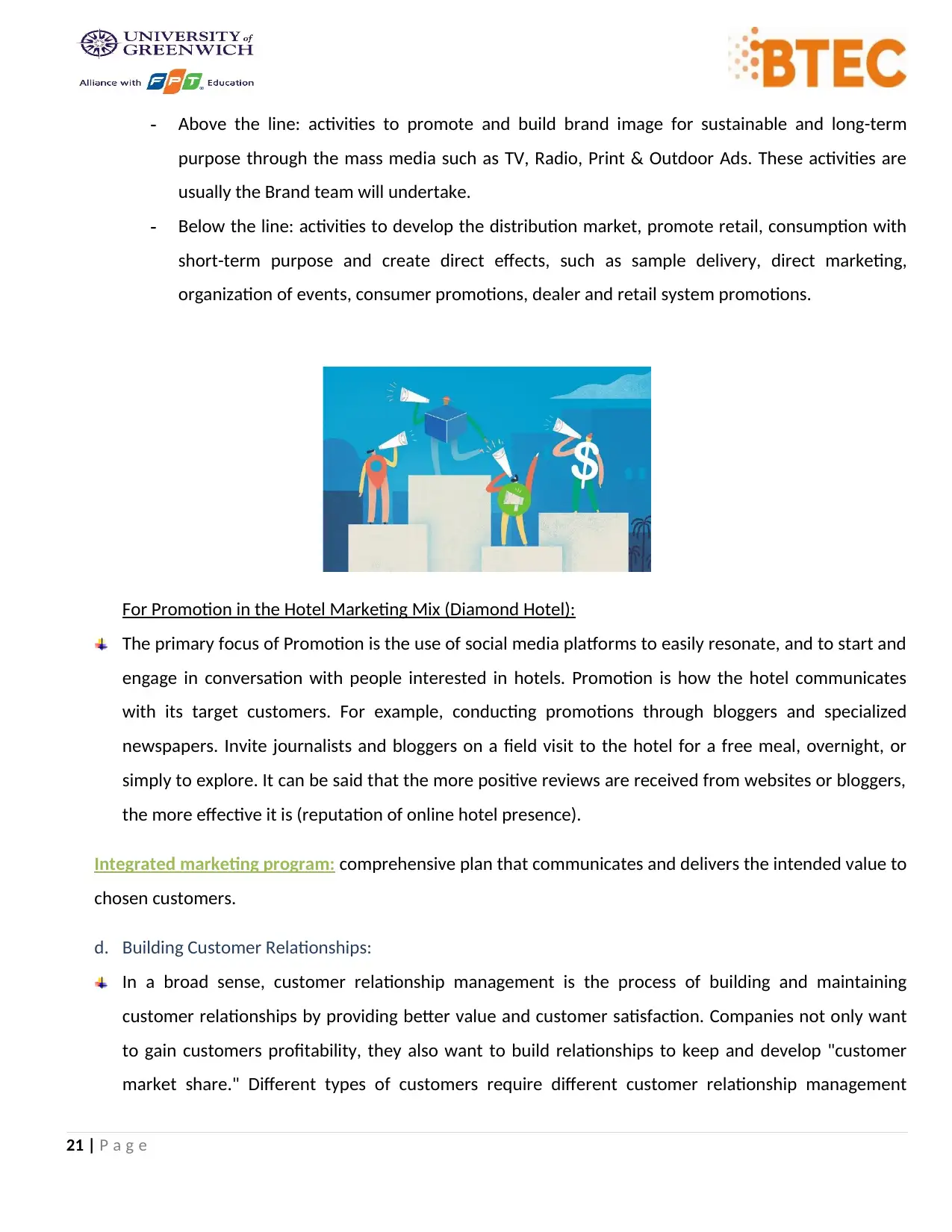
- Above the line: activities to promote and build brand image for sustainable and long-term
purpose through the mass media such as TV, Radio, Print & Outdoor Ads. These activities are
usually the Brand team will undertake.
- Below the line: activities to develop the distribution market, promote retail, consumption with
short-term purpose and create direct effects, such as sample delivery, direct marketing,
organization of events, consumer promotions, dealer and retail system promotions.
For Promotion in the Hotel Marketing Mix (Diamond Hotel):
The primary focus of Promotion is the use of social media platforms to easily resonate, and to start and
engage in conversation with people interested in hotels. Promotion is how the hotel communicates
with its target customers. For example, conducting promotions through bloggers and specialized
newspapers. Invite journalists and bloggers on a field visit to the hotel for a free meal, overnight, or
simply to explore. It can be said that the more positive reviews are received from websites or bloggers,
the more effective it is (reputation of online hotel presence).
Integrated marketing program: comprehensive plan that communicates and delivers the intended value to
chosen customers.
d. Building Customer Relationships:
In a broad sense, customer relationship management is the process of building and maintaining
customer relationships by providing better value and customer satisfaction. Companies not only want
to gain customers profitability, they also want to build relationships to keep and develop "customer
market share." Different types of customers require different customer relationship management
21 | P a g e
purpose through the mass media such as TV, Radio, Print & Outdoor Ads. These activities are
usually the Brand team will undertake.
- Below the line: activities to develop the distribution market, promote retail, consumption with
short-term purpose and create direct effects, such as sample delivery, direct marketing,
organization of events, consumer promotions, dealer and retail system promotions.
For Promotion in the Hotel Marketing Mix (Diamond Hotel):
The primary focus of Promotion is the use of social media platforms to easily resonate, and to start and
engage in conversation with people interested in hotels. Promotion is how the hotel communicates
with its target customers. For example, conducting promotions through bloggers and specialized
newspapers. Invite journalists and bloggers on a field visit to the hotel for a free meal, overnight, or
simply to explore. It can be said that the more positive reviews are received from websites or bloggers,
the more effective it is (reputation of online hotel presence).
Integrated marketing program: comprehensive plan that communicates and delivers the intended value to
chosen customers.
d. Building Customer Relationships:
In a broad sense, customer relationship management is the process of building and maintaining
customer relationships by providing better value and customer satisfaction. Companies not only want
to gain customers profitability, they also want to build relationships to keep and develop "customer
market share." Different types of customers require different customer relationship management
21 | P a g e
Secure Best Marks with AI Grader
Need help grading? Try our AI Grader for instant feedback on your assignments.
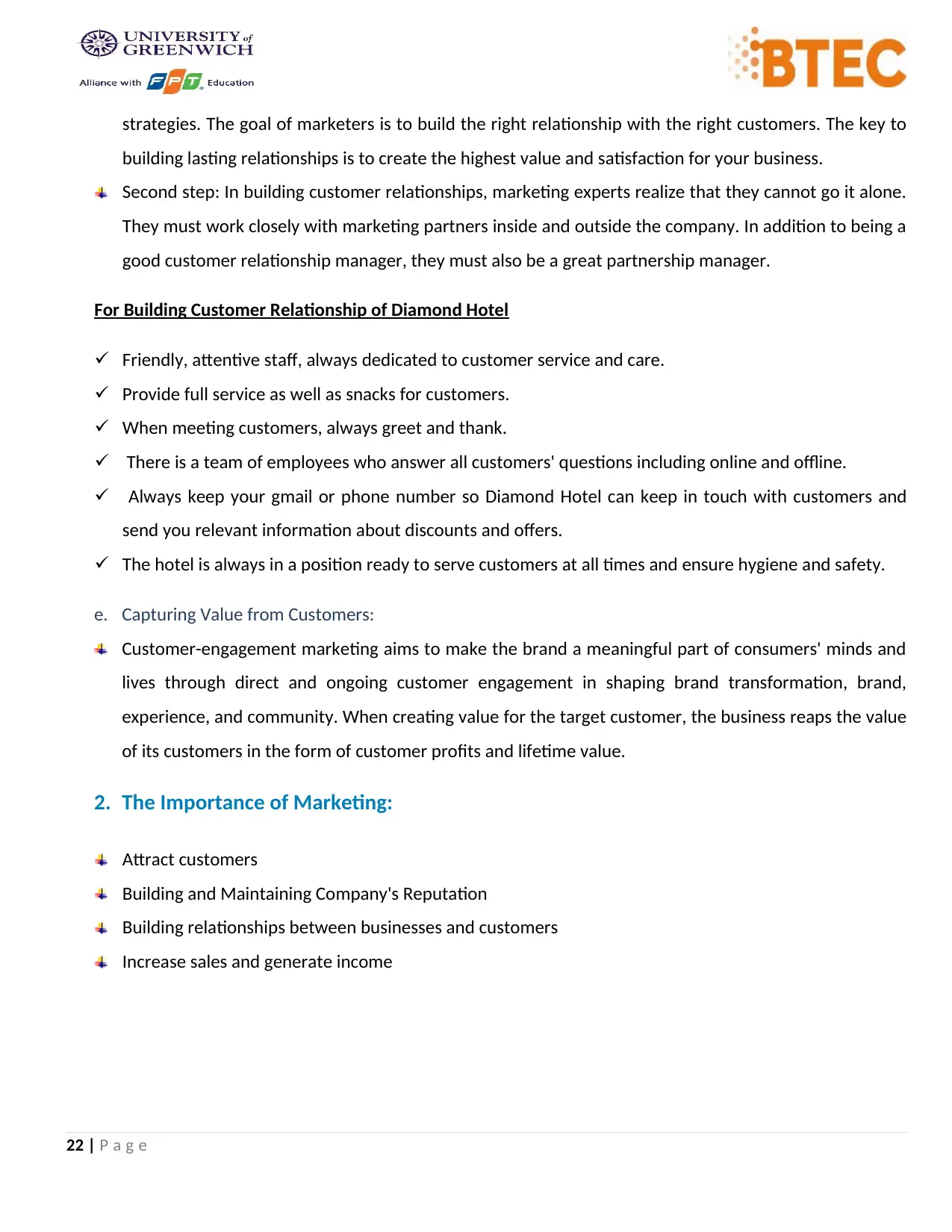
strategies. The goal of marketers is to build the right relationship with the right customers. The key to
building lasting relationships is to create the highest value and satisfaction for your business.
Second step: In building customer relationships, marketing experts realize that they cannot go it alone.
They must work closely with marketing partners inside and outside the company. In addition to being a
good customer relationship manager, they must also be a great partnership manager.
For Building Customer Relationship of Diamond Hotel
Friendly, attentive staff, always dedicated to customer service and care.
Provide full service as well as snacks for customers.
When meeting customers, always greet and thank.
There is a team of employees who answer all customers' questions including online and offline.
Always keep your gmail or phone number so Diamond Hotel can keep in touch with customers and
send you relevant information about discounts and offers.
The hotel is always in a position ready to serve customers at all times and ensure hygiene and safety.
e. Capturing Value from Customers:
Customer-engagement marketing aims to make the brand a meaningful part of consumers' minds and
lives through direct and ongoing customer engagement in shaping brand transformation, brand,
experience, and community. When creating value for the target customer, the business reaps the value
of its customers in the form of customer profits and lifetime value.
2. The Importance of Marketing:
Attract customers
Building and Maintaining Company's Reputation
Building relationships between businesses and customers
Increase sales and generate income
22 | P a g e
building lasting relationships is to create the highest value and satisfaction for your business.
Second step: In building customer relationships, marketing experts realize that they cannot go it alone.
They must work closely with marketing partners inside and outside the company. In addition to being a
good customer relationship manager, they must also be a great partnership manager.
For Building Customer Relationship of Diamond Hotel
Friendly, attentive staff, always dedicated to customer service and care.
Provide full service as well as snacks for customers.
When meeting customers, always greet and thank.
There is a team of employees who answer all customers' questions including online and offline.
Always keep your gmail or phone number so Diamond Hotel can keep in touch with customers and
send you relevant information about discounts and offers.
The hotel is always in a position ready to serve customers at all times and ensure hygiene and safety.
e. Capturing Value from Customers:
Customer-engagement marketing aims to make the brand a meaningful part of consumers' minds and
lives through direct and ongoing customer engagement in shaping brand transformation, brand,
experience, and community. When creating value for the target customer, the business reaps the value
of its customers in the form of customer profits and lifetime value.
2. The Importance of Marketing:
Attract customers
Building and Maintaining Company's Reputation
Building relationships between businesses and customers
Increase sales and generate income
22 | P a g e
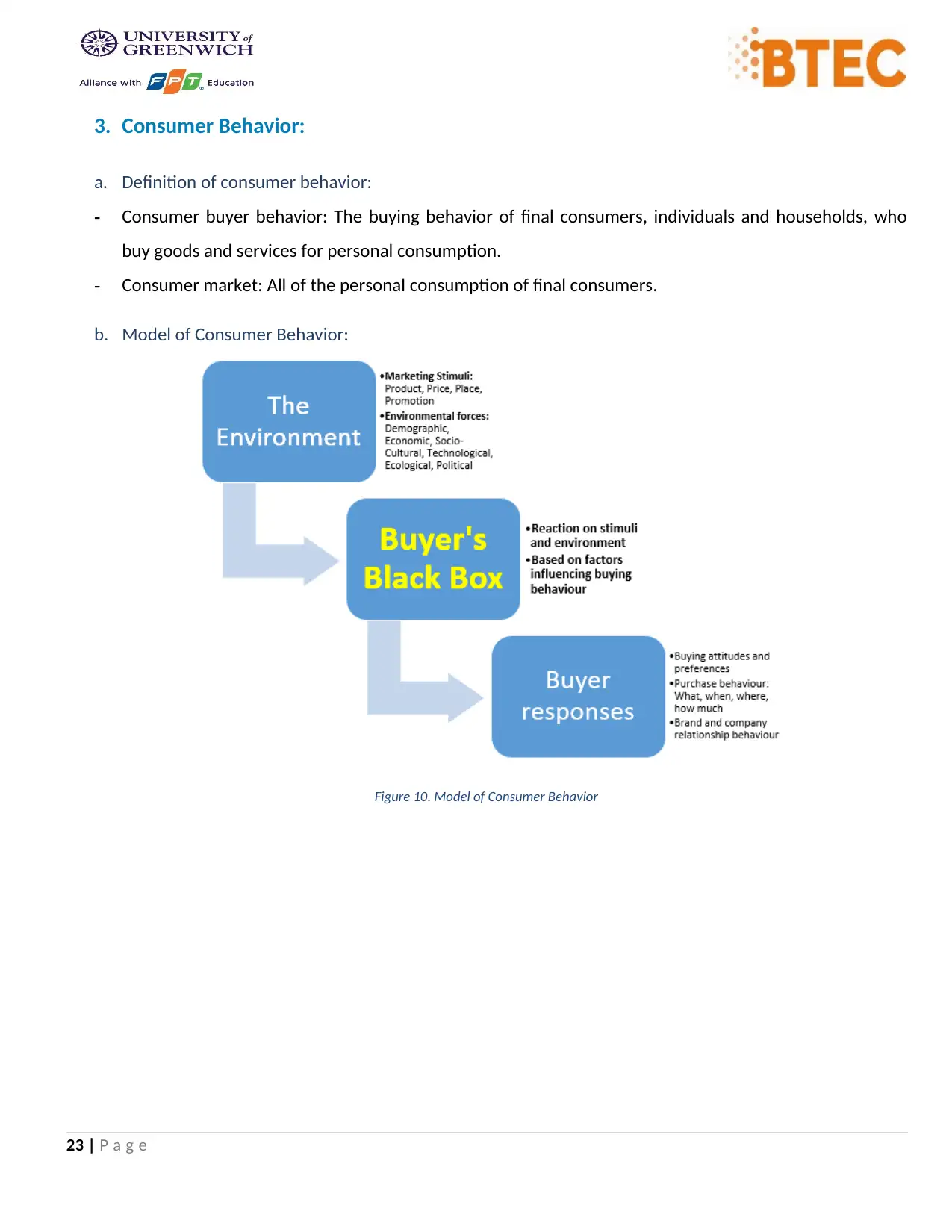
3. Consumer Behavior:
a. Definition of consumer behavior:
- Consumer buyer behavior: The buying behavior of final consumers, individuals and households, who
buy goods and services for personal consumption.
- Consumer market: All of the personal consumption of final consumers.
b. Model of Consumer Behavior:
Figure 10. Model of Consumer Behavior
23 | P a g e
a. Definition of consumer behavior:
- Consumer buyer behavior: The buying behavior of final consumers, individuals and households, who
buy goods and services for personal consumption.
- Consumer market: All of the personal consumption of final consumers.
b. Model of Consumer Behavior:
Figure 10. Model of Consumer Behavior
23 | P a g e
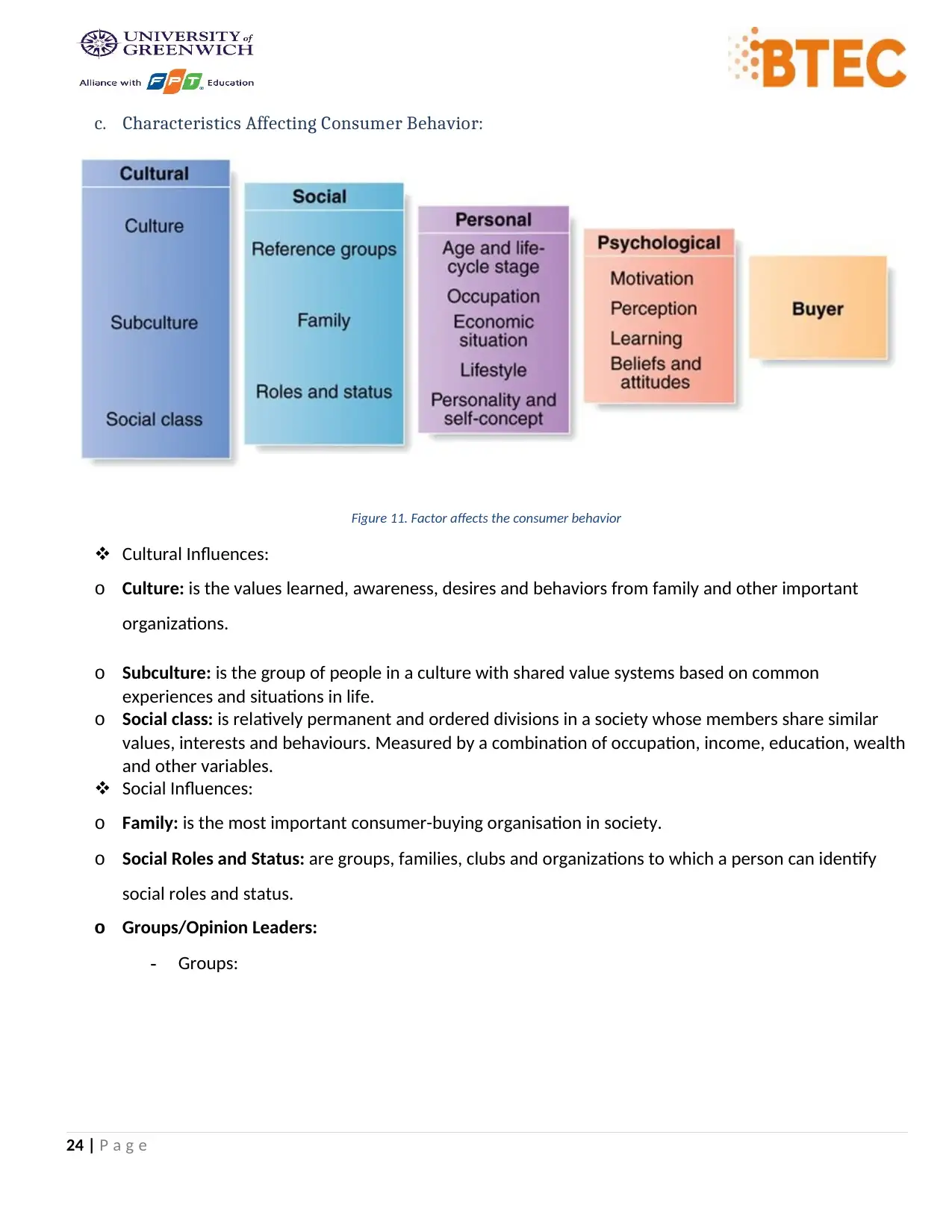
c. Characteristics Affecting Consumer Behavior:
Figure 11. Factor affects the consumer behavior
Cultural Influences:
o Culture: is the values learned, awareness, desires and behaviors from family and other important
organizations.
o Subculture: is the group of people in a culture with shared value systems based on common
experiences and situations in life.
o Social class: is relatively permanent and ordered divisions in a society whose members share similar
values, interests and behaviours. Measured by a combination of occupation, income, education, wealth
and other variables.
Social Influences:
o Family: is the most important consumer-buying organisation in society.
o Social Roles and Status: are groups, families, clubs and organizations to which a person can identify
social roles and status.
o Groups/Opinion Leaders:
- Groups:
24 | P a g e
Figure 11. Factor affects the consumer behavior
Cultural Influences:
o Culture: is the values learned, awareness, desires and behaviors from family and other important
organizations.
o Subculture: is the group of people in a culture with shared value systems based on common
experiences and situations in life.
o Social class: is relatively permanent and ordered divisions in a society whose members share similar
values, interests and behaviours. Measured by a combination of occupation, income, education, wealth
and other variables.
Social Influences:
o Family: is the most important consumer-buying organisation in society.
o Social Roles and Status: are groups, families, clubs and organizations to which a person can identify
social roles and status.
o Groups/Opinion Leaders:
- Groups:
24 | P a g e
Paraphrase This Document
Need a fresh take? Get an instant paraphrase of this document with our AI Paraphraser
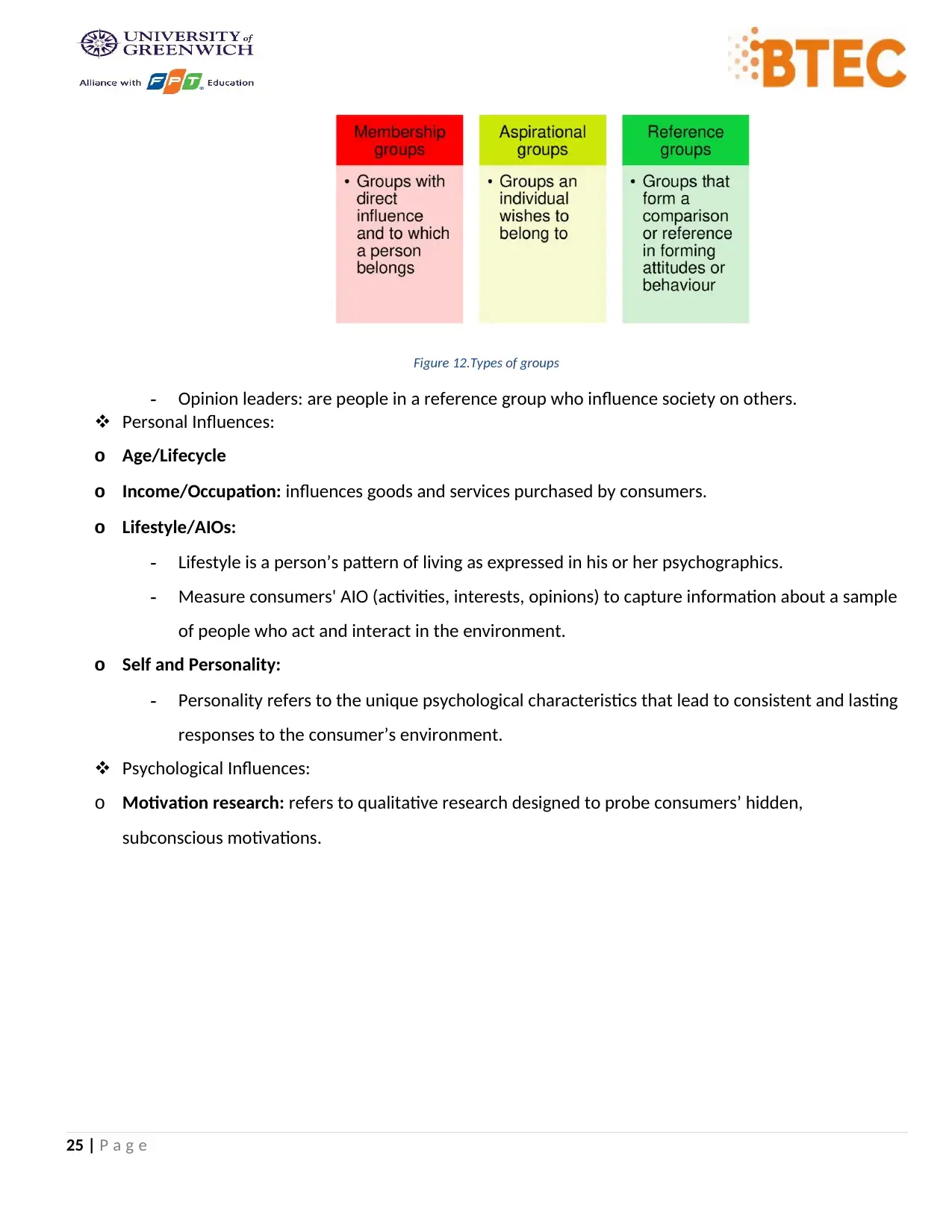
Figure 12.Types of groups
- Opinion leaders: are people in a reference group who influence society on others.
Personal Influences:
o Age/Lifecycle
o Income/Occupation: influences goods and services purchased by consumers.
o Lifestyle/AIOs:
- Lifestyle is a person’s pattern of living as expressed in his or her psychographics.
- Measure consumers' AIO (activities, interests, opinions) to capture information about a sample
of people who act and interact in the environment.
o Self and Personality:
- Personality refers to the unique psychological characteristics that lead to consistent and lasting
responses to the consumer’s environment.
Psychological Influences:
o Motivation research: refers to qualitative research designed to probe consumers’ hidden,
subconscious motivations.
25 | P a g e
- Opinion leaders: are people in a reference group who influence society on others.
Personal Influences:
o Age/Lifecycle
o Income/Occupation: influences goods and services purchased by consumers.
o Lifestyle/AIOs:
- Lifestyle is a person’s pattern of living as expressed in his or her psychographics.
- Measure consumers' AIO (activities, interests, opinions) to capture information about a sample
of people who act and interact in the environment.
o Self and Personality:
- Personality refers to the unique psychological characteristics that lead to consistent and lasting
responses to the consumer’s environment.
Psychological Influences:
o Motivation research: refers to qualitative research designed to probe consumers’ hidden,
subconscious motivations.
25 | P a g e
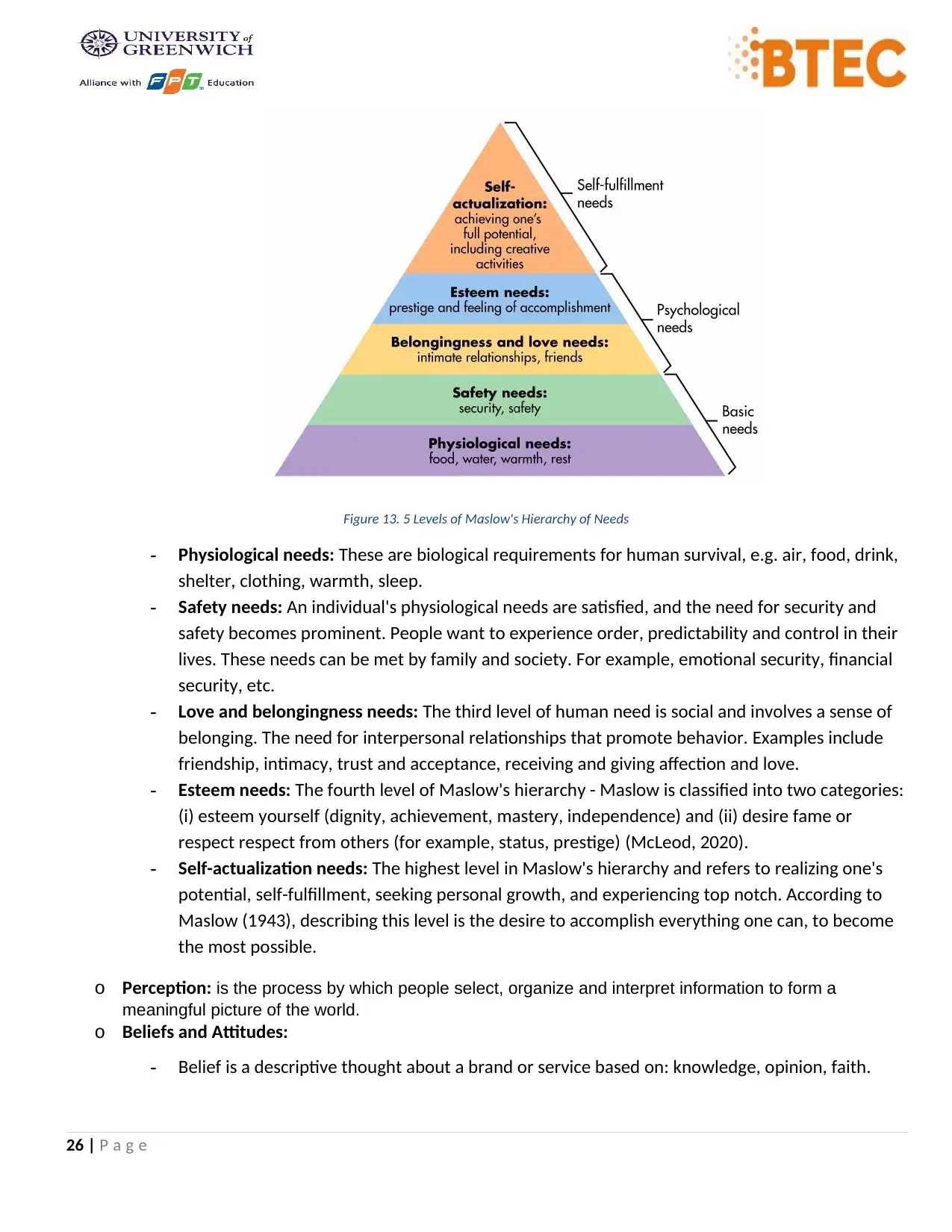
Figure 13. 5 Levels of Maslow's Hierarchy of Needs
- Physiological needs: These are biological requirements for human survival, e.g. air, food, drink,
shelter, clothing, warmth, sleep.
- Safety needs: An individual's physiological needs are satisfied, and the need for security and
safety becomes prominent. People want to experience order, predictability and control in their
lives. These needs can be met by family and society. For example, emotional security, financial
security, etc.
- Love and belongingness needs: The third level of human need is social and involves a sense of
belonging. The need for interpersonal relationships that promote behavior. Examples include
friendship, intimacy, trust and acceptance, receiving and giving affection and love.
- Esteem needs: The fourth level of Maslow's hierarchy - Maslow is classified into two categories:
(i) esteem yourself (dignity, achievement, mastery, independence) and (ii) desire fame or
respect respect from others (for example, status, prestige) (McLeod, 2020).
- Self-actualization needs: The highest level in Maslow's hierarchy and refers to realizing one's
potential, self-fulfillment, seeking personal growth, and experiencing top notch. According to
Maslow (1943), describing this level is the desire to accomplish everything one can, to become
the most possible.
o Perception: is the process by which people select, organize and interpret information to form a
meaningful picture of the world.
o Beliefs and Attitudes:
- Belief is a descriptive thought about a brand or service based on: knowledge, opinion, faith.
26 | P a g e
- Physiological needs: These are biological requirements for human survival, e.g. air, food, drink,
shelter, clothing, warmth, sleep.
- Safety needs: An individual's physiological needs are satisfied, and the need for security and
safety becomes prominent. People want to experience order, predictability and control in their
lives. These needs can be met by family and society. For example, emotional security, financial
security, etc.
- Love and belongingness needs: The third level of human need is social and involves a sense of
belonging. The need for interpersonal relationships that promote behavior. Examples include
friendship, intimacy, trust and acceptance, receiving and giving affection and love.
- Esteem needs: The fourth level of Maslow's hierarchy - Maslow is classified into two categories:
(i) esteem yourself (dignity, achievement, mastery, independence) and (ii) desire fame or
respect respect from others (for example, status, prestige) (McLeod, 2020).
- Self-actualization needs: The highest level in Maslow's hierarchy and refers to realizing one's
potential, self-fulfillment, seeking personal growth, and experiencing top notch. According to
Maslow (1943), describing this level is the desire to accomplish everything one can, to become
the most possible.
o Perception: is the process by which people select, organize and interpret information to form a
meaningful picture of the world.
o Beliefs and Attitudes:
- Belief is a descriptive thought about a brand or service based on: knowledge, opinion, faith.
26 | P a g e
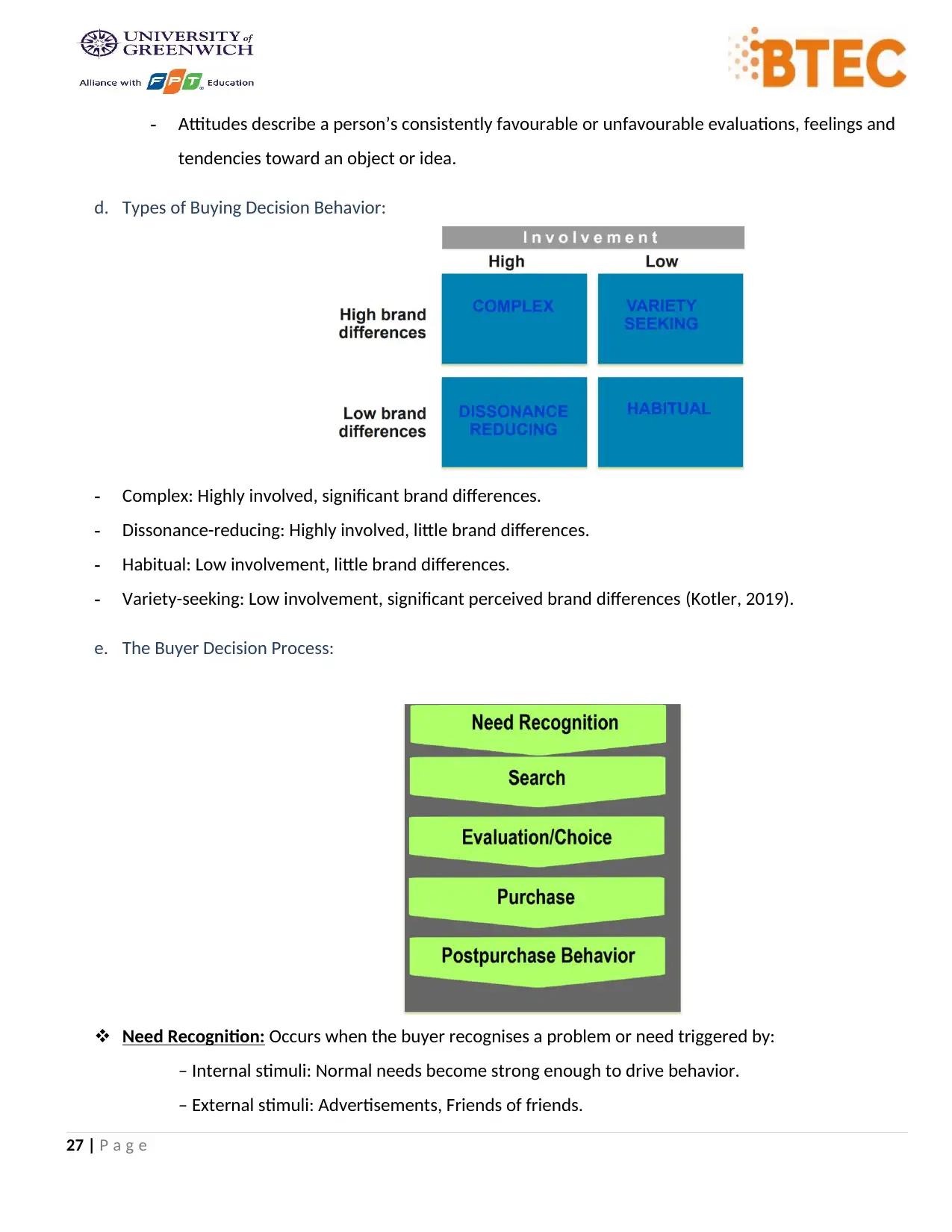
- Attitudes describe a person’s consistently favourable or unfavourable evaluations, feelings and
tendencies toward an object or idea.
d. Types of Buying Decision Behavior:
- Complex: Highly involved, significant brand differences.
- Dissonance-reducing: Highly involved, little brand differences.
- Habitual: Low involvement, little brand differences.
- Variety-seeking: Low involvement, significant perceived brand differences (Kotler, 2019).
e. The Buyer Decision Process:
Need Recognition: Occurs when the buyer recognises a problem or need triggered by:
– Internal stimuli: Normal needs become strong enough to drive behavior.
– External stimuli: Advertisements, Friends of friends.
27 | P a g e
tendencies toward an object or idea.
d. Types of Buying Decision Behavior:
- Complex: Highly involved, significant brand differences.
- Dissonance-reducing: Highly involved, little brand differences.
- Habitual: Low involvement, little brand differences.
- Variety-seeking: Low involvement, significant perceived brand differences (Kotler, 2019).
e. The Buyer Decision Process:
Need Recognition: Occurs when the buyer recognises a problem or need triggered by:
– Internal stimuli: Normal needs become strong enough to drive behavior.
– External stimuli: Advertisements, Friends of friends.
27 | P a g e
Secure Best Marks with AI Grader
Need help grading? Try our AI Grader for instant feedback on your assignments.
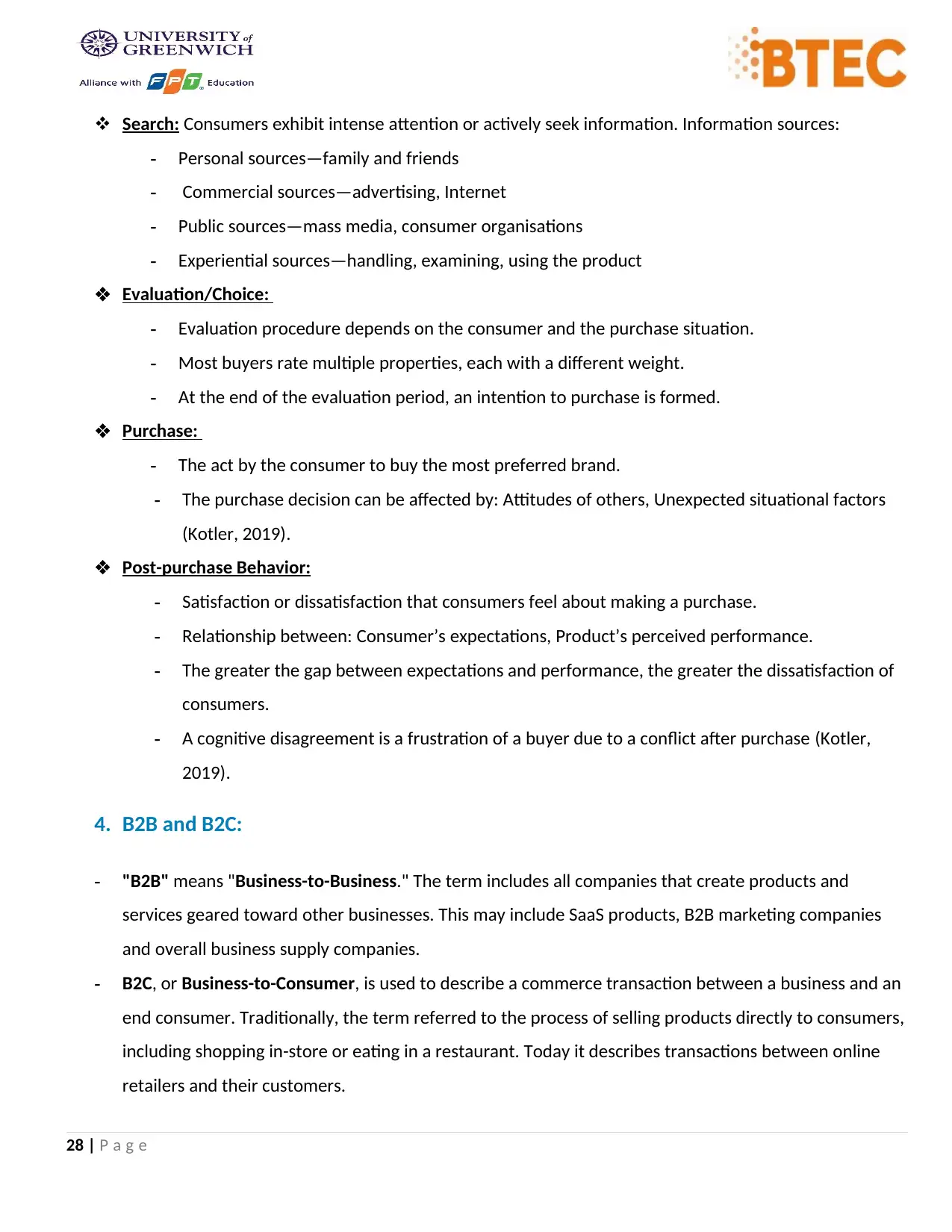
Search: Consumers exhibit intense attention or actively seek information. Information sources:
- Personal sources—family and friends
- Commercial sources—advertising, Internet
- Public sources—mass media, consumer organisations
- Experiential sources—handling, examining, using the product
Evaluation/Choice:
- Evaluation procedure depends on the consumer and the purchase situation.
- Most buyers rate multiple properties, each with a different weight.
- At the end of the evaluation period, an intention to purchase is formed.
Purchase:
- The act by the consumer to buy the most preferred brand.
- The purchase decision can be affected by: Attitudes of others, Unexpected situational factors
(Kotler, 2019).
Post-purchase Behavior:
- Satisfaction or dissatisfaction that consumers feel about making a purchase.
- Relationship between: Consumer’s expectations, Product’s perceived performance.
- The greater the gap between expectations and performance, the greater the dissatisfaction of
consumers.
- A cognitive disagreement is a frustration of a buyer due to a conflict after purchase (Kotler,
2019).
4. B2B and B2C:
- "B2B" means "Business-to-Business." The term includes all companies that create products and
services geared toward other businesses. This may include SaaS products, B2B marketing companies
and overall business supply companies.
- B2C, or Business-to-Consumer, is used to describe a commerce transaction between a business and an
end consumer. Traditionally, the term referred to the process of selling products directly to consumers,
including shopping in-store or eating in a restaurant. Today it describes transactions between online
retailers and their customers.
28 | P a g e
- Personal sources—family and friends
- Commercial sources—advertising, Internet
- Public sources—mass media, consumer organisations
- Experiential sources—handling, examining, using the product
Evaluation/Choice:
- Evaluation procedure depends on the consumer and the purchase situation.
- Most buyers rate multiple properties, each with a different weight.
- At the end of the evaluation period, an intention to purchase is formed.
Purchase:
- The act by the consumer to buy the most preferred brand.
- The purchase decision can be affected by: Attitudes of others, Unexpected situational factors
(Kotler, 2019).
Post-purchase Behavior:
- Satisfaction or dissatisfaction that consumers feel about making a purchase.
- Relationship between: Consumer’s expectations, Product’s perceived performance.
- The greater the gap between expectations and performance, the greater the dissatisfaction of
consumers.
- A cognitive disagreement is a frustration of a buyer due to a conflict after purchase (Kotler,
2019).
4. B2B and B2C:
- "B2B" means "Business-to-Business." The term includes all companies that create products and
services geared toward other businesses. This may include SaaS products, B2B marketing companies
and overall business supply companies.
- B2C, or Business-to-Consumer, is used to describe a commerce transaction between a business and an
end consumer. Traditionally, the term referred to the process of selling products directly to consumers,
including shopping in-store or eating in a restaurant. Today it describes transactions between online
retailers and their customers.
28 | P a g e
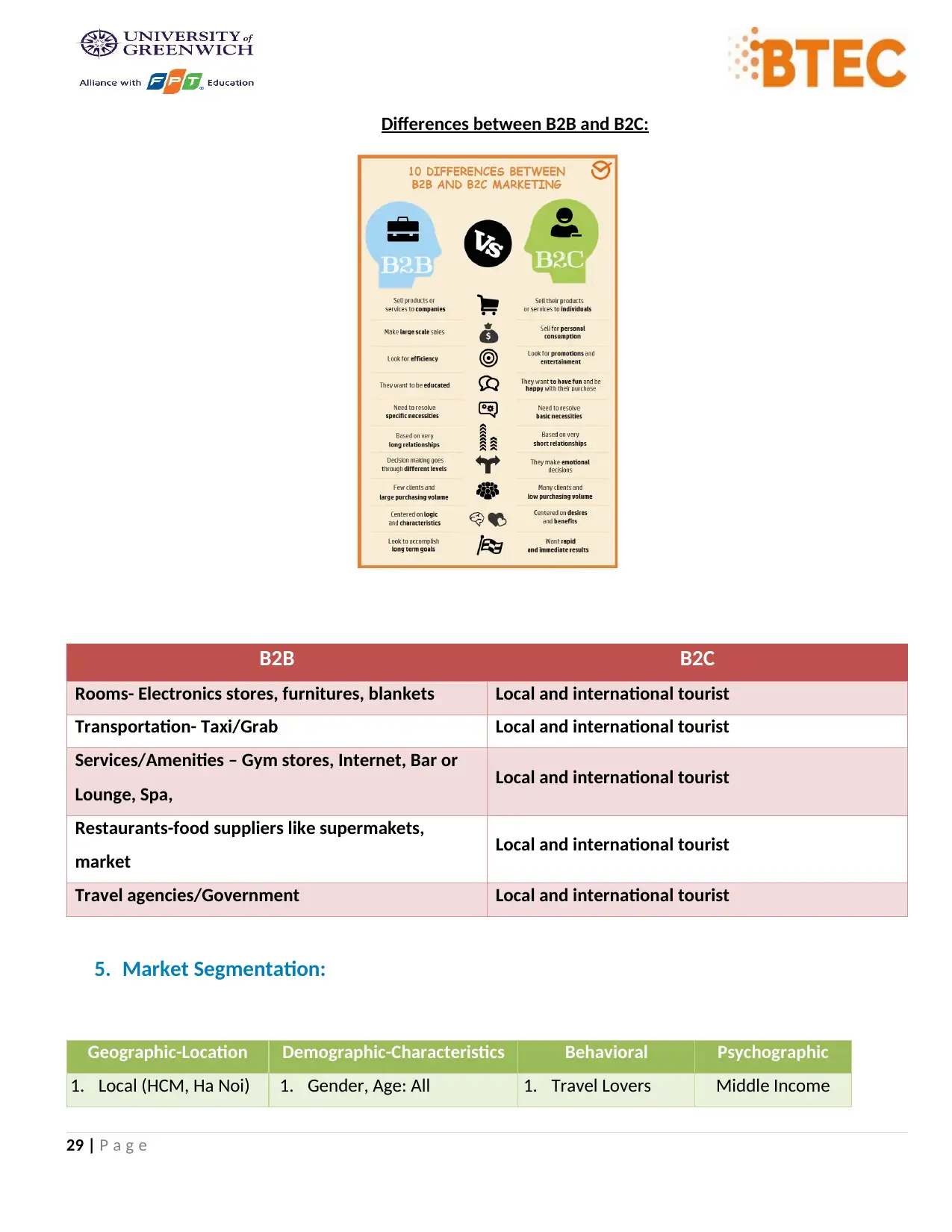
Differences between B2B and B2C:
B2B B2C
Rooms- Electronics stores, furnitures, blankets Local and international tourist
Transportation- Taxi/Grab Local and international tourist
Services/Amenities – Gym stores, Internet, Bar or
Lounge, Spa, Local and international tourist
Restaurants-food suppliers like supermakets,
market Local and international tourist
Travel agencies/Government Local and international tourist
5. Market Segmentation:
Geographic-Location Demographic-Characteristics Behavioral Psychographic
1. Local (HCM, Ha Noi) 1. Gender, Age: All 1. Travel Lovers Middle Income
29 | P a g e
B2B B2C
Rooms- Electronics stores, furnitures, blankets Local and international tourist
Transportation- Taxi/Grab Local and international tourist
Services/Amenities – Gym stores, Internet, Bar or
Lounge, Spa, Local and international tourist
Restaurants-food suppliers like supermakets,
market Local and international tourist
Travel agencies/Government Local and international tourist
5. Market Segmentation:
Geographic-Location Demographic-Characteristics Behavioral Psychographic
1. Local (HCM, Ha Noi) 1. Gender, Age: All 1. Travel Lovers Middle Income
29 | P a g e
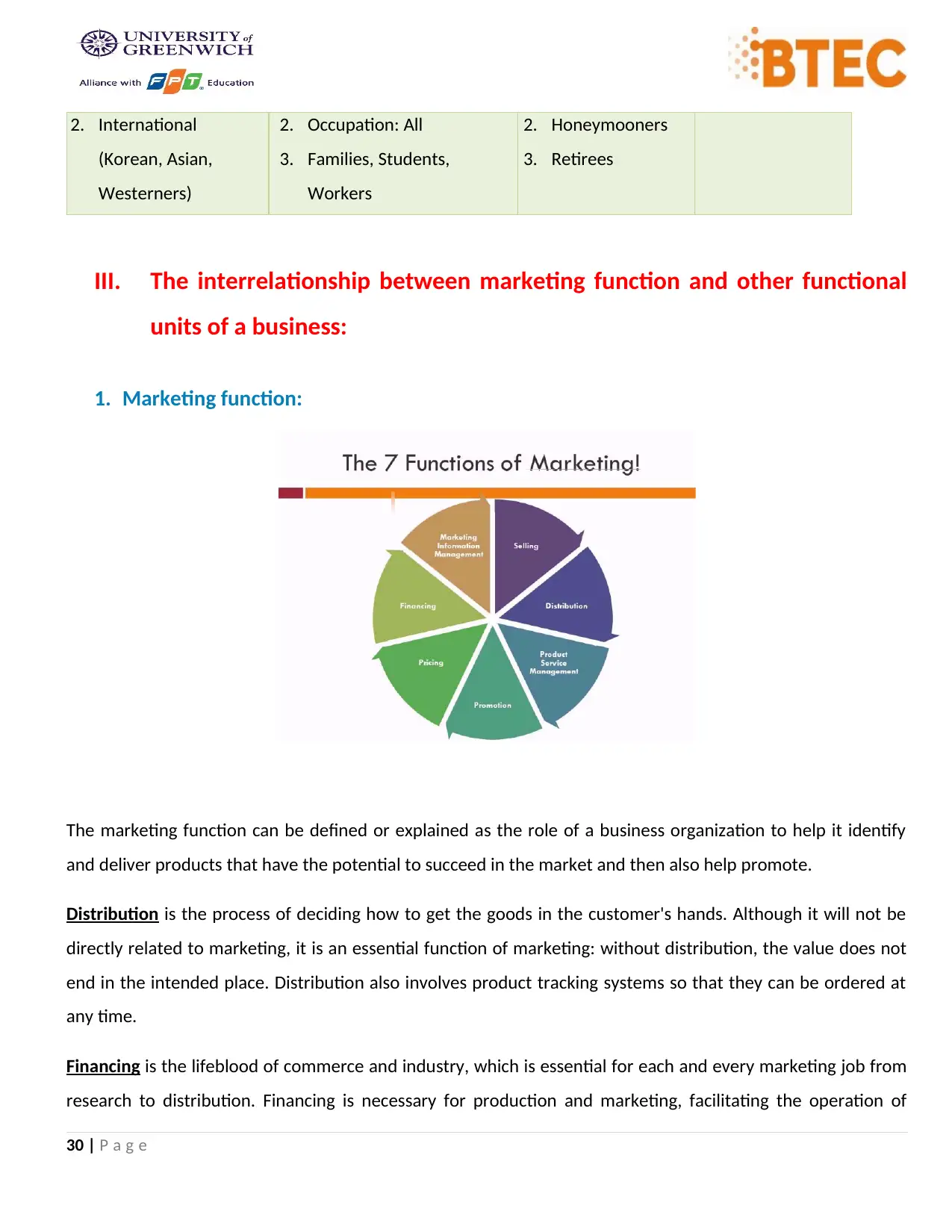
2. International
(Korean, Asian,
Westerners)
2. Occupation: All
3. Families, Students,
Workers
2. Honeymooners
3. Retirees
III. The interrelationship between marketing function and other functional
units of a business:
1. Marketing function:
The marketing function can be defined or explained as the role of a business organization to help it identify
and deliver products that have the potential to succeed in the market and then also help promote.
Distribution is the process of deciding how to get the goods in the customer's hands. Although it will not be
directly related to marketing, it is an essential function of marketing: without distribution, the value does not
end in the intended place. Distribution also involves product tracking systems so that they can be ordered at
any time.
Financing is the lifeblood of commerce and industry, which is essential for each and every marketing job from
research to distribution. Financing is necessary for production and marketing, facilitating the operation of
30 | P a g e
(Korean, Asian,
Westerners)
2. Occupation: All
3. Families, Students,
Workers
2. Honeymooners
3. Retirees
III. The interrelationship between marketing function and other functional
units of a business:
1. Marketing function:
The marketing function can be defined or explained as the role of a business organization to help it identify
and deliver products that have the potential to succeed in the market and then also help promote.
Distribution is the process of deciding how to get the goods in the customer's hands. Although it will not be
directly related to marketing, it is an essential function of marketing: without distribution, the value does not
end in the intended place. Distribution also involves product tracking systems so that they can be ordered at
any time.
Financing is the lifeblood of commerce and industry, which is essential for each and every marketing job from
research to distribution. Financing is necessary for production and marketing, facilitating the operation of
30 | P a g e
Paraphrase This Document
Need a fresh take? Get an instant paraphrase of this document with our AI Paraphraser

marketing processes and mechanisms. Businesses need some money for waiting time, which is what helps run
all the above activities until consumers pay. Businesses are able to meet demand through banking and other
financial assistance. The means by which these funds are provided are called financing.
Marketing Information Management is a group of activities including monitoring, analyzing and organizing
market data. It is often one of the functions of a marketing department that involves collecting and
researching relevant market data to design a company's strategies and plans (Thielin, 2020).
Pricing is one of the seven functions of marketing that can be found in the marketing mix. Pricing decisions
dictate the amount of fees charged for goods and services for profit. The cost, competitor price, and value
delivered to the customer can determine the price. Marketers today for most products need to determine the
number of customers willing to pay to determine the price (Thielin, 2020).
Product service management is a marketing function that focuses on developing a product or a service
according to how the market evolves. It involves a continuous evaluation of their attributes in order to
improve or change the items accordingly. To build the best possible product, product managers advocate for
customers within the organization and make sure the voice of the market is heard and heeded (Thielin, 2020).
Promotion is an effort to inform, persuade or remind potential customers about your business's products or
services. It can be said that promotion plays an important role in conveying value to customers, which makes it
part of the seven functions of marketing (Thielin, 2020).
Selling creates a key link between creating value and distributing value to customers. It can be said that it
reflects the change in value of ownership and offers customers the goods and services they want. Identifying
customer needs and wants and responding through personalized communication according to the plan are
considered sales techniques and activities. Making purchasing decisions and increasing future business
opportunities may affect the selling process (Thielin, 2020).
31 | P a g e
all the above activities until consumers pay. Businesses are able to meet demand through banking and other
financial assistance. The means by which these funds are provided are called financing.
Marketing Information Management is a group of activities including monitoring, analyzing and organizing
market data. It is often one of the functions of a marketing department that involves collecting and
researching relevant market data to design a company's strategies and plans (Thielin, 2020).
Pricing is one of the seven functions of marketing that can be found in the marketing mix. Pricing decisions
dictate the amount of fees charged for goods and services for profit. The cost, competitor price, and value
delivered to the customer can determine the price. Marketers today for most products need to determine the
number of customers willing to pay to determine the price (Thielin, 2020).
Product service management is a marketing function that focuses on developing a product or a service
according to how the market evolves. It involves a continuous evaluation of their attributes in order to
improve or change the items accordingly. To build the best possible product, product managers advocate for
customers within the organization and make sure the voice of the market is heard and heeded (Thielin, 2020).
Promotion is an effort to inform, persuade or remind potential customers about your business's products or
services. It can be said that promotion plays an important role in conveying value to customers, which makes it
part of the seven functions of marketing (Thielin, 2020).
Selling creates a key link between creating value and distributing value to customers. It can be said that it
reflects the change in value of ownership and offers customers the goods and services they want. Identifying
customer needs and wants and responding through personalized communication according to the plan are
considered sales techniques and activities. Making purchasing decisions and increasing future business
opportunities may affect the selling process (Thielin, 2020).
31 | P a g e
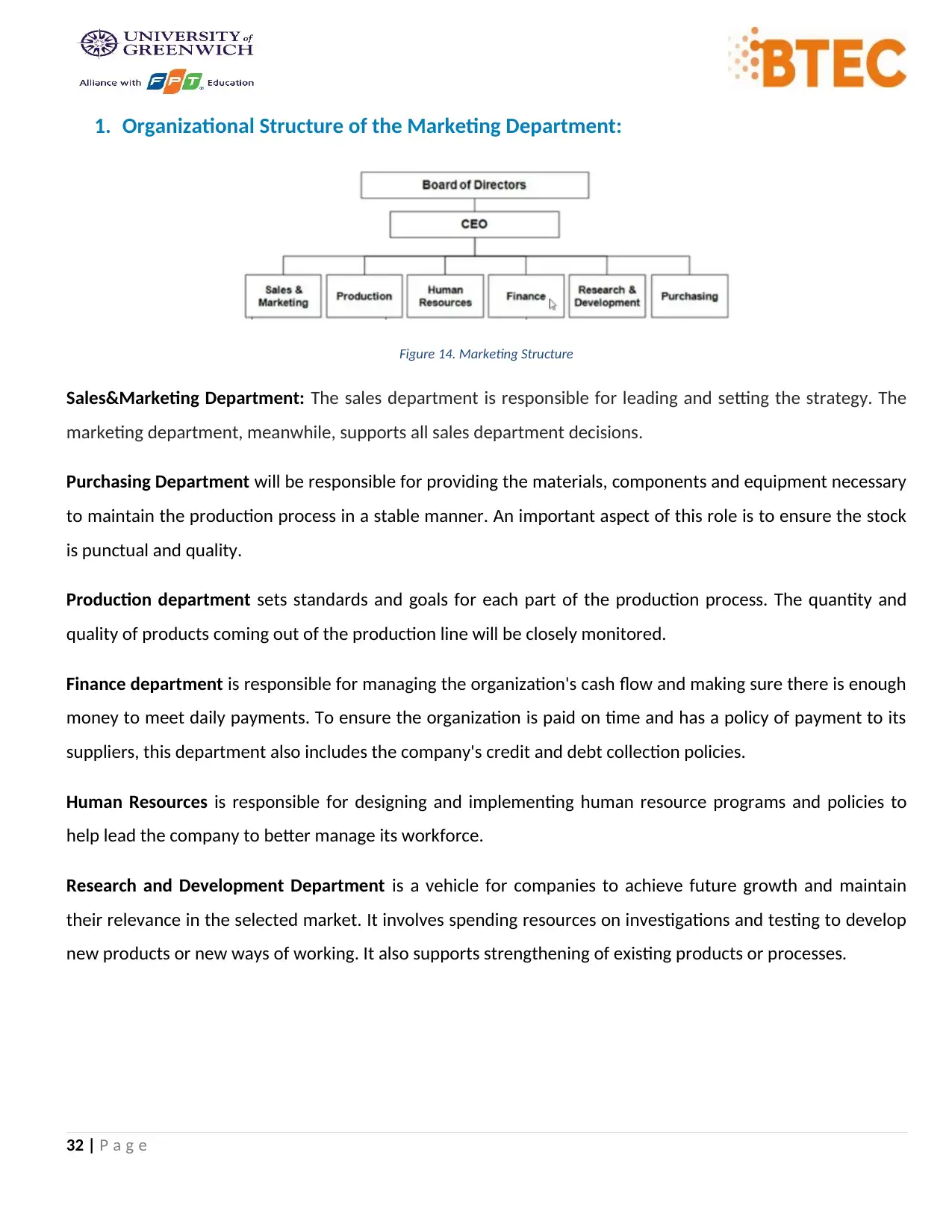
1. Organizational Structure of the Marketing Department:
Figure 14. Marketing Structure
Sales&Marketing Department: The sales department is responsible for leading and setting the strategy. The
marketing department, meanwhile, supports all sales department decisions.
Purchasing Department will be responsible for providing the materials, components and equipment necessary
to maintain the production process in a stable manner. An important aspect of this role is to ensure the stock
is punctual and quality.
Production department sets standards and goals for each part of the production process. The quantity and
quality of products coming out of the production line will be closely monitored.
Finance department is responsible for managing the organization's cash flow and making sure there is enough
money to meet daily payments. To ensure the organization is paid on time and has a policy of payment to its
suppliers, this department also includes the company's credit and debt collection policies.
Human Resources is responsible for designing and implementing human resource programs and policies to
help lead the company to better manage its workforce.
Research and Development Department is a vehicle for companies to achieve future growth and maintain
their relevance in the selected market. It involves spending resources on investigations and testing to develop
new products or new ways of working. It also supports strengthening of existing products or processes.
32 | P a g e
Figure 14. Marketing Structure
Sales&Marketing Department: The sales department is responsible for leading and setting the strategy. The
marketing department, meanwhile, supports all sales department decisions.
Purchasing Department will be responsible for providing the materials, components and equipment necessary
to maintain the production process in a stable manner. An important aspect of this role is to ensure the stock
is punctual and quality.
Production department sets standards and goals for each part of the production process. The quantity and
quality of products coming out of the production line will be closely monitored.
Finance department is responsible for managing the organization's cash flow and making sure there is enough
money to meet daily payments. To ensure the organization is paid on time and has a policy of payment to its
suppliers, this department also includes the company's credit and debt collection policies.
Human Resources is responsible for designing and implementing human resource programs and policies to
help lead the company to better manage its workforce.
Research and Development Department is a vehicle for companies to achieve future growth and maintain
their relevance in the selected market. It involves spending resources on investigations and testing to develop
new products or new ways of working. It also supports strengthening of existing products or processes.
32 | P a g e
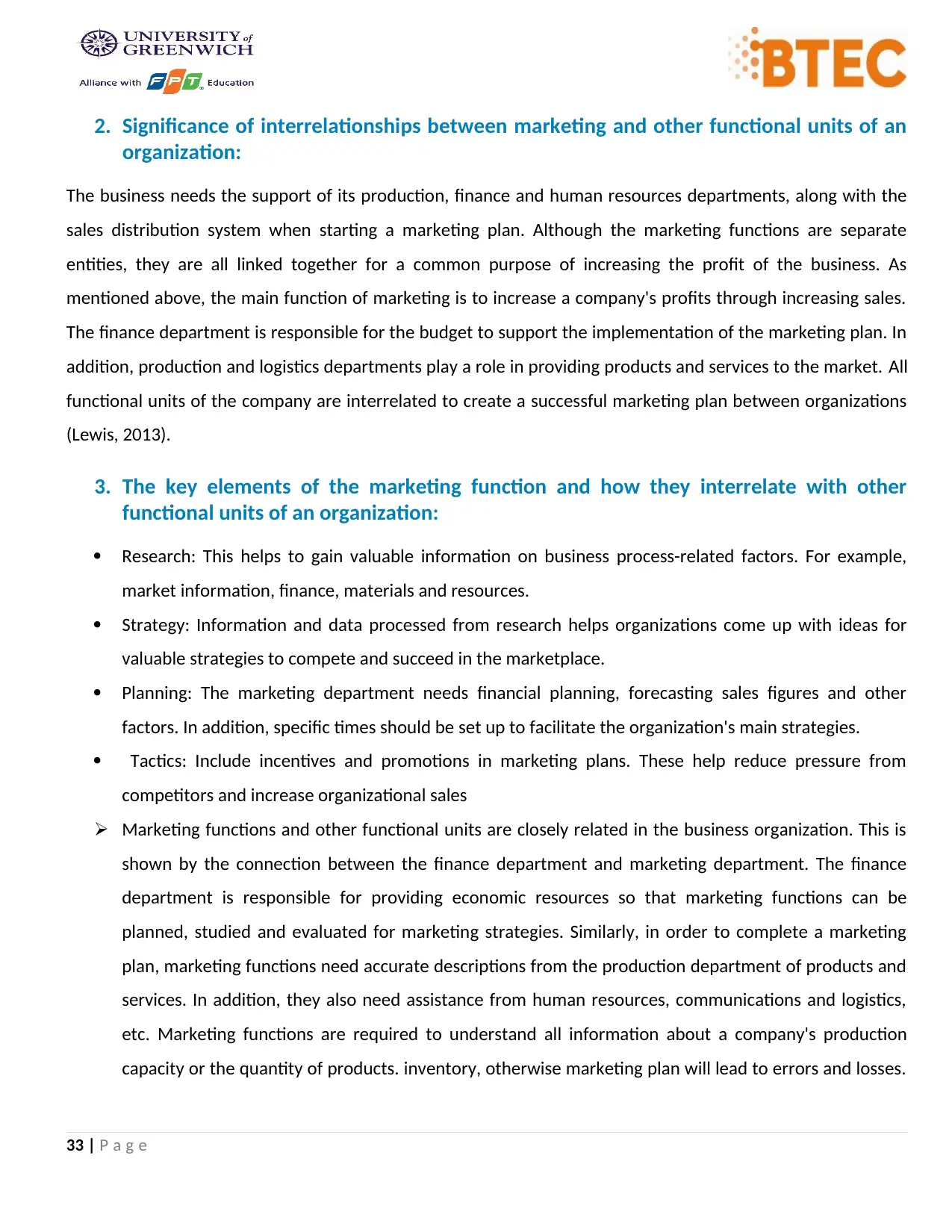
2. Significance of interrelationships between marketing and other functional units of an
organization:
The business needs the support of its production, finance and human resources departments, along with the
sales distribution system when starting a marketing plan. Although the marketing functions are separate
entities, they are all linked together for a common purpose of increasing the profit of the business. As
mentioned above, the main function of marketing is to increase a company's profits through increasing sales.
The finance department is responsible for the budget to support the implementation of the marketing plan. In
addition, production and logistics departments play a role in providing products and services to the market. All
functional units of the company are interrelated to create a successful marketing plan between organizations
(Lewis, 2013).
3. The key elements of the marketing function and how they interrelate with other
functional units of an organization:
Research: This helps to gain valuable information on business process-related factors. For example,
market information, finance, materials and resources.
Strategy: Information and data processed from research helps organizations come up with ideas for
valuable strategies to compete and succeed in the marketplace.
Planning: The marketing department needs financial planning, forecasting sales figures and other
factors. In addition, specific times should be set up to facilitate the organization's main strategies.
Tactics: Include incentives and promotions in marketing plans. These help reduce pressure from
competitors and increase organizational sales
Marketing functions and other functional units are closely related in the business organization. This is
shown by the connection between the finance department and marketing department. The finance
department is responsible for providing economic resources so that marketing functions can be
planned, studied and evaluated for marketing strategies. Similarly, in order to complete a marketing
plan, marketing functions need accurate descriptions from the production department of products and
services. In addition, they also need assistance from human resources, communications and logistics,
etc. Marketing functions are required to understand all information about a company's production
capacity or the quantity of products. inventory, otherwise marketing plan will lead to errors and losses.
33 | P a g e
organization:
The business needs the support of its production, finance and human resources departments, along with the
sales distribution system when starting a marketing plan. Although the marketing functions are separate
entities, they are all linked together for a common purpose of increasing the profit of the business. As
mentioned above, the main function of marketing is to increase a company's profits through increasing sales.
The finance department is responsible for the budget to support the implementation of the marketing plan. In
addition, production and logistics departments play a role in providing products and services to the market. All
functional units of the company are interrelated to create a successful marketing plan between organizations
(Lewis, 2013).
3. The key elements of the marketing function and how they interrelate with other
functional units of an organization:
Research: This helps to gain valuable information on business process-related factors. For example,
market information, finance, materials and resources.
Strategy: Information and data processed from research helps organizations come up with ideas for
valuable strategies to compete and succeed in the marketplace.
Planning: The marketing department needs financial planning, forecasting sales figures and other
factors. In addition, specific times should be set up to facilitate the organization's main strategies.
Tactics: Include incentives and promotions in marketing plans. These help reduce pressure from
competitors and increase organizational sales
Marketing functions and other functional units are closely related in the business organization. This is
shown by the connection between the finance department and marketing department. The finance
department is responsible for providing economic resources so that marketing functions can be
planned, studied and evaluated for marketing strategies. Similarly, in order to complete a marketing
plan, marketing functions need accurate descriptions from the production department of products and
services. In addition, they also need assistance from human resources, communications and logistics,
etc. Marketing functions are required to understand all information about a company's production
capacity or the quantity of products. inventory, otherwise marketing plan will lead to errors and losses.
33 | P a g e
Secure Best Marks with AI Grader
Need help grading? Try our AI Grader for instant feedback on your assignments.
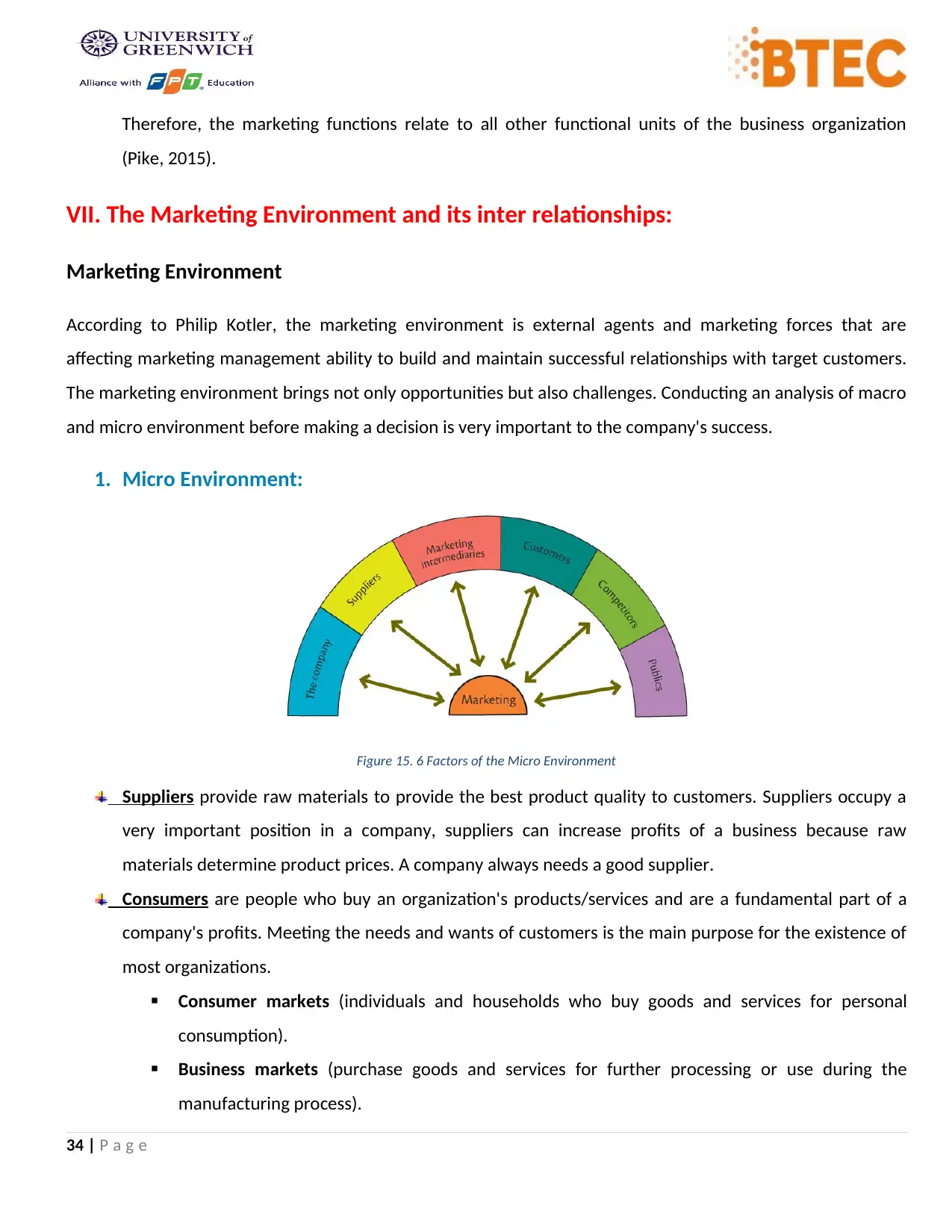
Therefore, the marketing functions relate to all other functional units of the business organization
(Pike, 2015).
VII. The Marketing Environment and its inter relationships:
Marketing Environment
According to Philip Kotler, the marketing environment is external agents and marketing forces that are
affecting marketing management ability to build and maintain successful relationships with target customers.
The marketing environment brings not only opportunities but also challenges. Conducting an analysis of macro
and micro environment before making a decision is very important to the company's success.
1. Micro Environment:
Figure 15. 6 Factors of the Micro Environment
Suppliers provide raw materials to provide the best product quality to customers. Suppliers occupy a
very important position in a company, suppliers can increase profits of a business because raw
materials determine product prices. A company always needs a good supplier.
Consumers are people who buy an organization's products/services and are a fundamental part of a
company's profits. Meeting the needs and wants of customers is the main purpose for the existence of
most organizations.
Consumer markets (individuals and households who buy goods and services for personal
consumption).
Business markets (purchase goods and services for further processing or use during the
manufacturing process).
34 | P a g e
(Pike, 2015).
VII. The Marketing Environment and its inter relationships:
Marketing Environment
According to Philip Kotler, the marketing environment is external agents and marketing forces that are
affecting marketing management ability to build and maintain successful relationships with target customers.
The marketing environment brings not only opportunities but also challenges. Conducting an analysis of macro
and micro environment before making a decision is very important to the company's success.
1. Micro Environment:
Figure 15. 6 Factors of the Micro Environment
Suppliers provide raw materials to provide the best product quality to customers. Suppliers occupy a
very important position in a company, suppliers can increase profits of a business because raw
materials determine product prices. A company always needs a good supplier.
Consumers are people who buy an organization's products/services and are a fundamental part of a
company's profits. Meeting the needs and wants of customers is the main purpose for the existence of
most organizations.
Consumer markets (individuals and households who buy goods and services for personal
consumption).
Business markets (purchase goods and services for further processing or use during the
manufacturing process).
34 | P a g e
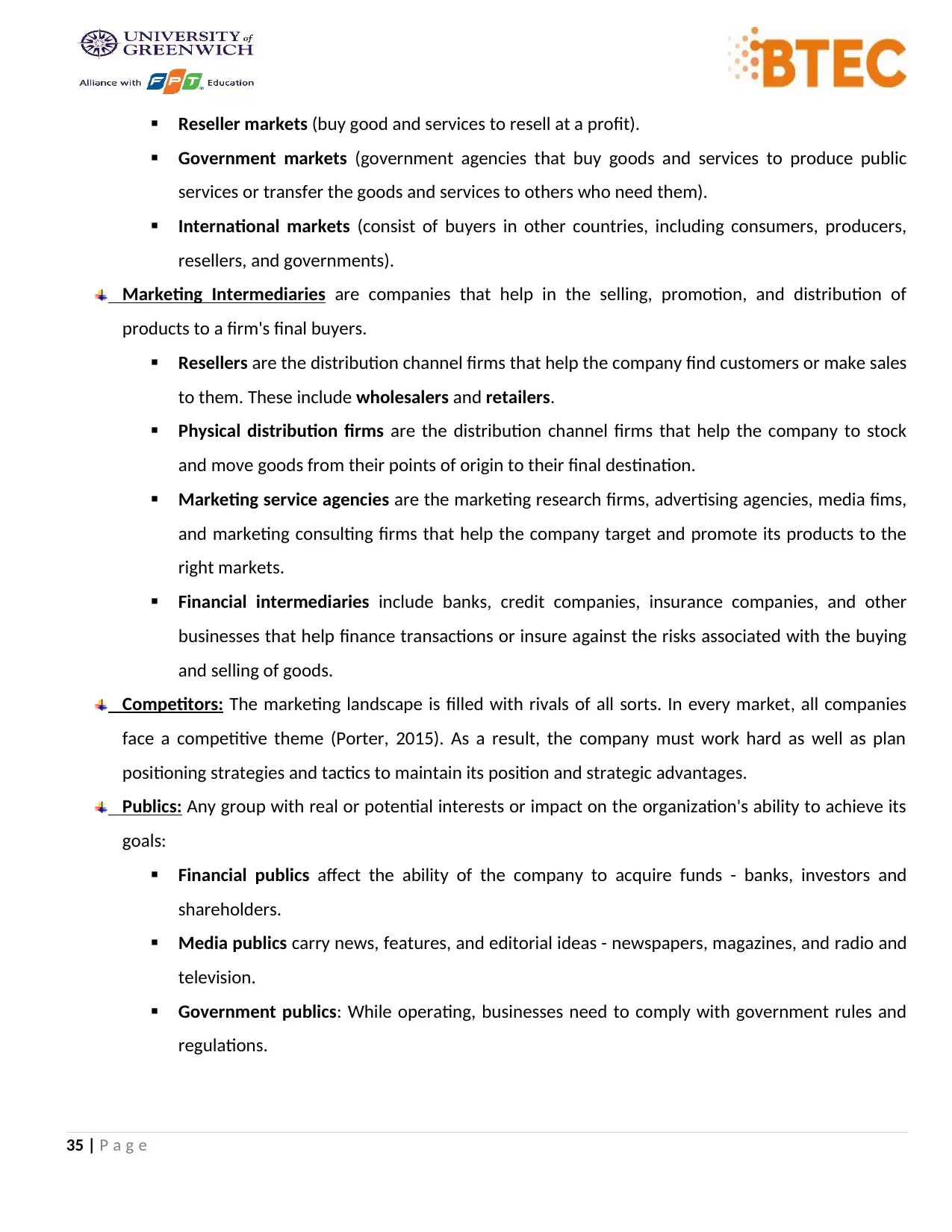
Reseller markets (buy good and services to resell at a profit).
Government markets (government agencies that buy goods and services to produce public
services or transfer the goods and services to others who need them).
International markets (consist of buyers in other countries, including consumers, producers,
resellers, and governments).
Marketing Intermediaries are companies that help in the selling, promotion, and distribution of
products to a firm's final buyers.
Resellers are the distribution channel firms that help the company find customers or make sales
to them. These include wholesalers and retailers.
Physical distribution firms are the distribution channel firms that help the company to stock
and move goods from their points of origin to their final destination.
Marketing service agencies are the marketing research firms, advertising agencies, media fims,
and marketing consulting firms that help the company target and promote its products to the
right markets.
Financial intermediaries include banks, credit companies, insurance companies, and other
businesses that help finance transactions or insure against the risks associated with the buying
and selling of goods.
Competitors: The marketing landscape is filled with rivals of all sorts. In every market, all companies
face a competitive theme (Porter, 2015). As a result, the company must work hard as well as plan
positioning strategies and tactics to maintain its position and strategic advantages.
Publics: Any group with real or potential interests or impact on the organization's ability to achieve its
goals:
Financial publics affect the ability of the company to acquire funds - banks, investors and
shareholders.
Media publics carry news, features, and editorial ideas - newspapers, magazines, and radio and
television.
Government publics: While operating, businesses need to comply with government rules and
regulations.
35 | P a g e
Government markets (government agencies that buy goods and services to produce public
services or transfer the goods and services to others who need them).
International markets (consist of buyers in other countries, including consumers, producers,
resellers, and governments).
Marketing Intermediaries are companies that help in the selling, promotion, and distribution of
products to a firm's final buyers.
Resellers are the distribution channel firms that help the company find customers or make sales
to them. These include wholesalers and retailers.
Physical distribution firms are the distribution channel firms that help the company to stock
and move goods from their points of origin to their final destination.
Marketing service agencies are the marketing research firms, advertising agencies, media fims,
and marketing consulting firms that help the company target and promote its products to the
right markets.
Financial intermediaries include banks, credit companies, insurance companies, and other
businesses that help finance transactions or insure against the risks associated with the buying
and selling of goods.
Competitors: The marketing landscape is filled with rivals of all sorts. In every market, all companies
face a competitive theme (Porter, 2015). As a result, the company must work hard as well as plan
positioning strategies and tactics to maintain its position and strategic advantages.
Publics: Any group with real or potential interests or impact on the organization's ability to achieve its
goals:
Financial publics affect the ability of the company to acquire funds - banks, investors and
shareholders.
Media publics carry news, features, and editorial ideas - newspapers, magazines, and radio and
television.
Government publics: While operating, businesses need to comply with government rules and
regulations.
35 | P a g e
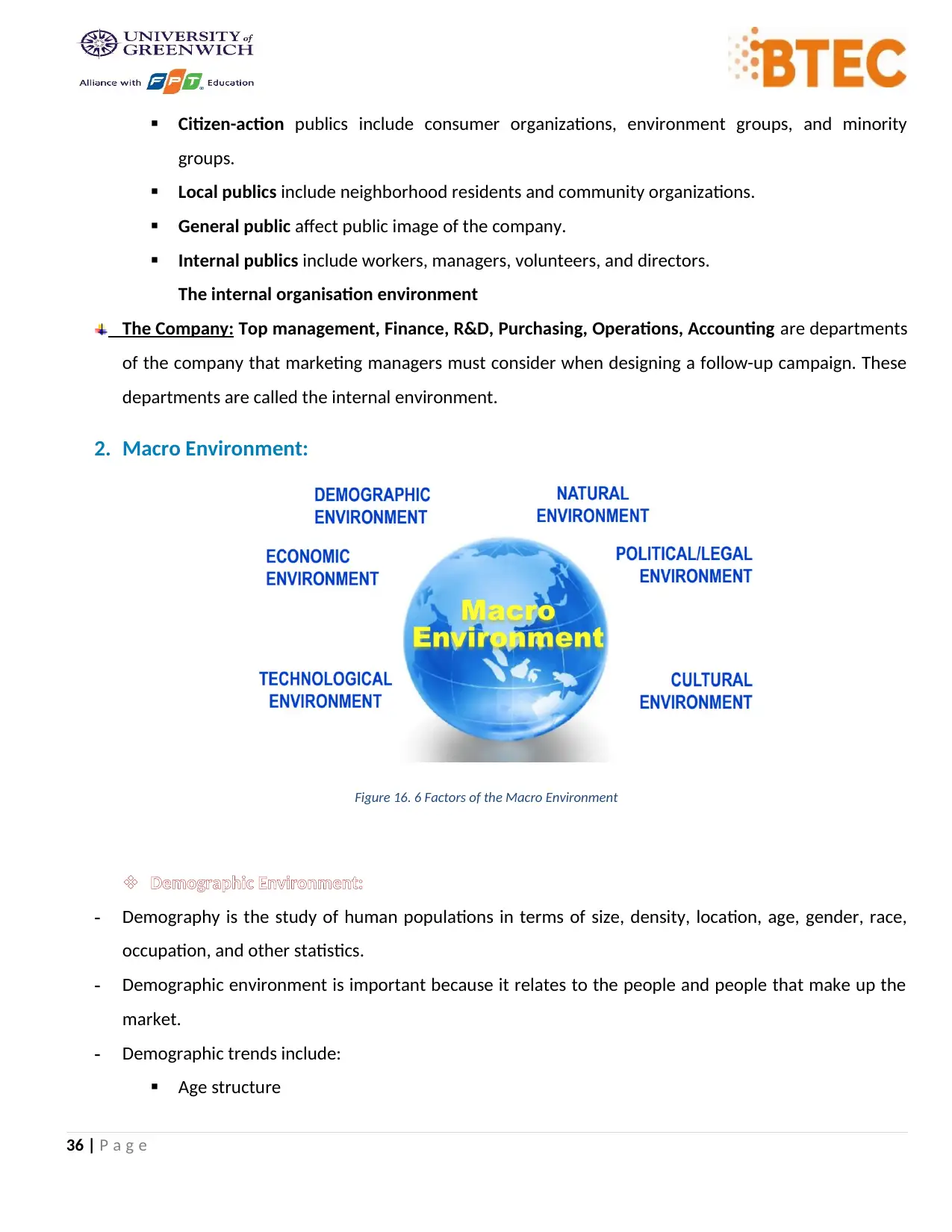
Citizen-action publics include consumer organizations, environment groups, and minority
groups.
Local publics include neighborhood residents and community organizations.
General public affect public image of the company.
Internal publics include workers, managers, volunteers, and directors.
The internal organisation environment
The Company: Top management, Finance, R&D, Purchasing, Operations, Accounting are departments
of the company that marketing managers must consider when designing a follow-up campaign. These
departments are called the internal environment.
2. Macro Environment:
Figure 16. 6 Factors of the Macro Environment
Demographic Environment:
- Demography is the study of human populations in terms of size, density, location, age, gender, race,
occupation, and other statistics.
- Demographic environment is important because it relates to the people and people that make up the
market.
- Demographic trends include:
Age structure
36 | P a g e
groups.
Local publics include neighborhood residents and community organizations.
General public affect public image of the company.
Internal publics include workers, managers, volunteers, and directors.
The internal organisation environment
The Company: Top management, Finance, R&D, Purchasing, Operations, Accounting are departments
of the company that marketing managers must consider when designing a follow-up campaign. These
departments are called the internal environment.
2. Macro Environment:
Figure 16. 6 Factors of the Macro Environment
Demographic Environment:
- Demography is the study of human populations in terms of size, density, location, age, gender, race,
occupation, and other statistics.
- Demographic environment is important because it relates to the people and people that make up the
market.
- Demographic trends include:
Age structure
36 | P a g e
Paraphrase This Document
Need a fresh take? Get an instant paraphrase of this document with our AI Paraphraser
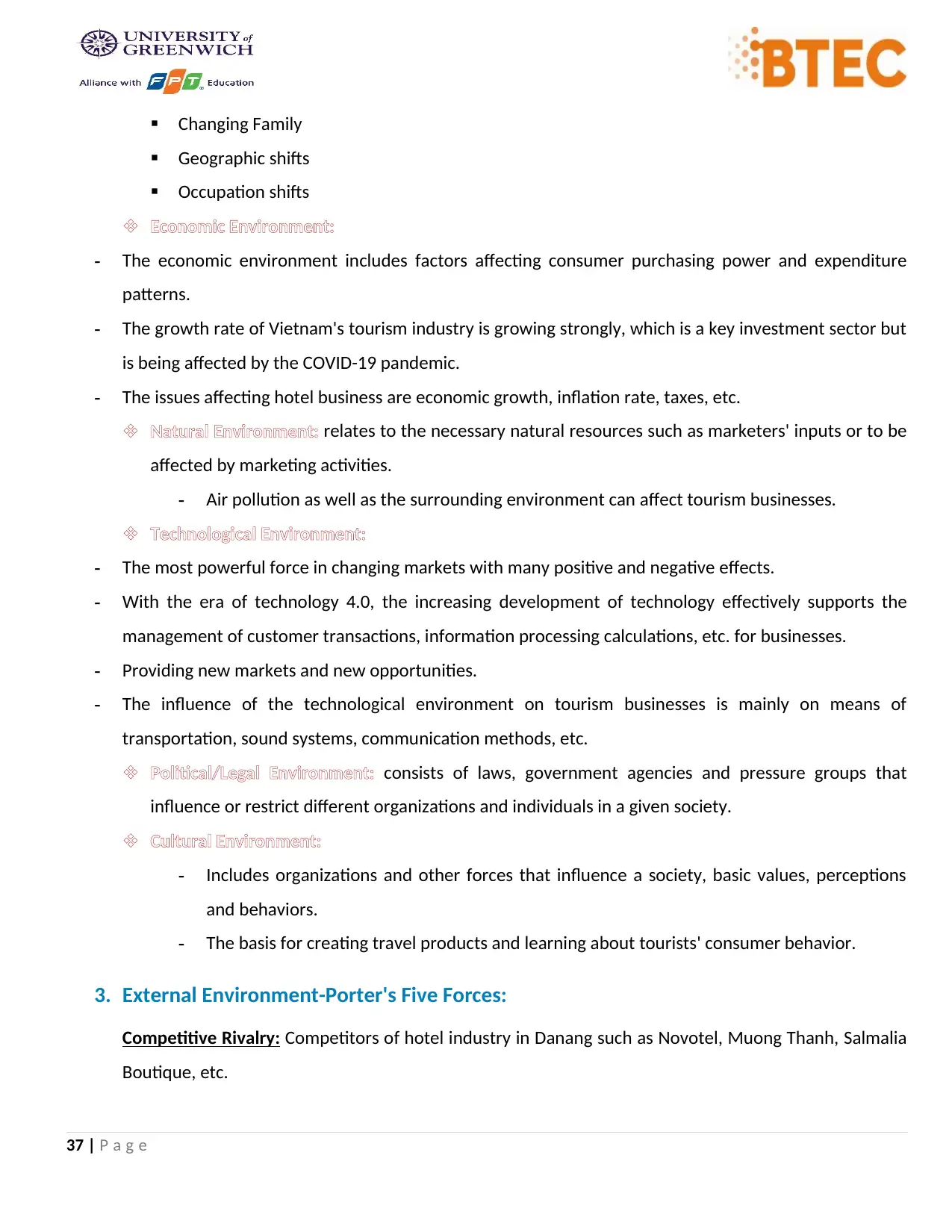
Changing Family
Geographic shifts
Occupation shifts
Economic Environment:
- The economic environment includes factors affecting consumer purchasing power and expenditure
patterns.
- The growth rate of Vietnam's tourism industry is growing strongly, which is a key investment sector but
is being affected by the COVID-19 pandemic.
- The issues affecting hotel business are economic growth, inflation rate, taxes, etc.
Natural Environment: relates to the necessary natural resources such as marketers' inputs or to be
affected by marketing activities.
- Air pollution as well as the surrounding environment can affect tourism businesses.
Technological Environment:
- The most powerful force in changing markets with many positive and negative effects.
- With the era of technology 4.0, the increasing development of technology effectively supports the
management of customer transactions, information processing calculations, etc. for businesses.
- Providing new markets and new opportunities.
- The influence of the technological environment on tourism businesses is mainly on means of
transportation, sound systems, communication methods, etc.
Political/Legal Environment: consists of laws, government agencies and pressure groups that
influence or restrict different organizations and individuals in a given society.
Cultural Environment:
- Includes organizations and other forces that influence a society, basic values, perceptions
and behaviors.
- The basis for creating travel products and learning about tourists' consumer behavior.
3. External Environment-Porter's Five Forces:
Competitive Rivalry: Competitors of hotel industry in Danang such as Novotel, Muong Thanh, Salmalia
Boutique, etc.
37 | P a g e
Geographic shifts
Occupation shifts
Economic Environment:
- The economic environment includes factors affecting consumer purchasing power and expenditure
patterns.
- The growth rate of Vietnam's tourism industry is growing strongly, which is a key investment sector but
is being affected by the COVID-19 pandemic.
- The issues affecting hotel business are economic growth, inflation rate, taxes, etc.
Natural Environment: relates to the necessary natural resources such as marketers' inputs or to be
affected by marketing activities.
- Air pollution as well as the surrounding environment can affect tourism businesses.
Technological Environment:
- The most powerful force in changing markets with many positive and negative effects.
- With the era of technology 4.0, the increasing development of technology effectively supports the
management of customer transactions, information processing calculations, etc. for businesses.
- Providing new markets and new opportunities.
- The influence of the technological environment on tourism businesses is mainly on means of
transportation, sound systems, communication methods, etc.
Political/Legal Environment: consists of laws, government agencies and pressure groups that
influence or restrict different organizations and individuals in a given society.
Cultural Environment:
- Includes organizations and other forces that influence a society, basic values, perceptions
and behaviors.
- The basis for creating travel products and learning about tourists' consumer behavior.
3. External Environment-Porter's Five Forces:
Competitive Rivalry: Competitors of hotel industry in Danang such as Novotel, Muong Thanh, Salmalia
Boutique, etc.
37 | P a g e
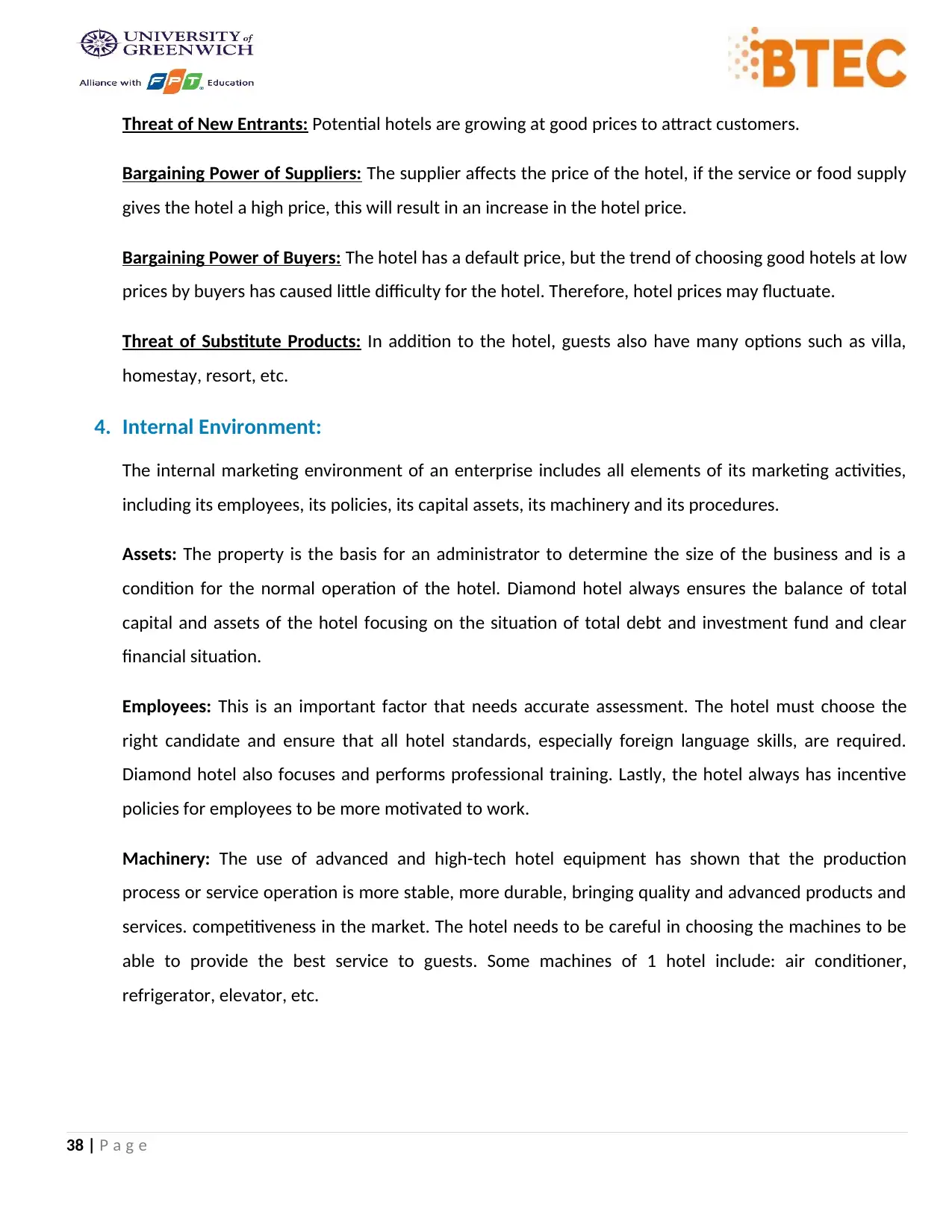
Threat of New Entrants: Potential hotels are growing at good prices to attract customers.
Bargaining Power of Suppliers: The supplier affects the price of the hotel, if the service or food supply
gives the hotel a high price, this will result in an increase in the hotel price.
Bargaining Power of Buyers: The hotel has a default price, but the trend of choosing good hotels at low
prices by buyers has caused little difficulty for the hotel. Therefore, hotel prices may fluctuate.
Threat of Substitute Products: In addition to the hotel, guests also have many options such as villa,
homestay, resort, etc.
4. Internal Environment:
The internal marketing environment of an enterprise includes all elements of its marketing activities,
including its employees, its policies, its capital assets, its machinery and its procedures.
Assets: The property is the basis for an administrator to determine the size of the business and is a
condition for the normal operation of the hotel. Diamond hotel always ensures the balance of total
capital and assets of the hotel focusing on the situation of total debt and investment fund and clear
financial situation.
Employees: This is an important factor that needs accurate assessment. The hotel must choose the
right candidate and ensure that all hotel standards, especially foreign language skills, are required.
Diamond hotel also focuses and performs professional training. Lastly, the hotel always has incentive
policies for employees to be more motivated to work.
Machinery: The use of advanced and high-tech hotel equipment has shown that the production
process or service operation is more stable, more durable, bringing quality and advanced products and
services. competitiveness in the market. The hotel needs to be careful in choosing the machines to be
able to provide the best service to guests. Some machines of 1 hotel include: air conditioner,
refrigerator, elevator, etc.
38 | P a g e
Bargaining Power of Suppliers: The supplier affects the price of the hotel, if the service or food supply
gives the hotel a high price, this will result in an increase in the hotel price.
Bargaining Power of Buyers: The hotel has a default price, but the trend of choosing good hotels at low
prices by buyers has caused little difficulty for the hotel. Therefore, hotel prices may fluctuate.
Threat of Substitute Products: In addition to the hotel, guests also have many options such as villa,
homestay, resort, etc.
4. Internal Environment:
The internal marketing environment of an enterprise includes all elements of its marketing activities,
including its employees, its policies, its capital assets, its machinery and its procedures.
Assets: The property is the basis for an administrator to determine the size of the business and is a
condition for the normal operation of the hotel. Diamond hotel always ensures the balance of total
capital and assets of the hotel focusing on the situation of total debt and investment fund and clear
financial situation.
Employees: This is an important factor that needs accurate assessment. The hotel must choose the
right candidate and ensure that all hotel standards, especially foreign language skills, are required.
Diamond hotel also focuses and performs professional training. Lastly, the hotel always has incentive
policies for employees to be more motivated to work.
Machinery: The use of advanced and high-tech hotel equipment has shown that the production
process or service operation is more stable, more durable, bringing quality and advanced products and
services. competitiveness in the market. The hotel needs to be careful in choosing the machines to be
able to provide the best service to guests. Some machines of 1 hotel include: air conditioner,
refrigerator, elevator, etc.
38 | P a g e
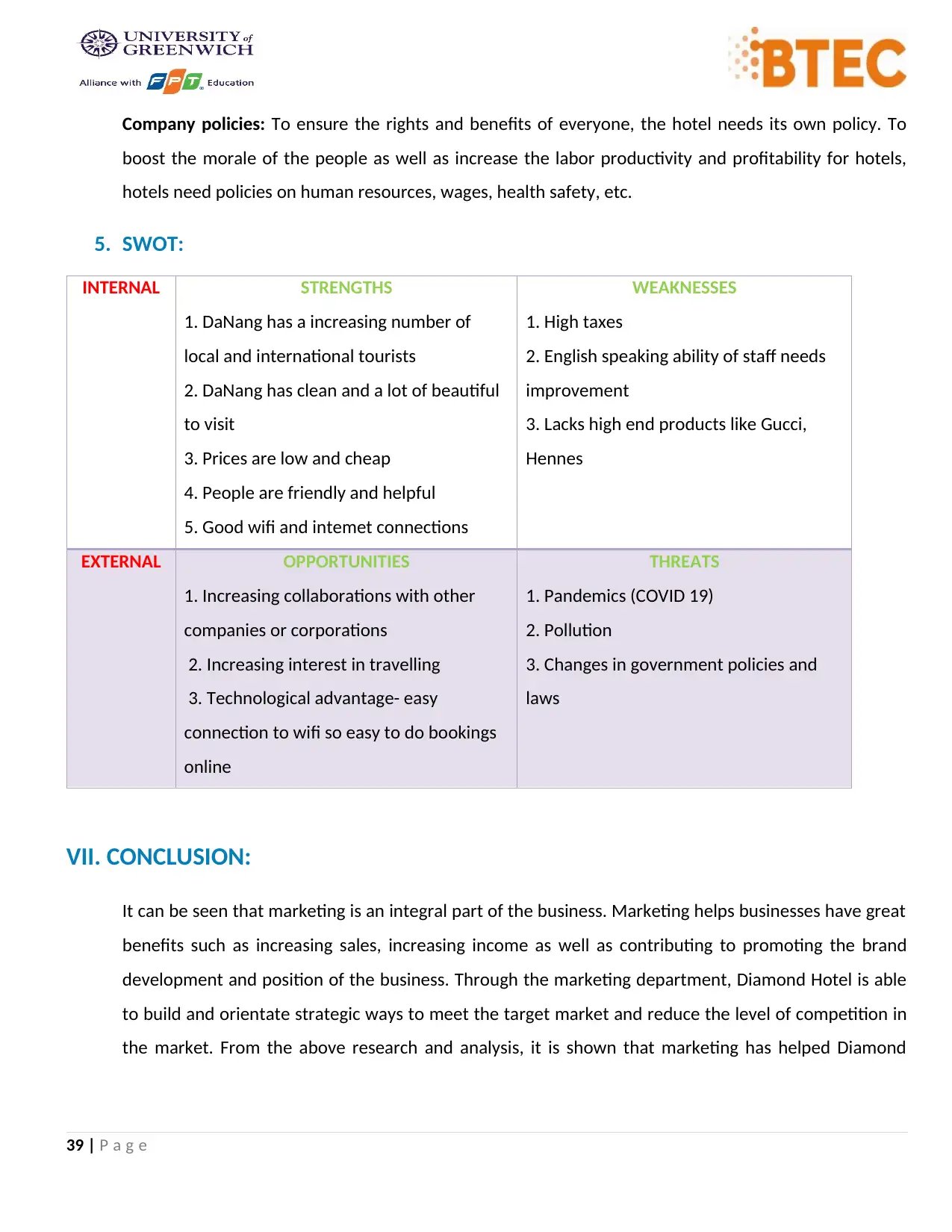
Company policies: To ensure the rights and benefits of everyone, the hotel needs its own policy. To
boost the morale of the people as well as increase the labor productivity and profitability for hotels,
hotels need policies on human resources, wages, health safety, etc.
5. SWOT:
INTERNAL STRENGTHS
1. DaNang has a increasing number of
local and international tourists
2. DaNang has clean and a lot of beautiful
to visit
3. Prices are low and cheap
4. People are friendly and helpful
5. Good wifi and intemet connections
WEAKNESSES
1. High taxes
2. English speaking ability of staff needs
improvement
3. Lacks high end products like Gucci,
Hennes
EXTERNAL OPPORTUNITIES
1. Increasing collaborations with other
companies or corporations
2. Increasing interest in travelling
3. Technological advantage- easy
connection to wifi so easy to do bookings
online
THREATS
1. Pandemics (COVID 19)
2. Pollution
3. Changes in government policies and
laws
VII. CONCLUSION:
It can be seen that marketing is an integral part of the business. Marketing helps businesses have great
benefits such as increasing sales, increasing income as well as contributing to promoting the brand
development and position of the business. Through the marketing department, Diamond Hotel is able
to build and orientate strategic ways to meet the target market and reduce the level of competition in
the market. From the above research and analysis, it is shown that marketing has helped Diamond
39 | P a g e
boost the morale of the people as well as increase the labor productivity and profitability for hotels,
hotels need policies on human resources, wages, health safety, etc.
5. SWOT:
INTERNAL STRENGTHS
1. DaNang has a increasing number of
local and international tourists
2. DaNang has clean and a lot of beautiful
to visit
3. Prices are low and cheap
4. People are friendly and helpful
5. Good wifi and intemet connections
WEAKNESSES
1. High taxes
2. English speaking ability of staff needs
improvement
3. Lacks high end products like Gucci,
Hennes
EXTERNAL OPPORTUNITIES
1. Increasing collaborations with other
companies or corporations
2. Increasing interest in travelling
3. Technological advantage- easy
connection to wifi so easy to do bookings
online
THREATS
1. Pandemics (COVID 19)
2. Pollution
3. Changes in government policies and
laws
VII. CONCLUSION:
It can be seen that marketing is an integral part of the business. Marketing helps businesses have great
benefits such as increasing sales, increasing income as well as contributing to promoting the brand
development and position of the business. Through the marketing department, Diamond Hotel is able
to build and orientate strategic ways to meet the target market and reduce the level of competition in
the market. From the above research and analysis, it is shown that marketing has helped Diamond
39 | P a g e
Secure Best Marks with AI Grader
Need help grading? Try our AI Grader for instant feedback on your assignments.
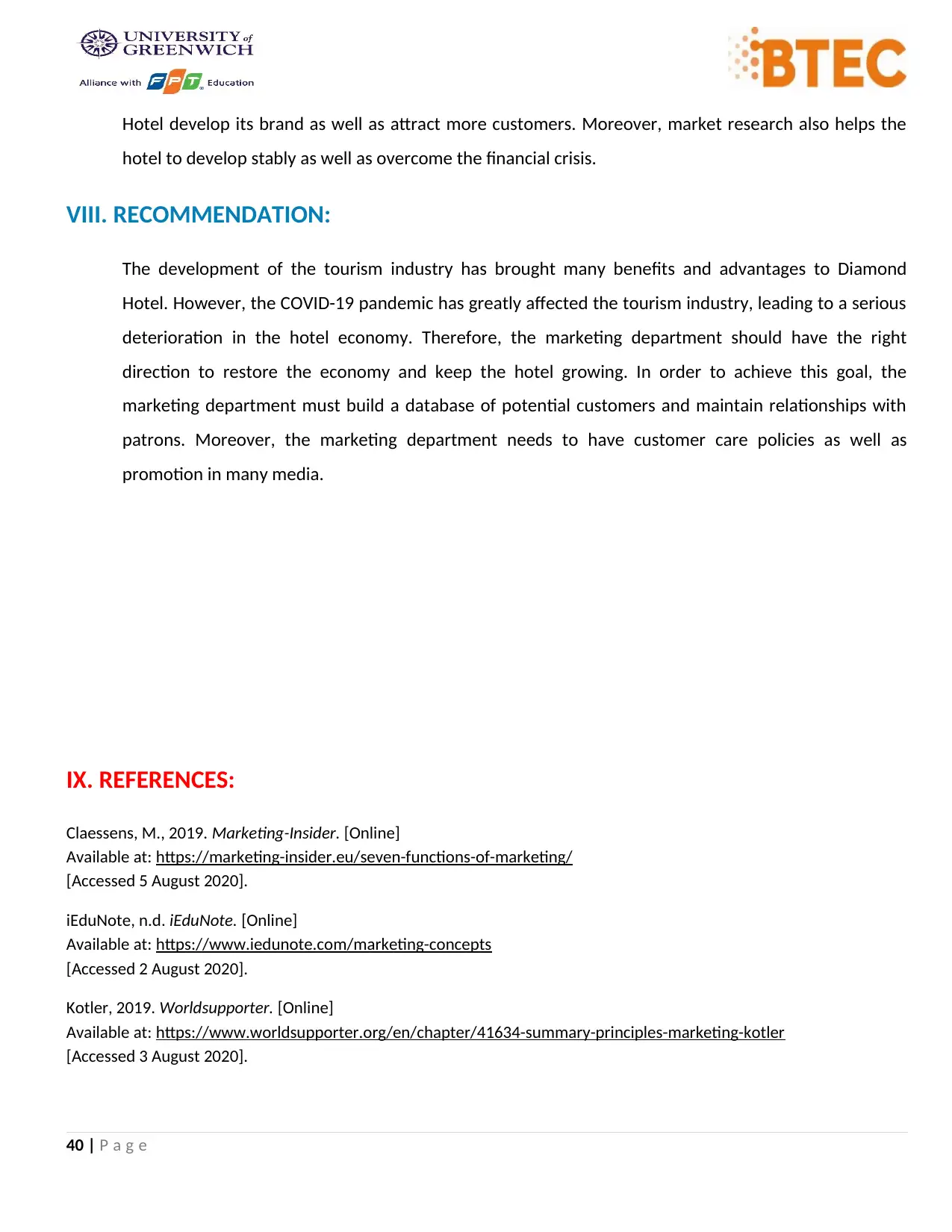
Hotel develop its brand as well as attract more customers. Moreover, market research also helps the
hotel to develop stably as well as overcome the financial crisis.
VIII. RECOMMENDATION:
The development of the tourism industry has brought many benefits and advantages to Diamond
Hotel. However, the COVID-19 pandemic has greatly affected the tourism industry, leading to a serious
deterioration in the hotel economy. Therefore, the marketing department should have the right
direction to restore the economy and keep the hotel growing. In order to achieve this goal, the
marketing department must build a database of potential customers and maintain relationships with
patrons. Moreover, the marketing department needs to have customer care policies as well as
promotion in many media.
IX. REFERENCES:
Claessens, M., 2019. Marketing-Insider. [Online]
Available at: https://marketing-insider.eu/seven-functions-of-marketing/
[Accessed 5 August 2020].
iEduNote, n.d. iEduNote. [Online]
Available at: https://www.iedunote.com/marketing-concepts
[Accessed 2 August 2020].
Kotler, 2019. Worldsupporter. [Online]
Available at: https://www.worldsupporter.org/en/chapter/41634-summary-principles-marketing-kotler
[Accessed 3 August 2020].
40 | P a g e
hotel to develop stably as well as overcome the financial crisis.
VIII. RECOMMENDATION:
The development of the tourism industry has brought many benefits and advantages to Diamond
Hotel. However, the COVID-19 pandemic has greatly affected the tourism industry, leading to a serious
deterioration in the hotel economy. Therefore, the marketing department should have the right
direction to restore the economy and keep the hotel growing. In order to achieve this goal, the
marketing department must build a database of potential customers and maintain relationships with
patrons. Moreover, the marketing department needs to have customer care policies as well as
promotion in many media.
IX. REFERENCES:
Claessens, M., 2019. Marketing-Insider. [Online]
Available at: https://marketing-insider.eu/seven-functions-of-marketing/
[Accessed 5 August 2020].
iEduNote, n.d. iEduNote. [Online]
Available at: https://www.iedunote.com/marketing-concepts
[Accessed 2 August 2020].
Kotler, 2019. Worldsupporter. [Online]
Available at: https://www.worldsupporter.org/en/chapter/41634-summary-principles-marketing-kotler
[Accessed 3 August 2020].
40 | P a g e

Kullabs, n.d. Kullabs. [Online]
Available at: https://www.kullabs.com/classes/subjects/units/lessons/notes/note-detail/7009
[Accessed 2 August 2020].
McLeod, S., 2020. Simplypsychology. [Online]
Available at: https://www.simplypsychology.org/maslow.html
[Accessed 4 August 2020].
Thielin, F., 2020. Hotelminder. [Online]
Available at: https://www.hotelminder.com/which-hotel-marketing-mix-best-suits-your-property
[Accessed 3 August 2020].
UNI, T., n.d. TOPICA UNI. [Online]
Available at:
http://eldata10.topica.edu.vn/HoclieuQT/MAR201/TaiLieuHuongDan/MAR201_TLHD_Chapter1.2.3_v1.1017110221.pdf
[Accessed 3 August 2020].
Claessens, M., 2019. Marketing-Insider. [Online]
Available at: https://marketing-insider.eu/seven-functions-of-marketing/
[Accessed 5 August 2020].
iEduNote, n.d. iEduNote. [Online]
Available at: https://www.iedunote.com/marketing-concepts
[Accessed 2 August 2020].
Kotler, 2019. Worldsupporter. [Online]
Available at: https://www.worldsupporter.org/en/chapter/41634-summary-principles-marketing-kotler
[Accessed 3 August 2020].
Kullabs, n.d. Kullabs. [Online]
Available at: https://www.kullabs.com/classes/subjects/units/lessons/notes/note-detail/7009
[Accessed 2 August 2020].
McLeod, S., 2020. Simplypsychology. [Online]
Available at: https://www.simplypsychology.org/maslow.html
[Accessed 4 August 2020].
Thielin, F., 2020. Hotelminder. [Online]
Available at: https://www.hotelminder.com/which-hotel-marketing-mix-best-suits-your-property
[Accessed 3 August 2020].
UNI, T., n.d. TOPICA UNI. [Online]
Available at:
41 | P a g e
Available at: https://www.kullabs.com/classes/subjects/units/lessons/notes/note-detail/7009
[Accessed 2 August 2020].
McLeod, S., 2020. Simplypsychology. [Online]
Available at: https://www.simplypsychology.org/maslow.html
[Accessed 4 August 2020].
Thielin, F., 2020. Hotelminder. [Online]
Available at: https://www.hotelminder.com/which-hotel-marketing-mix-best-suits-your-property
[Accessed 3 August 2020].
UNI, T., n.d. TOPICA UNI. [Online]
Available at:
http://eldata10.topica.edu.vn/HoclieuQT/MAR201/TaiLieuHuongDan/MAR201_TLHD_Chapter1.2.3_v1.1017110221.pdf
[Accessed 3 August 2020].
Claessens, M., 2019. Marketing-Insider. [Online]
Available at: https://marketing-insider.eu/seven-functions-of-marketing/
[Accessed 5 August 2020].
iEduNote, n.d. iEduNote. [Online]
Available at: https://www.iedunote.com/marketing-concepts
[Accessed 2 August 2020].
Kotler, 2019. Worldsupporter. [Online]
Available at: https://www.worldsupporter.org/en/chapter/41634-summary-principles-marketing-kotler
[Accessed 3 August 2020].
Kullabs, n.d. Kullabs. [Online]
Available at: https://www.kullabs.com/classes/subjects/units/lessons/notes/note-detail/7009
[Accessed 2 August 2020].
McLeod, S., 2020. Simplypsychology. [Online]
Available at: https://www.simplypsychology.org/maslow.html
[Accessed 4 August 2020].
Thielin, F., 2020. Hotelminder. [Online]
Available at: https://www.hotelminder.com/which-hotel-marketing-mix-best-suits-your-property
[Accessed 3 August 2020].
UNI, T., n.d. TOPICA UNI. [Online]
Available at:
41 | P a g e

http://eldata10.topica.edu.vn/HoclieuQT/MAR201/TaiLieuHuongDan/MAR201_TLHD_Chapter1.2.3_v1.1017110221.pdf
[Accessed 3 August 2020].
42 | P a g e
[Accessed 3 August 2020].
42 | P a g e
1 out of 43
Related Documents
Your All-in-One AI-Powered Toolkit for Academic Success.
+13062052269
info@desklib.com
Available 24*7 on WhatsApp / Email
![[object Object]](/_next/static/media/star-bottom.7253800d.svg)
Unlock your academic potential
© 2024 | Zucol Services PVT LTD | All rights reserved.





